It seems we can’t find what you’re looking for. Perhaps searching can help.
Sign Up for newsletter!
Subscribe to get the latest eBook!
Hotline






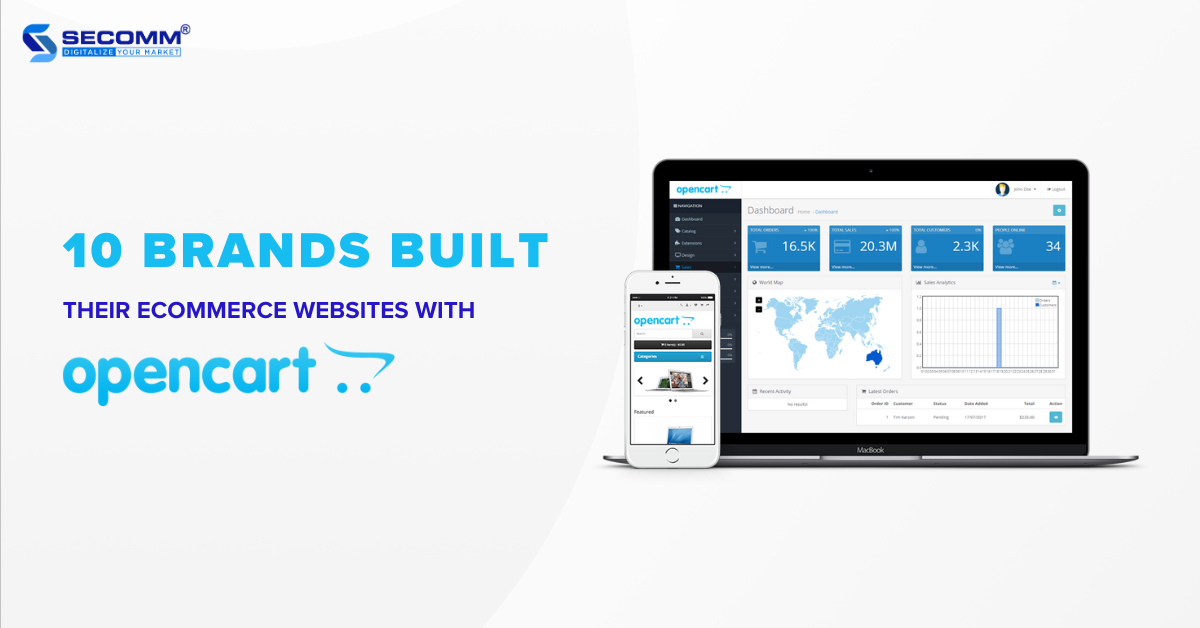
OpenCart is an open-source eCommerce platform based on the PHP programming language, utilizing the MySQL database and HTML components to build eCommerce websites. According to Builtwith, the platform powers over 2,500 websites, with the majority in the United States and Russia.
OpenCart offers businesses various options for building eCommerce websites: Free (Open Source) and Cloud Store (Paid). Due to the flexibility of open-source code, many businesses choose this platform to meet specialized requirements in website development.
Below are some brands that have used OpenCart to create dedicated eCommerce websites
Bensound is the brainchild of musician Benjamin Tissot, founded in 2012. It is an eCommerce website specializing in providing free and licensed music, as well as sound effects. Initially, Benjamin Tissot composed and licensed only his songs on this platform.
However, as the service grew, Benjamin Tissot started accepting musical works from other artists, making it an ideal destination for content creators on platforms like YouTube, Facebook, and Instagram.
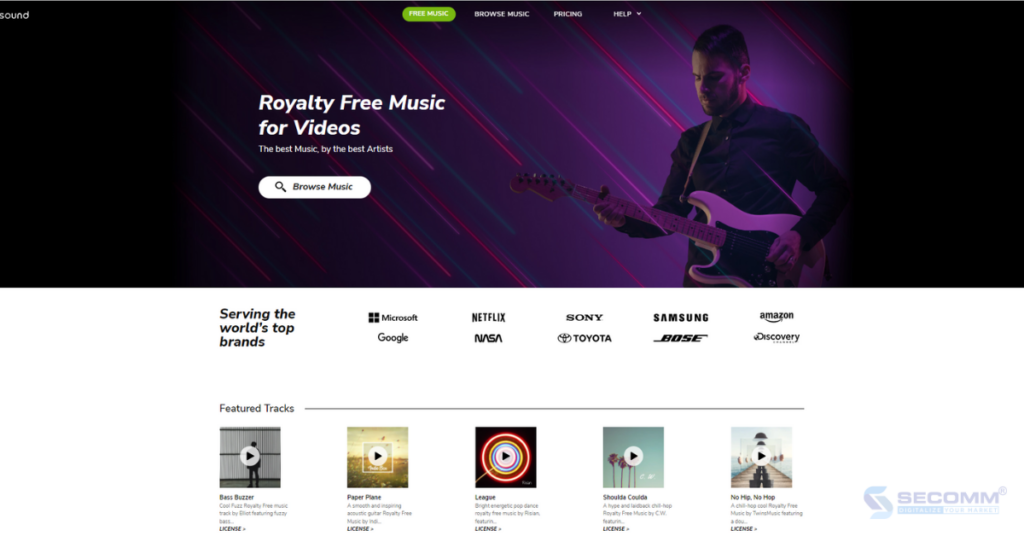
Vicrez is an online automotive parts retailer established in 2014 in the city of Whittier, Southern California, USA. What sets Vicrez apart is that customers can shop online for any external car parts and accessories to customize their vehicles according to their individual preferences.
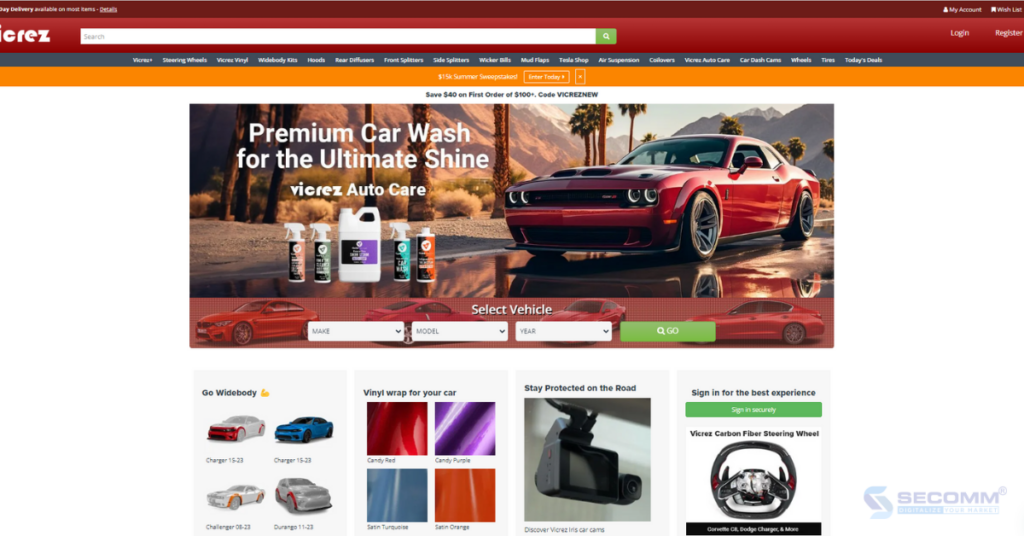
Pharmacy Direct is the first online pharmacy to follow the eCommerce model, owned and operated by pharmacists in Australia since 1996. Initially, the brand operated on a small scale, serving local customers. However, as the demand for health products in Australia steadily increased, Pharmacy Direct experienced remarkable growth.
The business invested more in its eCommerce website to offer over 17,000 products, including vitamins, supplements, beauty products, fragrances, childcare products, prescription medications, and over-the-counter medicines from reputable pharmaceutical brands. This expansion allowed Pharmacy Direct to provide online services to the Australian population.
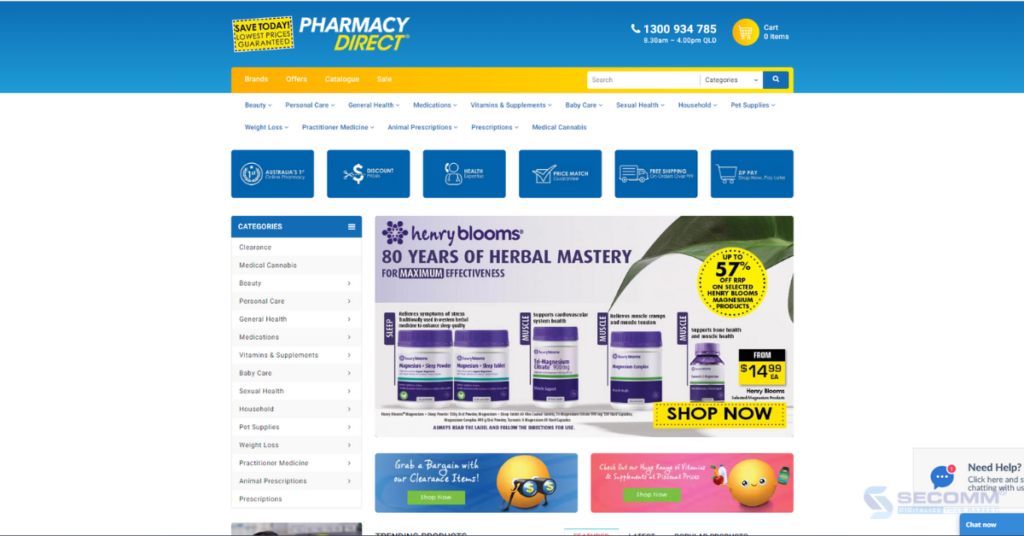
Get Laid Beds is a business specializing in handcrafting solid wood beds, founded in 2012 by John and Jean, a pair of architect and carpenter friends.
After more than 10 years of development, Get Laid Beds has expanded its product lines to include bedroom furniture, focusing on building its eCommerce website and enhancing customer service. This brand has gained popularity among customers in the UK and the US.
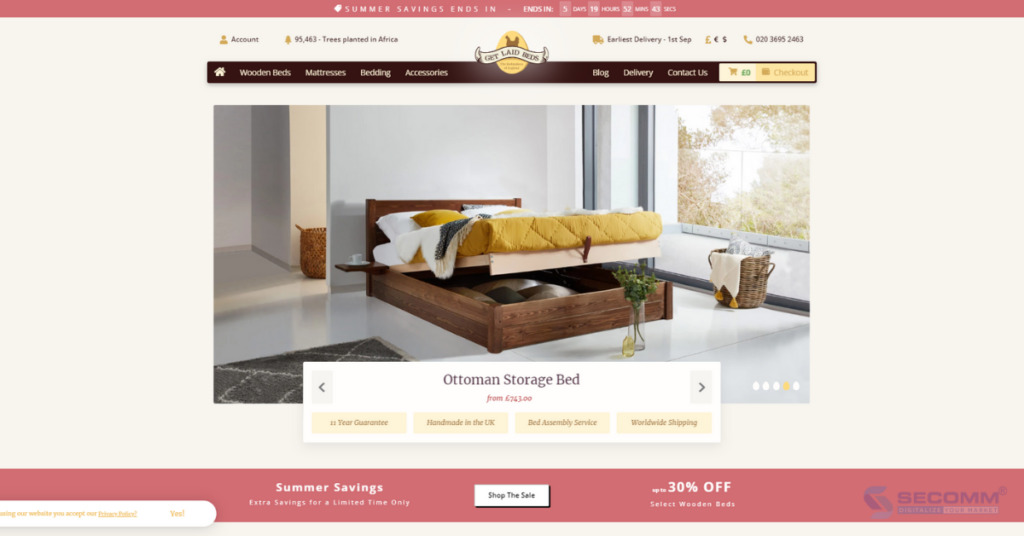
Self Edge is a men’s fashion brand with a vintage style, established in 2006 by the American couple Kiya and Demitra Babzani. Currently, Self Edge has a presence in major cities such as San Francisco, New York, Los Angeles, Portland, and San Jose del Cabo.
Additionally, Self Edge focuses on developing its eCommerce website to reach new customers across the United States and Mexico.

BNA Model World is a model business established in 2007 in Australia. Since its establishment, the brand’s management has focused on the eCommerce market and gradually upgraded its products/services. Currently, BNA Model World offers over 100,000 products from more than 1,000 manufacturers, serving over 104,000 customers worldwide.
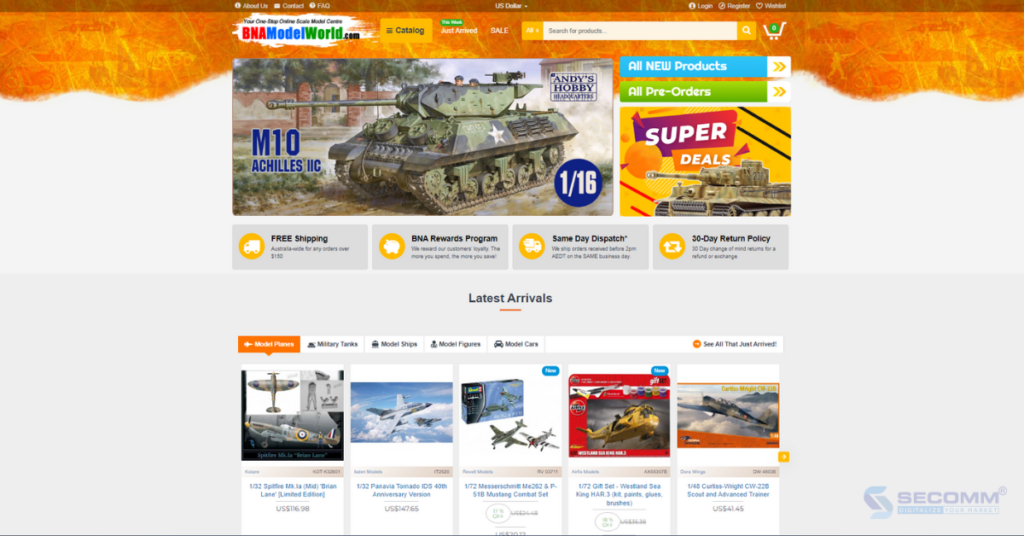
Godukkan is a consumer electronics retail business established in 2017 and headquartered in Dubai, United Arab Emirates (UAE). Godukkan’s main goal is to become the number one eCommerce website in the UAE, offering a wide range of products, including laptops, mobile phones, tablets, PCs, gaming equipment, and more.
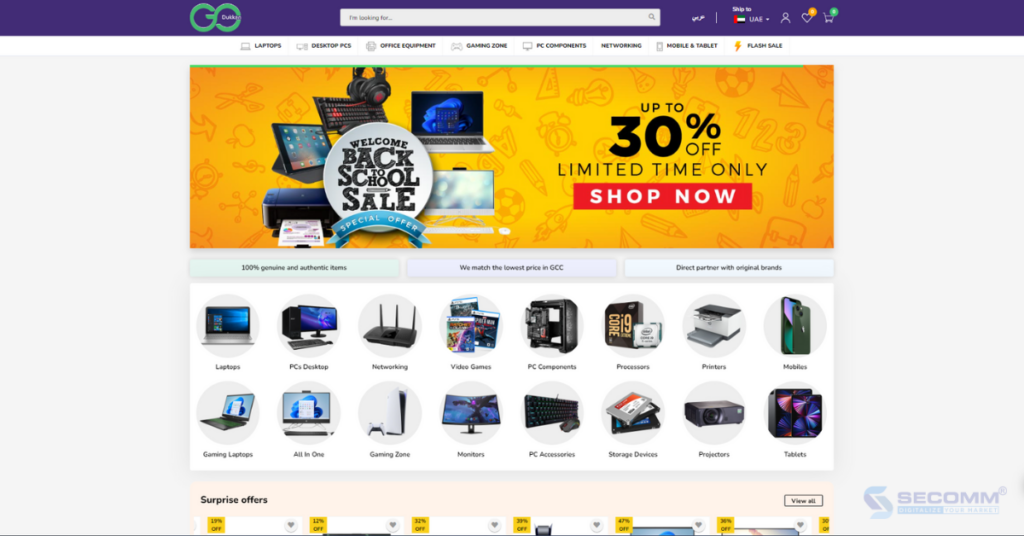
Get Er Brewed is a beverage brand specializing in brewing beer, wine, tea, etc., as well as supplying fermentation ingredients and brewing equipment. The business was established in 2013 and is based in Northern Ireland.
In recent years, Get Er Brewed has expanded its reach by launching an OpenCart website to cater to an international customer base, achieving certain successes, particularly in securing contracts for the installation of fermentation and brewing systems.
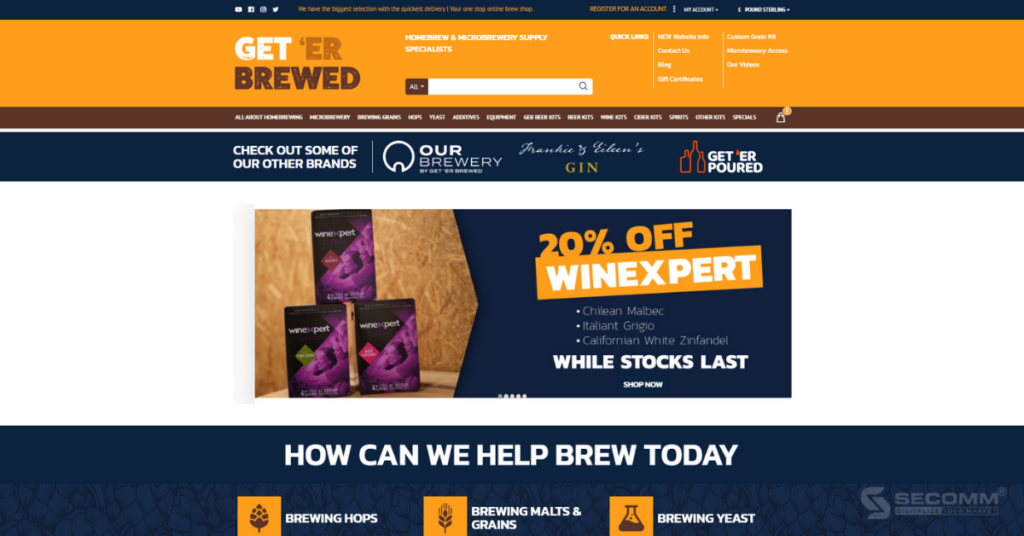
With over 20 years of experience in the pet industry, brothers Raymond and Roger decided to establish CatSmart, the largest cat-centric brand in Singapore. Currently, CatSmart is actively investing in its OpenCart website and expanding its presence beyond traditional retail branches in the “Lion City.”
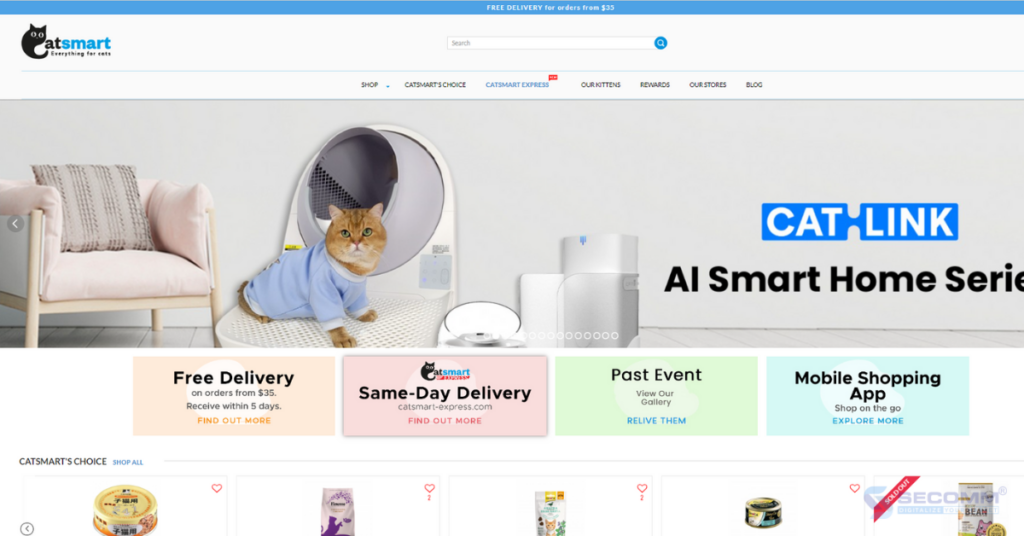
Derails is a business specializing in designing and selling model trains, established in 2010. With the boom of eCommerce, Derails began building an OpenCart website to adapt to the changing market.
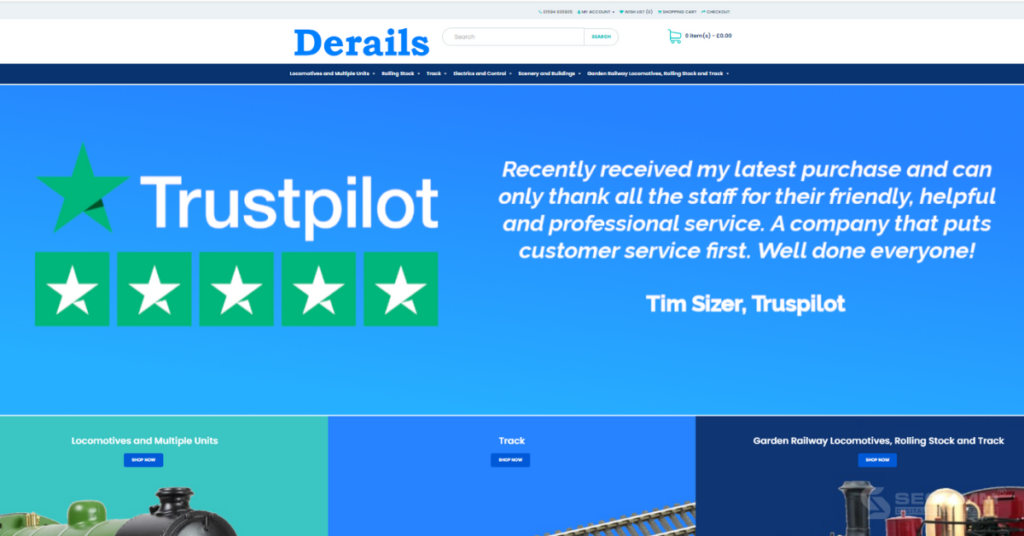
The Bottom Line
Here are 10 brands that have developed OpenCart websites and achieved success in both branding and revenue. This success serves as inspiration for other businesses seeking solutions to break through their operations and enhance competitiveness in the market.
Learn more: OpenCart vs Magento: Which Fits Your Business Best?
With extensive experience in deploying eCommerce for clients in many countries, SECOMM understands the difficulties and challenges that businesses face during implementation.
Contact SECOMM now or call the hotline at 02871089908 today for a free consultation.
 2
2
 10,502
10,502
 0
0
 1
1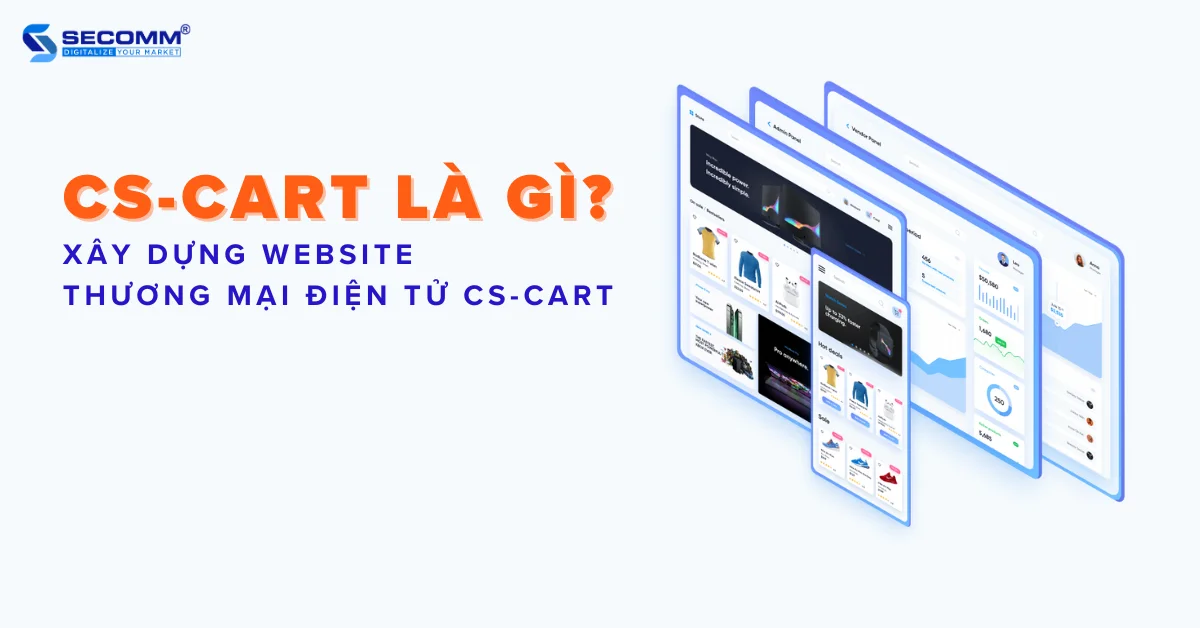
In the era of growing eCommerce, building an eCommerce website has become an essential part of how businesses approach and interact with customers. To successfully build and manage an online store, businesses will need to choose the right eCommerce platform that aligns with their business needs and wants. CS-Cart is one such eCommerce platform chosen by many medium and large-scale businesses.
According to BuiltWith, the platform currently supports approximately 13,232 websites globally, with Russia (about 3,772 websites) and the United States (about 2,809 websites) being the most prevalent markets.
In this article, SECOMM will share insights into what CS-Cart is and the advantages and disadvantages of this eCommerce platform.
CS-Cart is an open-source eCommerce platform that utilizes a SaaS (Software as a Service) model and was developed by Simbirsk Technologies Ltd. Launched for the first time in 2005, CS-Cart has gradually become one of the popular and trusted solutions used by many businesses worldwide.
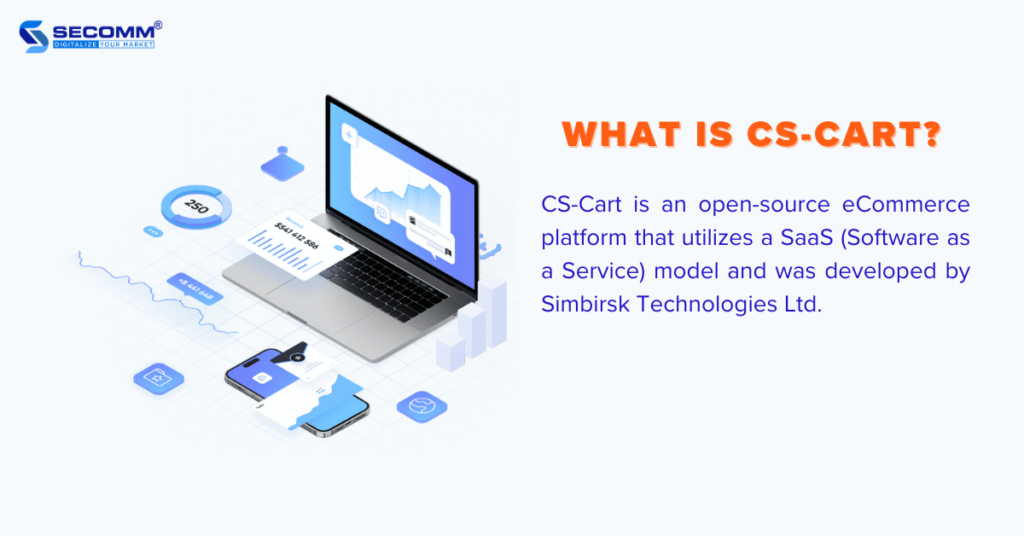
Some eCommerce websites currently using the CS-Cart platform include TechAble (USA), Yumbles (UK), Bakeshop (Australia), ToolBrothers (Germany), Inasbay (Canada), Nguyễn Kim (Vietnam), and more.
Currently, CS-Cart offers two main solutions: No-Code (a no-code e-commerce website builder) and On-Premises (an open-source eCommerce solution for website customization).
No-Code solution pricing:
On-Premises solution pricing:
Moreover, CS-Cart provides a free open-source version for businesses to freely apply for building eCommerce websites.
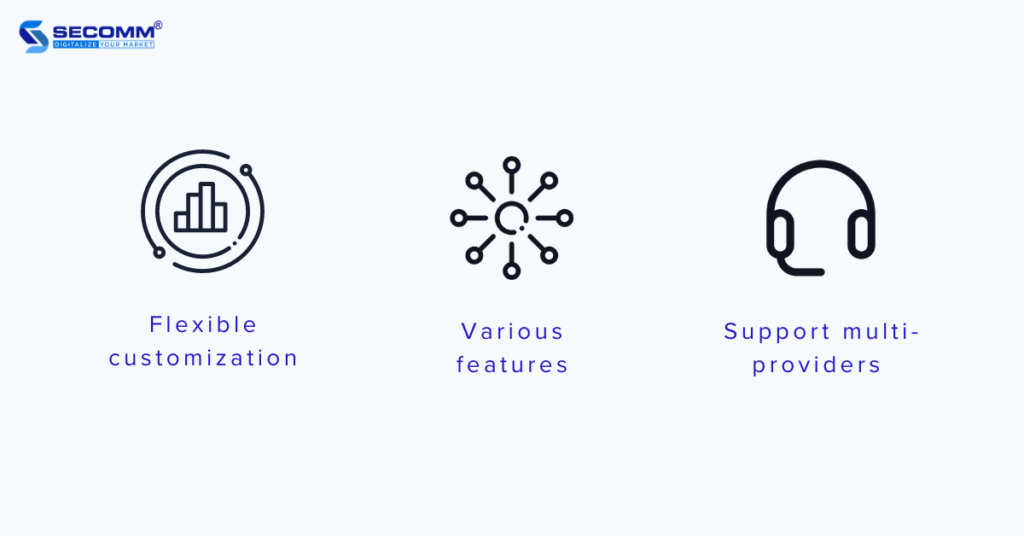
One of the standout features of the CS-Cart platform is its flexibility, supporting businesses of both moderate and large scales in the eCommerce market.
Beyond employing open-source with the PHP language, CS-Cart also implements Headless architecture, allowing businesses extensive customization capabilities. This flexibility empowers businesses to create eCommerce websites tailored to their specific needs, delivering a unique and memorable shopping experience for customers.
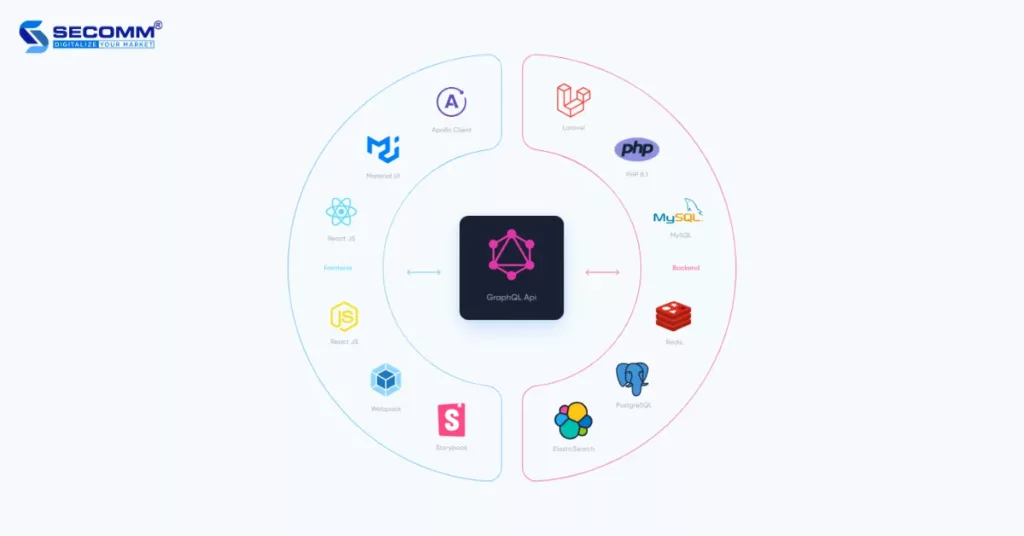
CS-Cart provides a comprehensive range of features from A to Z for operating an eCommerce system for businesses, including over 500 features and 2,000 available add-ons. From product management and order processing to marketing and SEO optimization, among others
This richness helps businesses minimize the need to integrate numerous third-party plugins, streamlining the technology stack of the eCommerce website.
CS-Cart is highly praised for its ability to connect and manage multiple suppliers with customers. This multi-vendor capability optimizes the management of different sellers, inventory, and payments, making the website system an ideal solution for businesses looking to oversee multiple suppliers on a single platform.
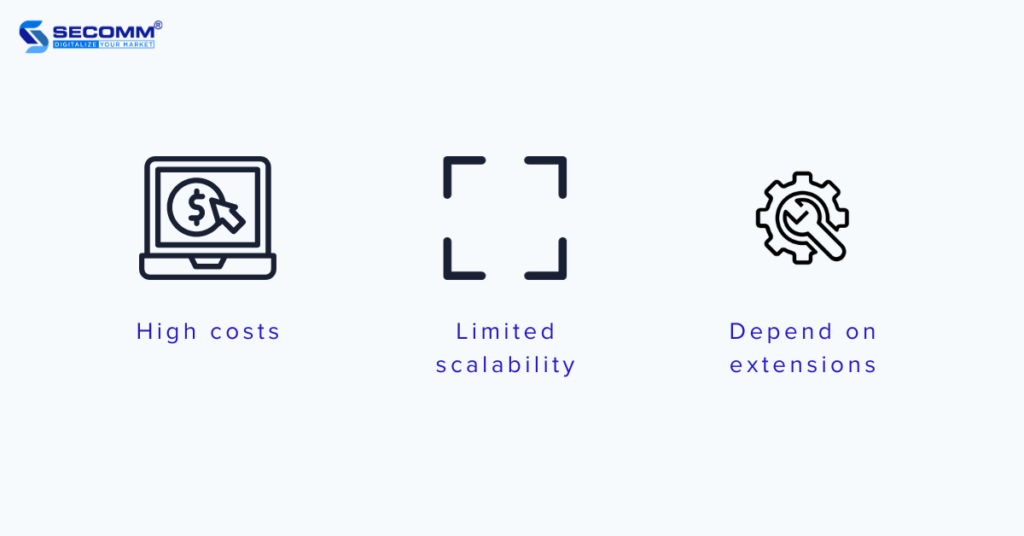
The paid versions, No-Code, and On-Premises, are considered to have relatively high usage costs. Additionally, the free version of CS-Cart may not be sufficient to meet the needs of building an eCommerce website for businesses, especially larger ones.
Businesses should note that many advanced features and functionalities will require purchasing licenses or additional add-ons. The costs associated with these add-ons and development and customization expenses can accumulate, particularly for small businesses or startups with limited budgets.
While CS-Cart is suitable for a variety of business scales, it may not be the most scalable solution for rapidly growing businesses with high levels of traffic and transactions. As businesses expand, performance issues may arise, necessitating improvements to the system’s performance or a transition to another platform.
Although CS-Cart provides many comprehensive features, some businesses feel the need for specific functionalities, requiring the purchase or development of additional third-party add-ons outside the CS-Cart ecosystem.
Relying heavily on third-party add-ons can lead to issues of compatibility, security concerns, and difficulties during the upgrade process.
The Bottom Line
In general, CS-Cart is an eCommerce platform suitable for businesses seeking an open-source solution, especially those with a medium scale. However, when upgrading to a more specialized and complex eCommerce website system, businesses will need to invest additional costs and resources to scale up the system.
These are the details about CS Cart, along with its notable advantages and disadvantages that businesses should consider when developing an eCommerce website.
After years of implementing eCommerce solutions for various businesses across different countries, SECOMM has accumulated valuable experience in helping businesses build and develop effective eCommerce websites.
Contact SECOMM or call the hotline at 02871089908 for advice on choosing a platform and deploying eCommerce today!
 2
2
 7,701
7,701
 0
0
 1
1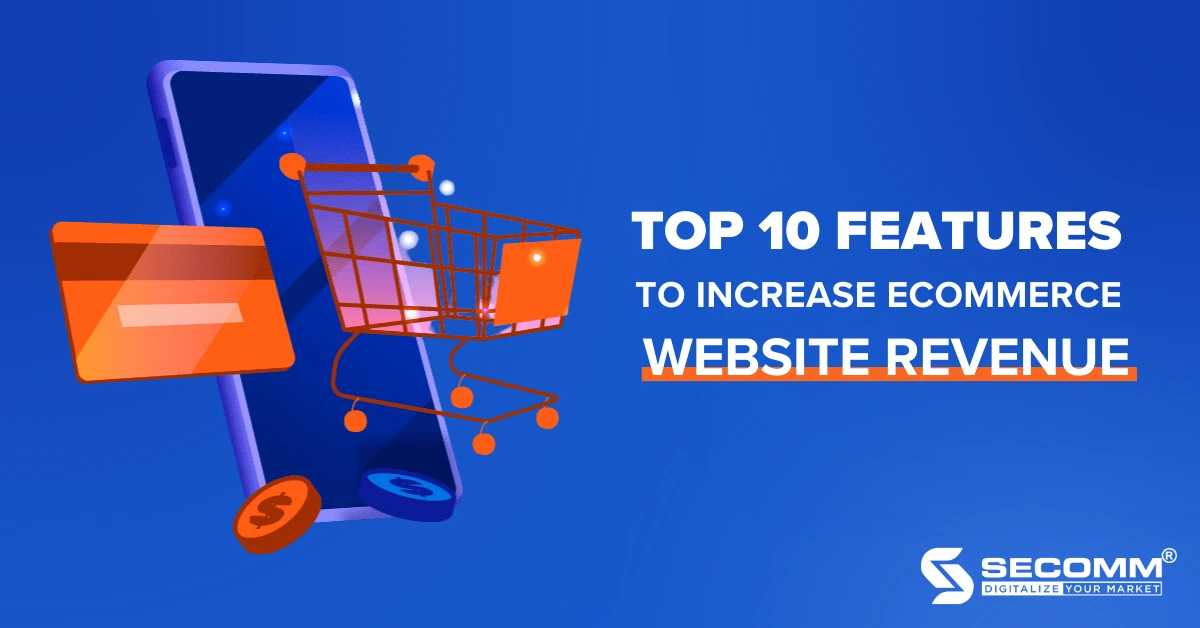
eCommerce has become an essential trend for successful business in the Vietnamese market. According to a report from Facebook’s SYNC Southeast Asia and consulting firm Bain & Company, Vietnam is expected to be the fastest-growing eCommerce market in Southeast Asia by 2026, with a total eCommerce goods value reaching $56 billion, 4.5 times that of 2021, ranking second in the region.
To harness the advantages of this thriving market, businesses need an eCommerce website system with a full range of functionalities, from basic to advanced. Therefore, planning a step-by-step construction of the functional system is crucial to avoid situations where there are ‘missing essentials’ or ‘unnecessary features’ for the business.
Here are some specialized functionalities that any eCommerce website system for businesses in this lucrative market should have!
Images and videos play a crucial role in allowing customers to evaluate the quality of products, especially high-involvement items like jewellery, watches, gemstones, etc.
Additionally, businesses can incorporate features such as 360-degree views, Augmented Reality (AR), or Virtual Reality (VR) to help customers get a comprehensive and realistic view of the product’s quality on the eCommerce website.
In today’s era where ‘good wood comes with good paint,’ investing in high-quality images or videos enhances the impression of a business’s products in the eyes of consumers and demonstrates the professionalism of the brand. Consequently, businesses can keep customers engaged on the website for longer periods, reduce bounce rates, and boost online sales.

One of the essential features of modern eCommerce systems is the ability to filter and search for products effectively, such as live search or ElasticSearch in Magento.
This feature plays a role in directing customers to the detailed product information they are looking to purchase, enhancing the overall customer experience and shortening the shopping journey.
As a result, businesses can improve customer satisfaction and streamline the purchasing process.

Sometimes, customers may be interested in a particular product but decide to purchase it later, or they might find an intriguing product and want to check detailed information before making a buying decision. In such cases, a wishlist allows customers to store these products for easy retrieval when they are ready to make a purchase decision.

Although promotional programs are not unfamiliar to consumers in the eCommerce market, this feature has never gone out of fashion for businesses. According to Google, up to 75% of customers view advertisements before making a purchase, and 84% of customers use information from ads to research product details.

Frequently displaying promotional programs/deals such as flash sales, D-Day promotions, festive season offers, etc., will stimulate customers’ ‘sale hunting’ desires, increase website traffic significantly, and boost sales for businesses.
After leveraging and analyzing the collected data from customers, an advanced eCommerce website system can provide suggestions for similar or related products, aiming to increase the quantity and value of orders. This, in turn, contributes to the growth of online sales revenue for the business.

Up-selling is a technique aimed at selling a more expensive version of a product that a customer already has or intends to purchase by adding new features or accessories to that product. Meanwhile, Cross-selling is a technique aimed at selling complementary products, items that may be related to the product a customer has purchased or intends to buy.
In addition to suggestions for similar and related products on the homepage, product category page, product detail page, and search results page, Up-selling and Cross-selling are also designed to appear on the checkout page to encourage customers to spend more.
The quick order placement feature is an essential function for an eCommerce website. To expedite the shopping process, it’s not enough to have a step-by-step ordering process. Businesses need to design a ‘quick order’ function that allows customers to add products to the checkout page immediately. This will be a significant advantage for businesses to expedite the customer’s ‘order confirmation’ process, thereby generating a surge in online sales.

Typically, the default checkout process on an eCommerce website is a step-by-step procedure, meaning that each step is completed automatically only after the customer finishes the previous one until the entire process is completed.
According to a report from Adobe, 88% of customers abandon their purchases simply because the checkout process takes too much time and is complicated. To streamline this cumbersome payment process, the One Step Checkout feature has been introduced. This feature provides essential information to customers in just one step, facilitating faster transactions and creating a smoother payment process.

Diverse payment methods, including card payments (local cards, VISA, Mastercard), e-wallets (MOMO, Zalopay), payment gateways (OnePay, VNPay, PayPal, Stripe), and Cash on Delivery (COD), will enhance the shopping experience for customers. Additionally, businesses should stay updated on emerging payment trends in the eCommerce market, such as creating their digital wallets, implementing Buy Now – Pay Later options, etc., to build a Loyalty Program and provide more payment choices for customers.

However, to diversify payment methods, businesses should choose open-source eCommerce platforms such as Magento, WooCommerce, and OpenCart to have high integration capabilities and ensure compatibility between payment software and the company’s website.
According to a report from Customer Gauge, 92% of customers will read product reviews from other users before making a purchasing decision. Therefore, the product review feature is always prioritized by businesses to be included in the functionality system from the beginning to enhance the brand’s credibility.
A website with many positive comments from previous users will attract attention and trust from potential new customers, laying the foundation for revenue growth for the business. In addition, negative reviews will help businesses identify the weaknesses of the product, thereby motivating them to improve product quality and services for the future.

In addition to a visually appealing interface and standard UI/UX, the ability to be compatible across multiple devices such as desktops, smartphones, and tablets is a mandatory feature that must be present on the interface of an eCommerce website. This is not only a factor affecting the Omnichannel experience of customers but also a criterion that influences SEO and rankings from Google.

Furthermore, many other features need to be considered for integration into the functional system of the eCommerce website of the business. This will depend on the strategy and business model of each enterprise, as well as the eCommerce platform the business is using.
With SaaS platforms, businesses will not have many options for features since these systems are pre-built, making it difficult to modify the source code and potentially causing instability if there are automatic edits or additions/removals of features.
In contrast, with open-source platforms, businesses have the freedom to choose features to build at each stage of brand development, as well as the ability to integrate with third-party utilities more easily than SaaS platforms.
With deep expertise and experience in developing complex eCommerce systems across multiple countries such as Vietnam, Australia, the US, and New Zealand, SECOMM understands the challenges in the process of building and deploying eCommerce functions that businesses are currently facing.
Contact SECOMM now for a free consultation on detailed eCommerce system development solutions!
 2
2
 10,059
10,059
 0
0
 1
1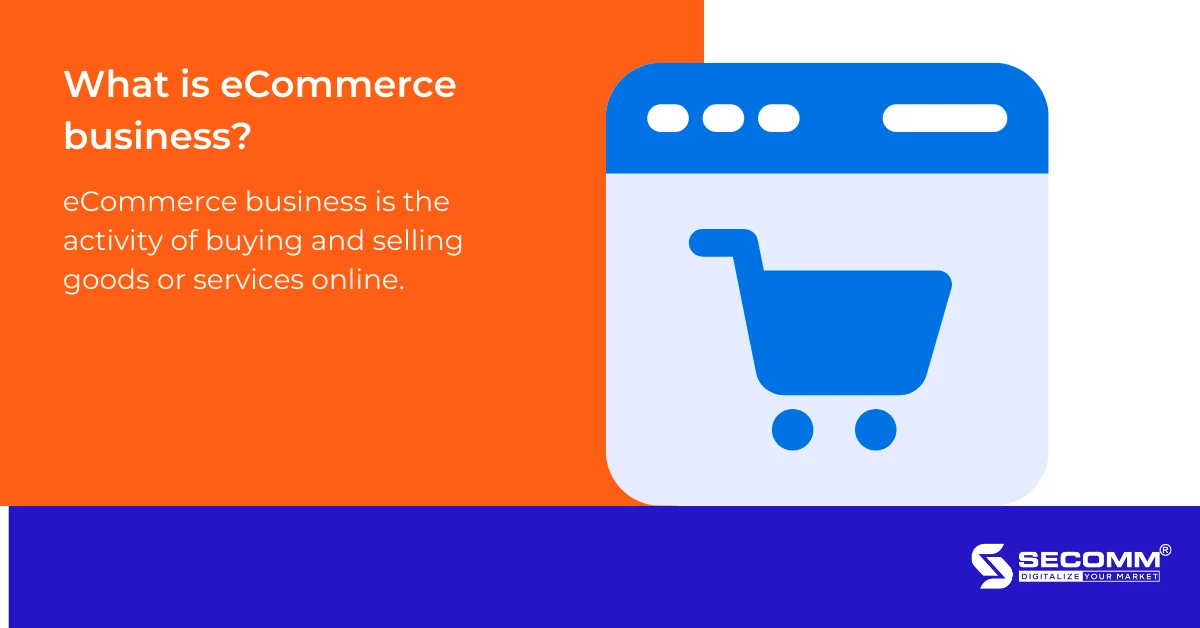
For businesses that are just entering the market, the term “eCommerce” is often recognized through eCommerce marketplaces. Most managers are often unsure of where to start, including which systems to use, which eCommerce platform to choose for development, and what steps to take next.
Therefore, in this article, SECOMM will share comprehensive information from basics to advanced levels to kickstart eCommerce business in Vietnam.
According to Decree No. 52/2013/ND-CP on eCommerce: “eCommerce activities involve conducting all or part of the commercial process through electronic means connected to the Internet, mobile telecommunications networks, or other open networks.”
In simpler terms, eCommerce business is the activity of buying and selling goods or services online.
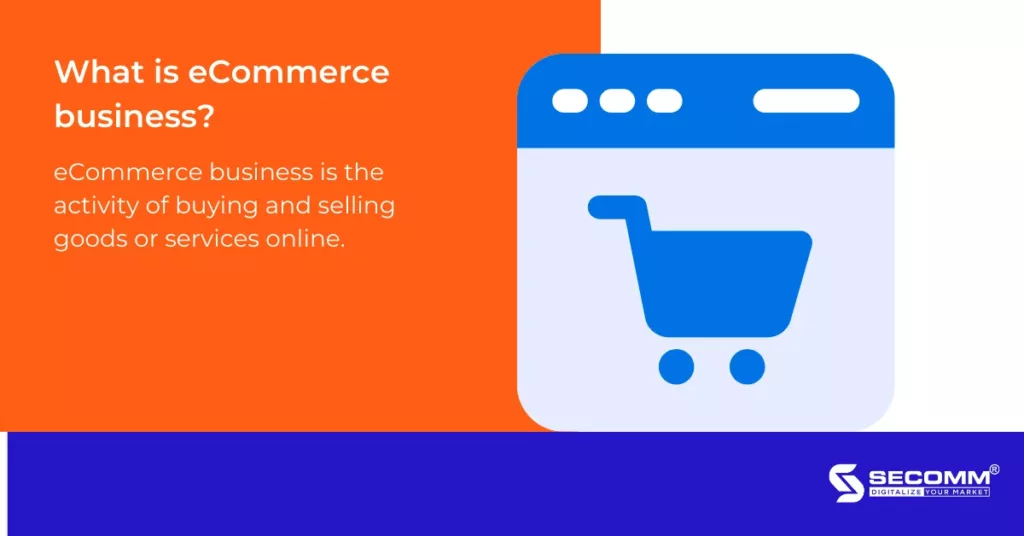
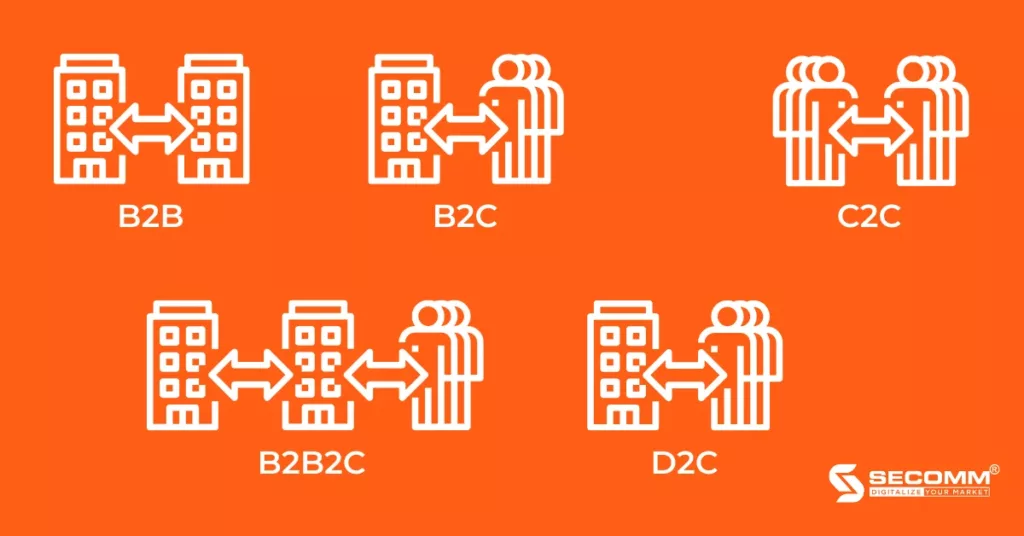
B2C (Business to Customer) involves transactions between businesses and customers. This is also the most common model in the Vietnamese market.
Example: Thế Giới Di Động is the number one retail model in Vietnam’s eCommerce market for devices such as phones, laptops, tablets, and accessories.

B2B (Business to Business) involves commercial transactions between two businesses.
Example: TELIO is Vietnam’s first B2B eCommerce platform, facilitating the connection between small-scale traditional retailers and brands by aggregating demand, providing more choices, better prices, and more efficient logistics support.

B2B2C (Business to Business to Customer) is a business model that involves collaboration between two businesses (B2B) to create and deliver products or services to end consumers (B2C).
Example: Shopee is the most popular eCommerce platform in Vietnam. Shopee Vietnam initially operated under a C2C model, serving as an intermediary in the buying and selling process between individuals. However, Shopee Vietnam has evolved into a B2B2C hybrid model by offering various services and conveniences to support the shopping process for both businesses and consumers.
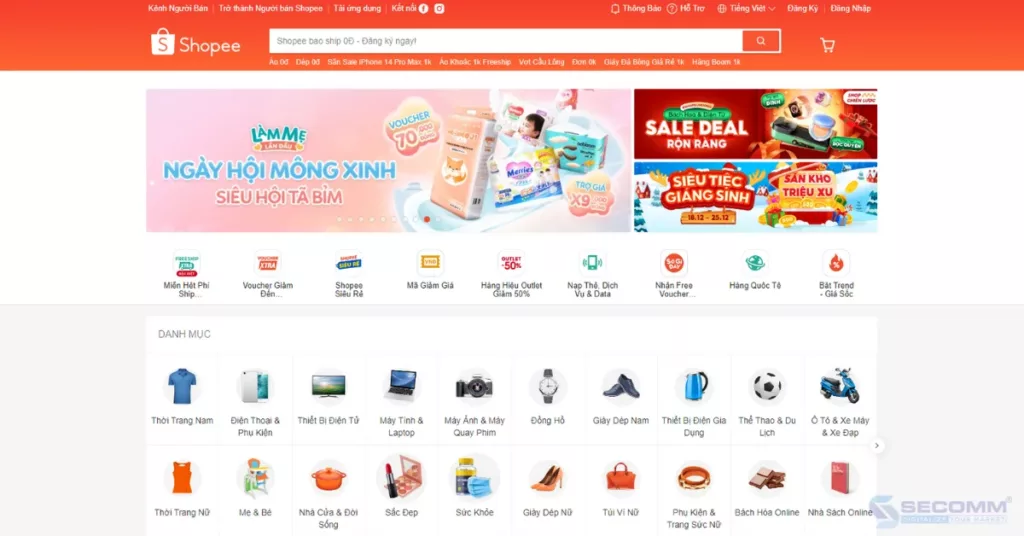
C2C (Consumer to Consumer) is a form of business where transactions occur directly between two individuals rather than involving businesses.
Example: Chợ Tốt is an eCommerce website that facilitates transactions between individual sellers and buyers for items such as real estate, cars, job postings, used electronics, pets, and various home services.

D2C (Direct to Customer) is a business model that delivers products directly from the business to the customer, bypassing intermediary distribution channels.
Example: Coolmate is a men’s fashion startup established in 2019. Within just 2 years of operation, the brand raised a rapid $500,000 in funding for Sharktank.
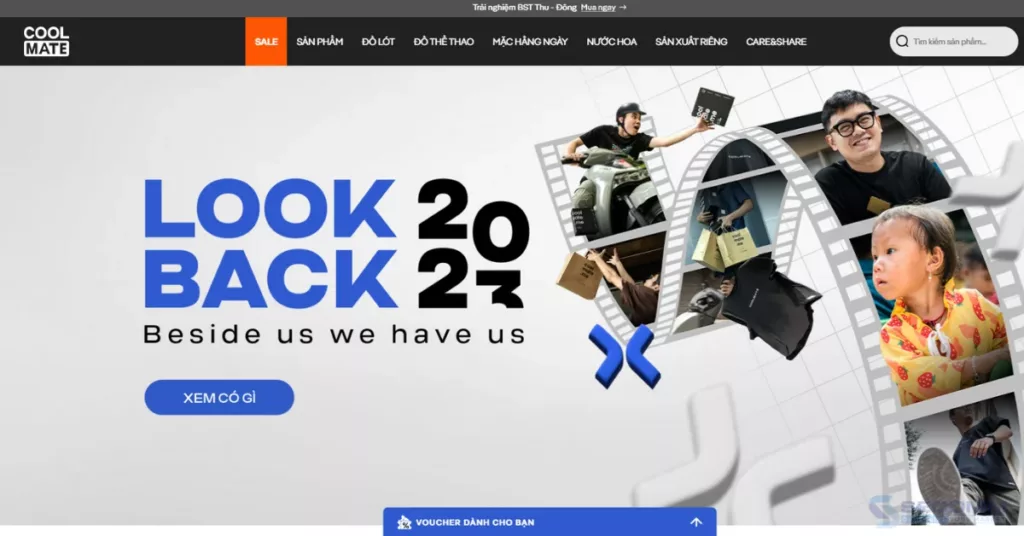
When starting to plan a business, the first step that managers should take is market research to understand the overall market situation, details about competitors, trends, and consumer behaviour. Some free and reputable sources businesses can refer to include the White Paper on eCommerce in Vietnam by IDEA, the e-Conomy SEA report by Google & Temasek, the eCommerce Index report by Vecom, etc.
After conducting market research, the next thing businesses should pay attention to is defining objectives, such as adding sales channels to increase revenue, positioning the brand in the eCommerce market, supporting marketing campaigns, enhancing user experience and interaction, etc.
Following market research and goal setting, businesses should also budget and plan the implementation timeline for each stage of eCommerce operations. Depending on the goals and strategies, each business will set budgets and timelines for the most effective eCommerce operations.
Next, businesses need to choose an eCommerce platform to build a system that aligns with the brand’s scale and strategy. The components of an eCommerce system typically include a website and an eCommerce website application.
There are two main types of platforms nowadays: SaaS (Software as a Service) and Open Source.
For Open Source platforms:
For SaaS platforms:
Once the eCommerce platform is selected, businesses have two options for resources to build the website: building an in-house team or using services from developers.
For building an in-house team, businesses need to recruit and train IT and eCommerce professionals with expertise and experience on the chosen platform. This process may take time and budget to build a suitable team but provides better control over resources, allowing adjustments or developments according to specific requirements.
For collaborating with development firms, businesses should seek developers based on criteria such as deep experience in eCommerce, an experienced team, a clear process, quick handling and support, and commitments to warranty and maintenance. This approach helps businesses gain professional expertise, enhance experience, and develop a suitable website.
In the eCommerce market, there are various payment methods, with Cash on Delivery (COD) being the most common. However, due to the rise of “cashless” payment trends amid the Covid-19 pandemic, electronic payment methods are gaining more prominence.
Some payment methods chosen by eCommerce businesses include:
Usually, a fulfilment process includes the following steps: Importing goods or manufacturing → Shipping to warehouse/distribution centre → Warehousing → Processing goods upon request (Shipping, invoicing, packaging, labelling) → Delivery → Handling post-sale requests (Returns, refunds, exchanges).
Therefore, a comprehensive eCommerce system needs to build or integrate functionalities such as eLogistics, blockchain, QR codes, etc., to automate the shipping process, track orders, and thereby enhance the quality of delivery to end consumers.
A Customer Relationship Management (CRM) system is an essential component in the operation of eCommerce businesses. Building and continuously improving the CRM system, as well as implementing a multi-channel customer care centre, helps expedite the processing of complaints, returns, and refunds. Additionally, a CRM system assists businesses in gaining insights into customer needs, facilitating the establishment of interactions between the brand and its customers.
Maintaining the eCommerce system 24/7, continually updating and upgrading it helps businesses promptly address arising issues, achieve sustainable sales growth, and adapt quickly to the ever-changing market. Simultaneously, continuous monitoring and maintaining eCommerce operations aim to prevent risks from hackers, data breaches, etc.
One of the crucial strategies in current eCommerce operations is omnichannel selling. By following customers’ “footprints” across eCommerce platforms (Shopee, Lazada, Tiki, Sendo), social media (Facebook, TikTok, Instagram, Zalo), websites, and eCommerce apps, this strategy centralizes customer data, reaches diverse shopping behaviours, and optimizes personalized experiences in the eCommerce system. Additionally, various eCommerce marketing campaigns are being developed, such as Affiliate Marketing, Shoppertainment, SEO, Email Marketing, etc. This strategy optimizes brand visibility and boosts online sales.
Building reporting functions to exploit the efficiency of data, including reports on Sales, Marketing, Customers, Inventory, and Operational Performance, to improve and enhance business efficiency. Integrating analytical tools such as Google Analytics, Facebook Pixels, Microsoft Power BI, etc., supports tracking and measuring system performance to provide detailed reports on business results in eCommerce.
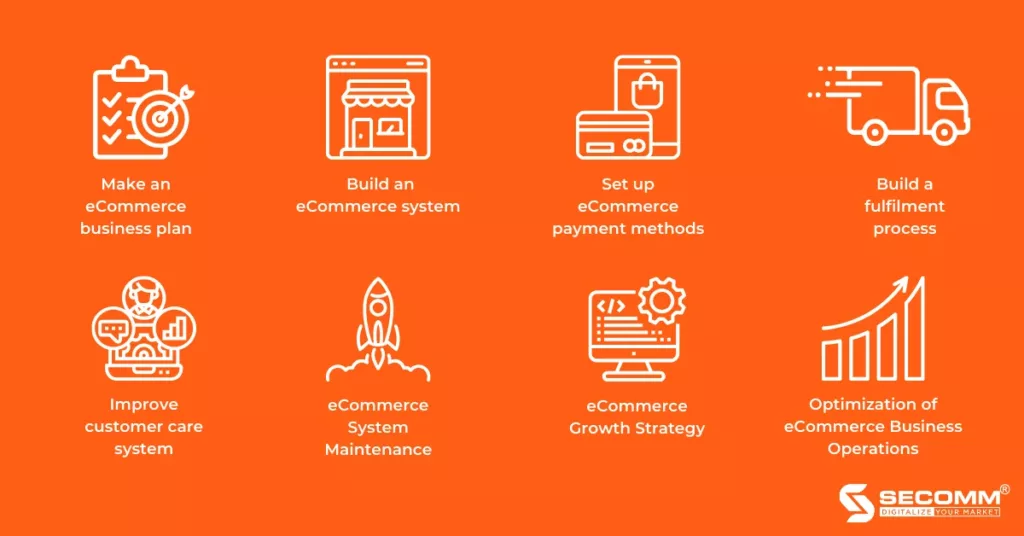
In summary, conducting eCommerce based on the above 8 steps is not an easy task for business managers. To stay competitive in the eCommerce race, various factors come into play, including financial strength, human resources, the general economic situation, changes in consumer behaviour, etc. Therefore, managers need to be cautious when making critical decisions to bring business efficiency.
With over 9 years of experience in designing complex eCommerce systems for companies like Annam Gourmet, Laybyland, and Jasnor, SECOMM understands the challenges businesses face in researching and efficiently implementing eCommerce.
Contact SECOMM now for free consultation on detailed eCommerce system development solutions!
 2
2
 16,411
16,411
 0
0
 1
1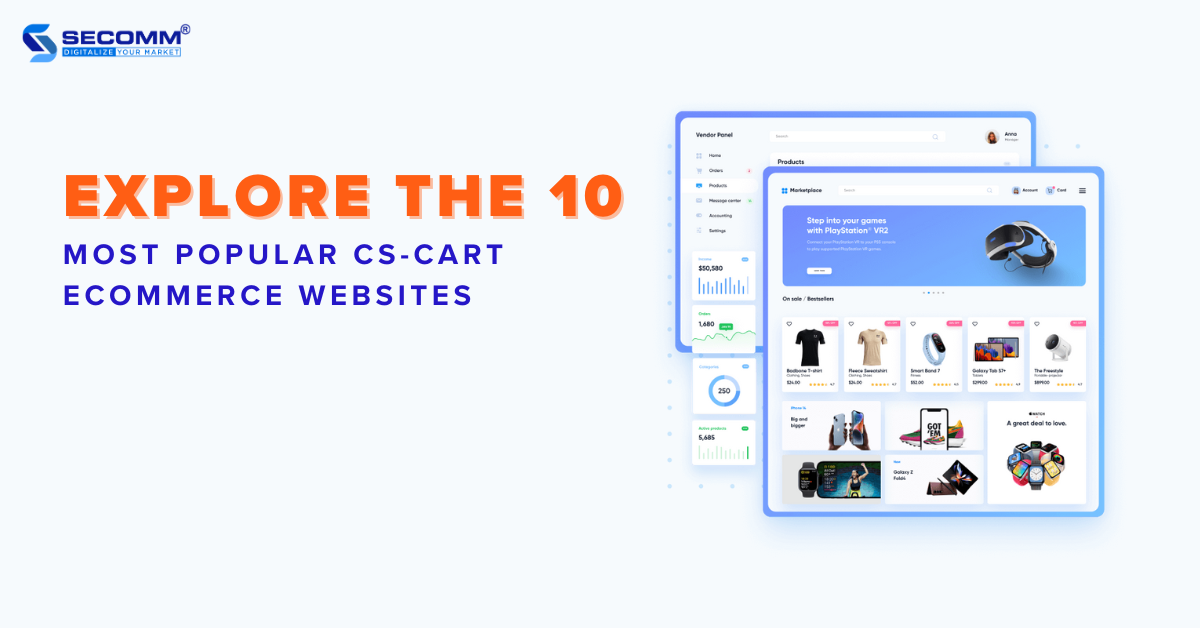
CS-Cart is a versatile eCommerce platform, available in both open-source and SaaS models. Established in 2005 under Simbirsk Technologies Ltd., it has garnered trust from medium-sized and large businesses. Its reputation is built on robust customization options, numerous features, and supplementary utilities within its ecosystem.
Listed below are brands that have built their CS-Cart eCommerce websites.
House of CB is a leading women’s fashion brand in London, United Kingdom. Renowned for its meticulously crafted collections tailored for significant events, the brand was established by Conna Walker at the age of 17, backed by a £3,000 loan from her father.

Faced with initial capital constraints, House of CB strategically leverages eCommerce to engage with its potential customers. Over time, the brand has graced the wardrobes of numerous Hollywood luminaries, including Beyonce, Gigi Hadid, Lady Gaga, Jennifer Lopez, and the Kardashians.
Maxbhi is an eCommerce venture operated by Elcotek India Private Limited in India. The CS-Cart website is dedicated to offering a wide range of accessories for electronic devices, including mobile phones, tablets, laptops, and more, specifically within the Indian market.
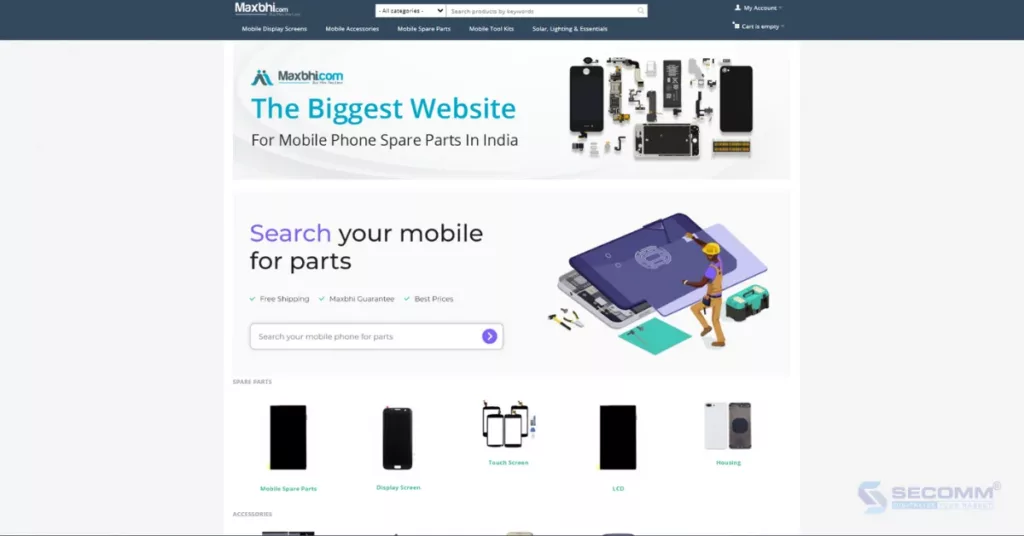
Launched in 2004 in Ghaziabad, India, this CS-Cart eCommerce website has grown to become one of the largest and most enduring online stores for phone accessories in the country.
Harvey Norman is a leading retailer in New Zealand, offering a diverse range of products including computers, electronics, furniture, bedding, and household appliances from renowned global brands.
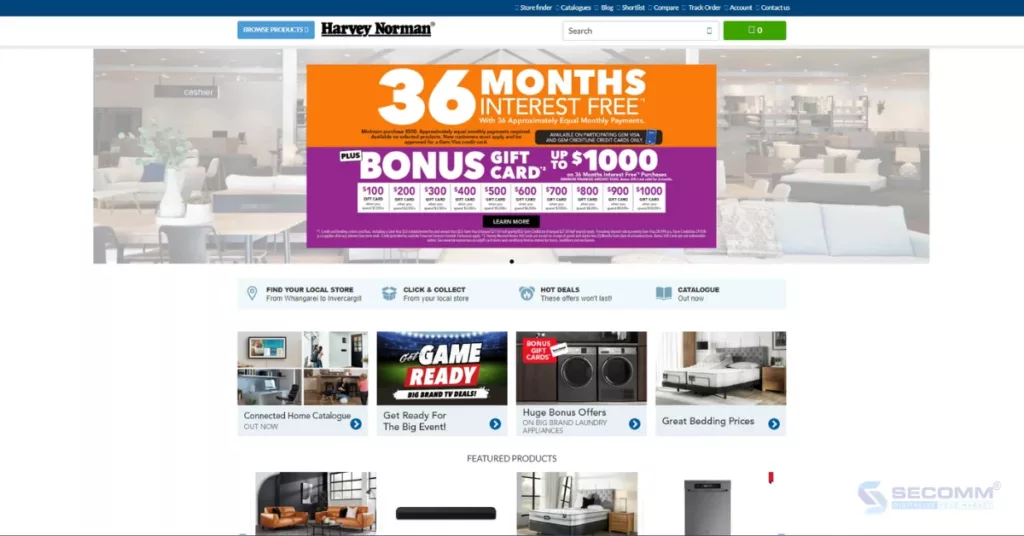
This initiative is part of the franchise system operated by Harvey Norman Holdings Limited, a publicly listed company on the Australian Securities Exchange Limited. The company’s main activities encompass retail, franchise operations, real estate, and digital enterprises.
Enter stands out as one of Moldova’s major retailers in the consumer electronics sector. Boasting a network of 25 traditional stores across the country, Enter focuses on delivering a wide range of electronic devices, including mobile phones, tech accessories, home appliances, and more.
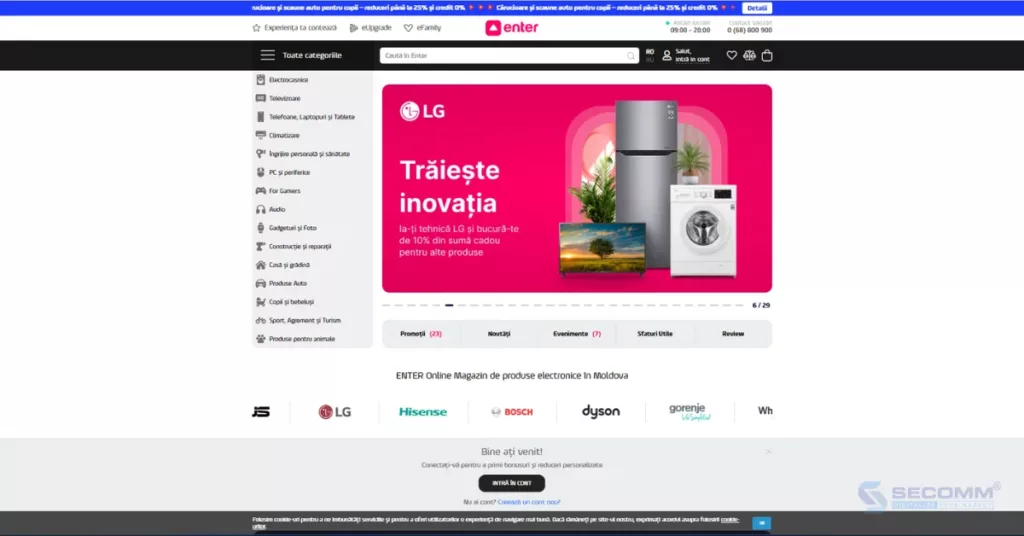
Moreover, Enter has established itself as a trusted authorized dealer for renowned brands such as Apple, Samsung, Xiaomi, Dyson, Lenovo, LG, and others. With future plans in mind, the company aims to further expand its brick-and-mortar stores and enhance its eCommerce website for an even more convenient shopping experience for customers
Mobilier1 is a Romanian CS-Cart eCommerce website specializing in the furniture industry. With over a decade of experience, the company remains focused on manufacturing and selling furniture within the eCommerce market. Mobilier1 consistently earns praise for the high quality of its products and services, providing competitive pricing compared to other market players.

Furthermore, Mobilier1 offers additional services such as nationwide free delivery and a 365-day return policy, ensuring a seamless experience for its customers.
Butor1 is a Hungarian business specializing in the distribution of furniture and interior accessories. Over the past decade, the company has formed direct partnerships with renowned furniture manufacturers to offer customers products at reasonable prices.
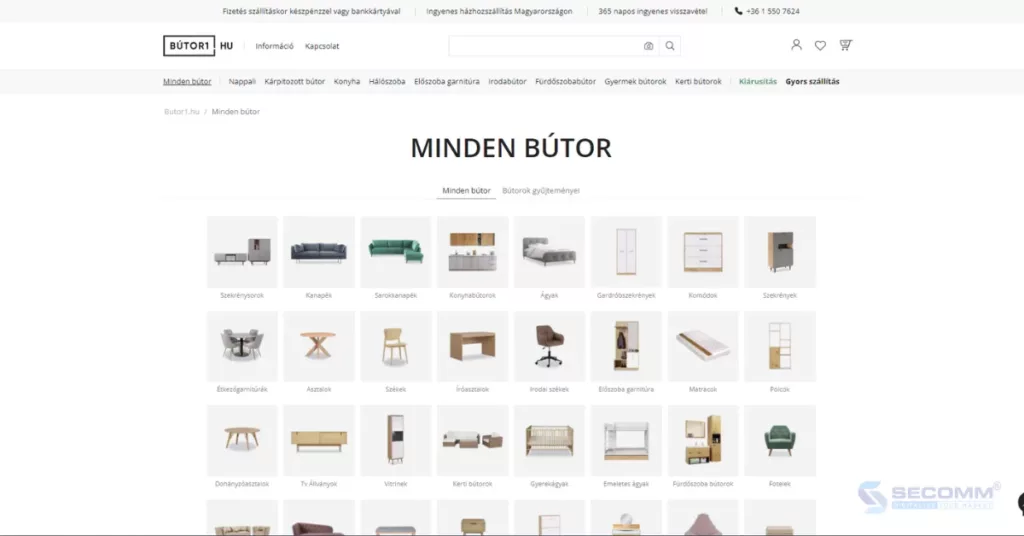
Recently, Butor1 has taken a step further by combining CS-Cart eCommerce website operations with sustainable practices, pledging to plant a tree for each successfully placed order, demonstrating its commitment to environmental responsibility.
Siriust is a CS-Cart eCommerce website under the umbrella of Profi, a leading retail chain in Russia. Specializing in tech accessories like smartphones, laptops, wireless devices, and repair tools, Siriust boasts a catalog of over 16,000 products.
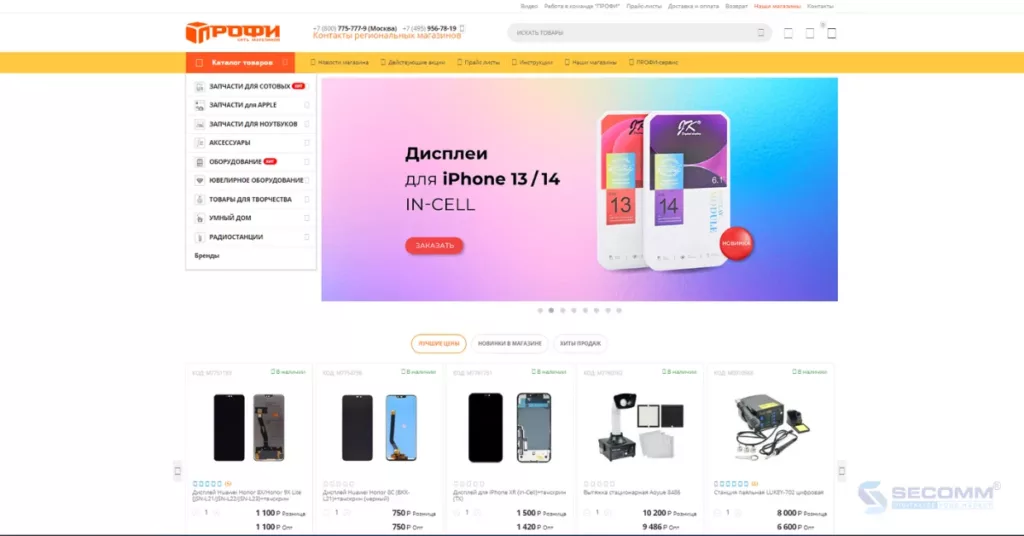
With 50 physical stores in major Russian cities, the company has strategically introduced a CS-Cart website, enabling customers to conveniently make online purchases and pick up their orders from the nearest store.
Topsto is an online store serving customers in both B2B and B2C sectors in the Crimea region, Ukraine. With an expansive product catalog comprising over 280,000 items, Topsto’s CS-Cart website gained favor among customers for its varied product range, affordable pricing, and swift delivery services across the Crimea region.
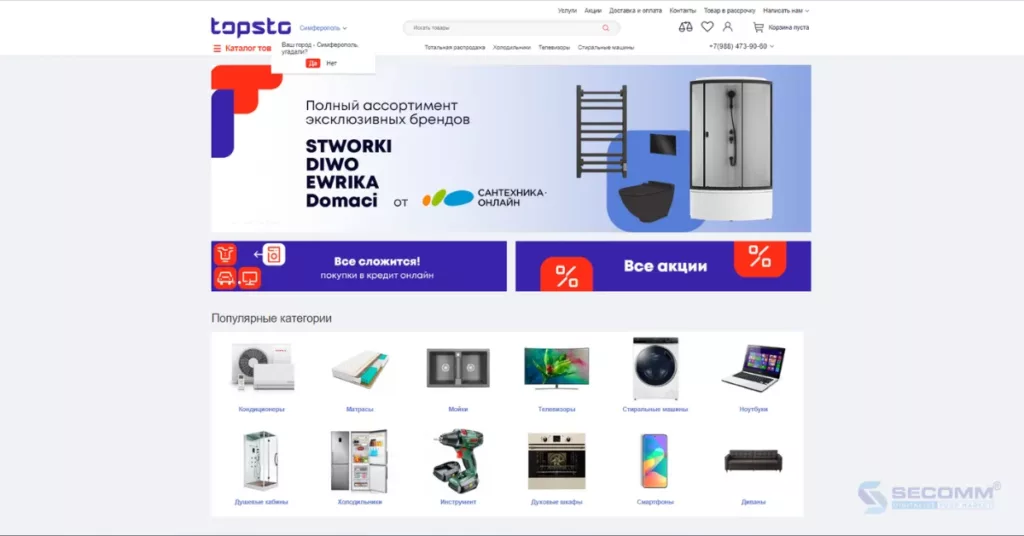
UcuzKitapal is a Turkish online book retail business with a loyal customer base of over 85,000. The store offers a vast collection of books covering diverse genres, including education, literature, economics, self-development, and more.

Through the early adoption of a CS-Cart eCommerce website, the business consistently satisfies book-buying needs with highly competitive prices, swift delivery, and attractive offers.
Riviera Vaudoise is a paint and coating business established 40 years ago in the “Riviera Vaudoise” region in western Switzerland. Renowned for its picturesque landscapes, traditional villages, rose gardens, and idyllic lakeside views, the region provides an exquisite backdrop.
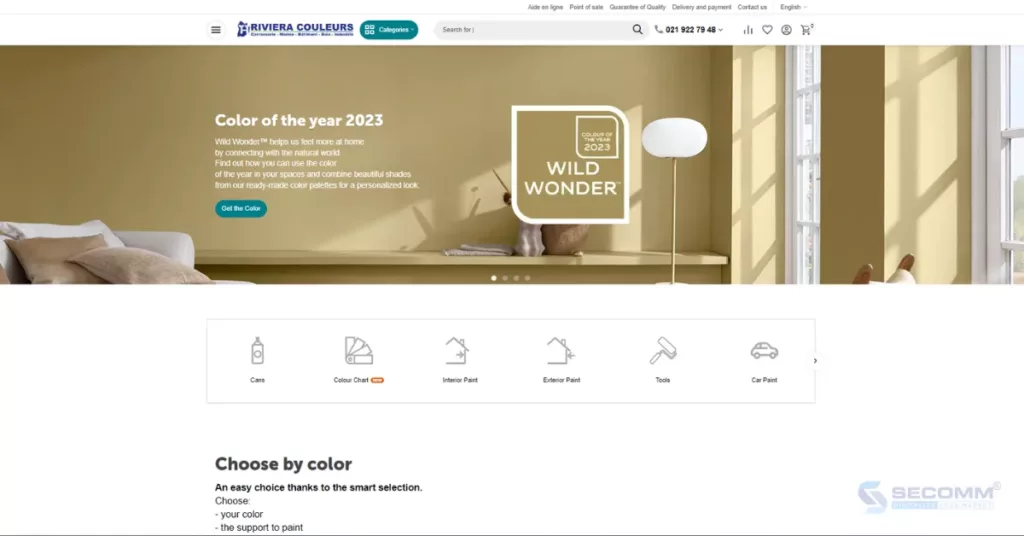
Over the years, Riviera Vaudoise has evolved into the premier destination for oil-based paints in the area, catering to diverse needs such as automotive, residential, and wood applications.
Currently, the company has built its CS-Cart website to extend its business footprint into the realm of eCommerce, aiming to connect with a broader audience of potential customers throughout Switzerland.
Here are 10 CS-Cart eCommerce websites that have not only successfully developed their online presence but have also achieved notable success in their respective industries. This triumph serves as inspiration for other businesses looking for effective solutions to elevate their operations and enhance competitiveness in the market.
Drawing on substantial experience in implementing eCommerce solutions for clients across diverse countries, SECOMM comprehends the challenges and hurdles businesses encounter during the deployment process.
Contact SECOMM today or call the hotline at 02871089908 for a free consultation.
 2
2
 9,567
9,567
 0
0
 1
1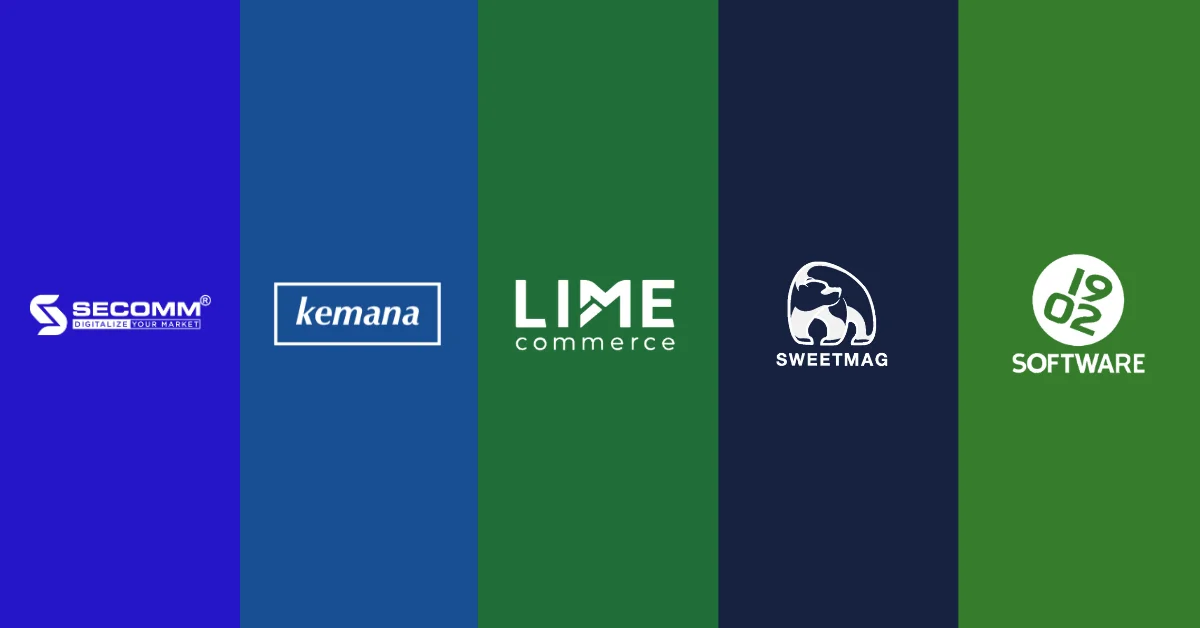
The eCommerce landscape in SEA is experiencing robust growth, with a CAGR of 11.43%. The anticipated total revenue for 2023 is projected to reach USD 109 billion, as reported by Statista. Moreover, there are over 2000 eCommerce websites built on the Magento platform within this market.
For most Magento deployment projects, collaboration with experienced developers on this platform is crucial. This partnership ensures joint planning, design, and development of customized websites tailored to the specific requirements of each business.
This article will delve into why Magento remains the preferred platform for eCommerce website development and spotlight the top 5 Magento developers in the SEA region, including Kemana (Indonesia), Lime Commerce (Indonesia), SECOMM (Vietnam), Sweetmag (Malaysia), and 1902 Software (Philippines).
Magento is an open-source eCommerce platform built using the PHP programming language and the Zend Framework. In 2018, Adobe officially acquired Magento and rebranded it as Adobe Commerce, aiming to integrate this platform into Adobe’s suite of digital solutions.
This merger has enhanced Magento’s capabilities and provided businesses with a more comprehensive eCommerce solution powered by Adobe.
Magento has two main versions: Magento Open Source – a free version (formerly known as Magento Community Edition) and the paid version called Adobe Commerce (formerly Magento Commerce).
The paid version offers users two options: on-premise and on-cloud, with numerous upgraded features and enhancements to meet higher demands for customization and scalability.
Being an open-source platform, Magento provides businesses with the flexibility to access and modify source code, functionalities, themes, and extensions. Moreover, Magento can efficiently handle up to 500,000 daily visits and imposes no restrictions on annual sales volumes.
According to BuiltWith, there are currently over 144,000 active Magento websites including several global brands experiencing significant traffic, such as:
Notably, some high-traffic eCommerce websites in the Southeast Asian market are also using Magento, such as:
These leading brands leverage the Magento platform to execute complex customizations for their eCommerce systems, enhancing their capabilities in handling high traffic, extensive product catalogs, and substantial sales volumes. Therefore, for any business seeking a highly customizable and scalable eCommerce platform, Magento is likely the first name that comes to mind.
Headless Commerce is an eCommerce trend with 80% of businesses planning to adopt this approach within the next two years, according to Salesforce’s “State of Commerce” report.
For the demands of Headless architecture, the open-source Magento platform stands out as an optimal choice. Unlike traditional Magento architecture, Headless Magento utilizes GraphQL API to support various frontend designs for different devices and screens. This setup is optimized and integrated into the existing backend system to deliver a seamless omnichannel experience.
Moreover, Adobe offers enterprises an advanced suite to enhance the efficiency of Headless Commerce operations. This suite includes Adobe Experience Manager (Content Management), Adobe Analytics (In-depth analytics reporting), and Adobe Marketo Engage (Marketing automation).
According to Emergen Research, the global Progressive Web App (PWA) market is expected to reach 10.44 billion USD by 2027. Therefore, it’s not surprising that many businesses are turning to Magento’s PWA Studio features. This toolkit facilitates the rapid development, launch, and maintenance of PWAs.
Moreover, businesses adopting Headless Commerce can seamlessly integrate with PWA Studio to customize frontend designs. PWAs are often combined with Headless architecture to create Headless PWAs, replacing conventional frontends with PWA storefronts to enhance website performance.
Moreover, Magento PWA utilizes Service Worker technology for device caching, significantly boosting page load speeds by 2 to 3 times.
Magento boasts a thriving and engaged community comprising developers, designers, and users. This community consistently generates modules, themes, plugins, and integrated add-ons for the Magento platform.
Moreover, there are many Magento developers in the market, making it easy for businesses to find a suitable partner.
In addition, prominent forums like Reddit, Quora, Substack, Slack Groups, and online conferences provide platforms for Magento users to exchange knowledge and experiences.
Hence, beyond direct support from collaborative partners, these forums serve as invaluable resources whenever businesses face challenges or require assistance throughout the Magento deployment journey.
Magento is designed to meet almost every need when it comes to creating professional and custom eCommerce websites.
However, not all businesses have the technical expertise and understanding of Magento to start and successfully implement this platform. This is why many businesses seek to collaborate with Magento developers to bring their ideas and business goals to life.
Below are 5 Magento agencies in South East Asia, boasting exceptional experience and expertise.
SECOMM (Vietnam)
SECOMM is known as a provider of comprehensive and specialized eCommerce solutions tailored to each business model and requirement.
Established in 2014, SECOMM has successfully collaborated on and developed Magento eCommerce websites for numerous major clients spanning from Australia, Singapore, Hong Kong to Vietnam, including LaybyLand, Changi Airport Group, My Market, Annam Group, and Vinamilk.
Going beyond Magento website development collaborations, SECOMM and its clients strategically outline sustainable short and long-term development plans, ensuring continued leadership in the targeted markets.
With vast experience in executing over 300 custom Magento website development projects for clients worldwide, SECOMM has firmly established itself as a premier professional Magento developer in Vietnam.
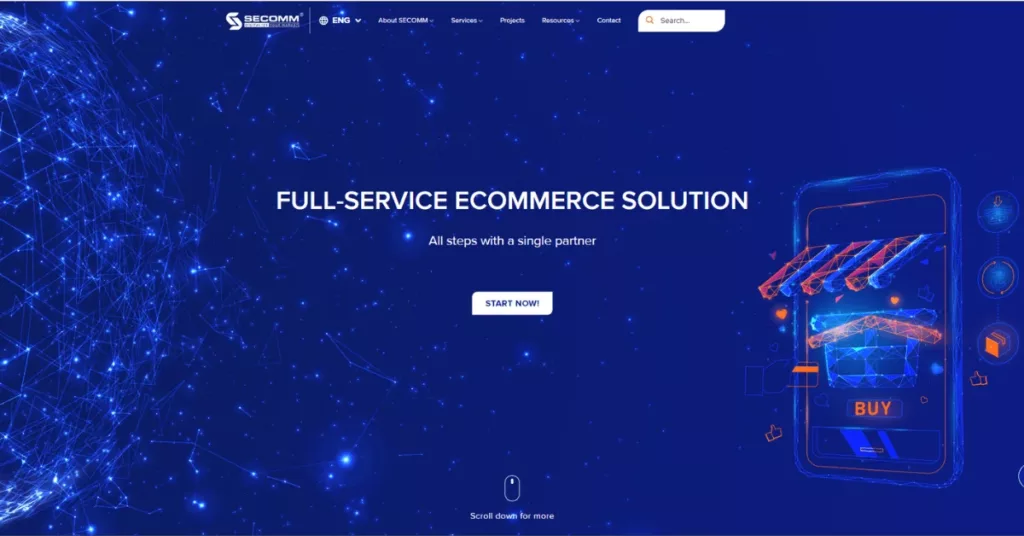
Established in 2011, Kemana Technology is a private company consisting of a team of experts with over a decade of experience in the eCommerce industry. Recognized as an official Silver partner of Adobe, Kemana stands out as a leading Magento developer in the broader APAC region and specifically in Indonesia.
When it comes to eCommerce website development services, Magento is the core technology solution that the company suggests to its clients.
Moreover, Kemana leverages Magento’s exceptional customization capabilities to deliver Omnichannel deployment solutions for retailers, offering two primary services: Click & Collect (Pick Up In-store) and Ship From Store.

Similar to Kemana Technology, Lime Commerce is also among the top Magento developers in Indonesia. Established in 2014, the company holds the Bronze partnership status in the Adobe Solution Partner Program. Lime Commerce provides personalized solutions tailored to meet the deployment needs of each customer segment.
As a dedicated eCommerce development company focusing on Magento, Lime Commerce offers a range of comprehensive services and solutions related to the Magento platform.
This includes custom design and development of Magento eCommerce websites, system maintenance and updates, optimization of website performance and security, and implementation of various crucial integrations.
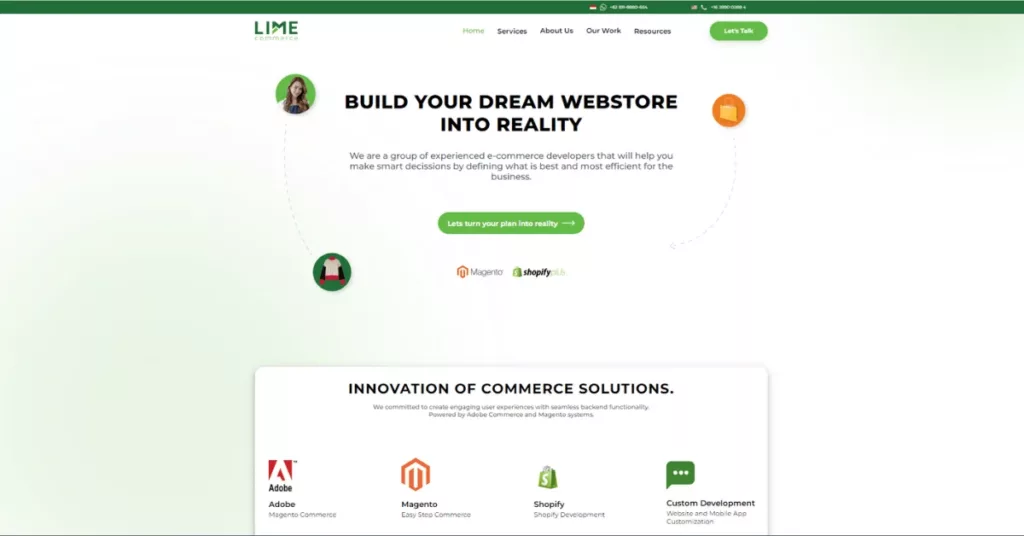
Established in 2008, Sweetmag Solutions has distinguished itself as a premier provider of Magento website development solutions in Malaysia, offering a range of associated web services. Over the years, Sweetmag has achieved Bronze-level partnership status in the Adobe Solution Partner program.
Sweetmag provides a seasoned team to build Magento eCommerce websites to meet specific requirements and objectives related to customer experience and conversion.
Through collaborations with prominent brands like Padini, Innisfree Malaysia, Parkson Online, and Caring Pharmacy, the company has firmly established its position in the Malaysian eCommerce market.
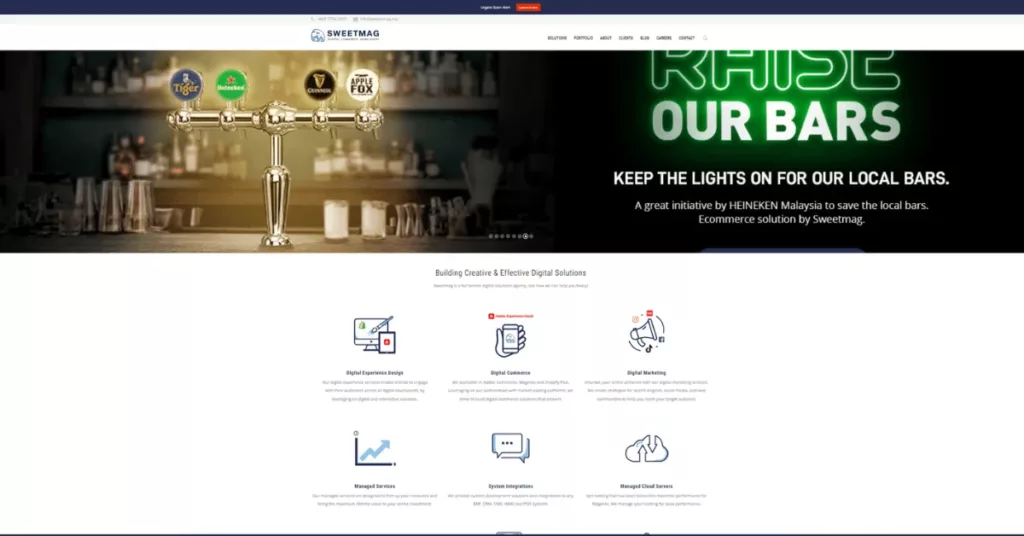
Founded and operated since 1998 by Danish programmer Peter, 1902 Software has evolved into a prominent software development and eCommerce solutions company in the Philippines. Their key services include AI development, eCommerce solutions, custom software development, and innovative design, all of which contribute to their notable reputation.
In the realm of eCommerce development, the company excels in delivering solutions for creating powerful, flexible, and scalable Magento websites. With a track record of successful projects, 1902 Software has earned positive reviews from satisfied clients.
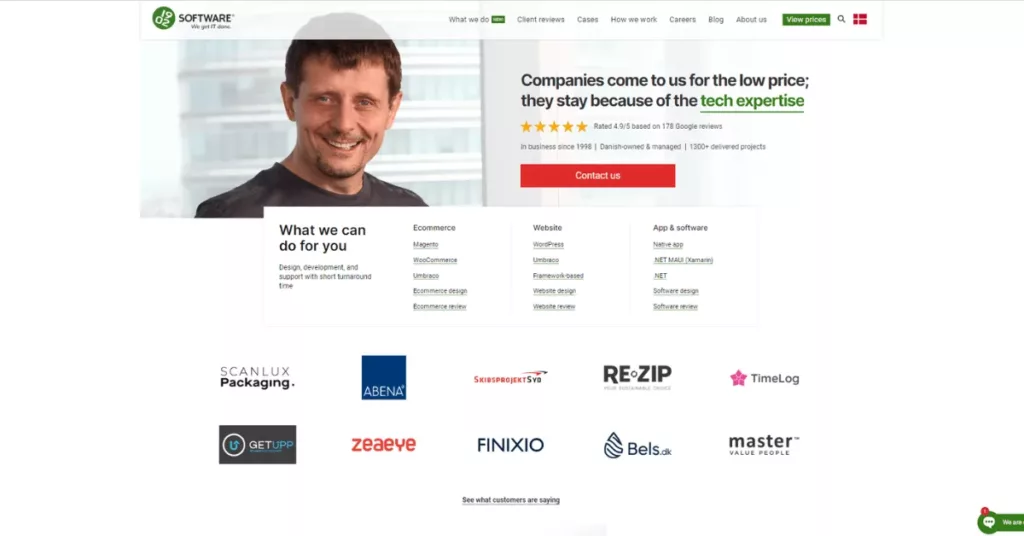
The effectiveness and popularity of Magento are demonstrated by the numerous businesses, spanning from medium-sized enterprises to large corporations, that have successfully implemented and operated their eCommerce websites on this platform. Moreover, the global Magento developer community is extensive, and the Southeast Asian region is no exception, featuring top-notch specialists with high technical expertise and extensive experience in Magento, as mentioned in the article.
Contact or call SECOMM’s hotline at (+84)28 7108 9908 to build your Magento eCommerce website today!
 2
2
 7,869
7,869
 0
0
 1
1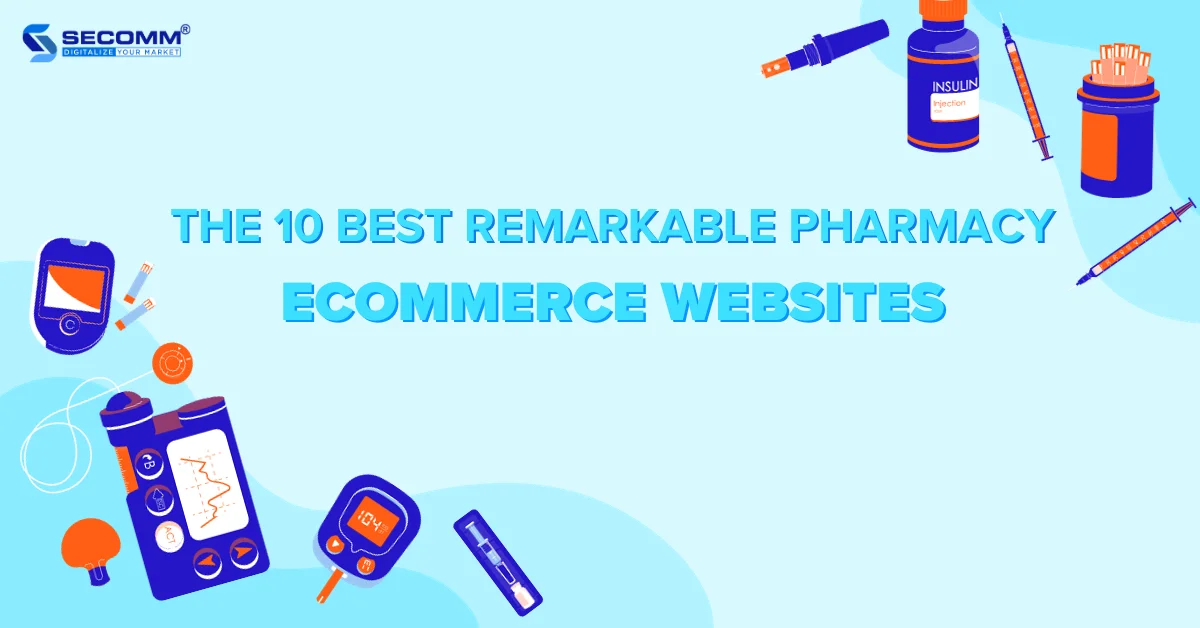
The eCommerce trend has quickly extended to various sectors of the economy. The explosion of online pharmacies, both domestically and internationally, demonstrates the significant impact this trend is having on the pharmaceutical industry.
Typically, the first step in the online presence strategy of these pharmacies is the professional establishment of an eCommerce website.
Here are 10 pharmaceutical brands in Vietnam and on the global stage that have effectively launched eCommerce websites and swiftly captured a significant share of this market.
CVS Health is a major player in the U.S. healthcare sector and stands as the largest retail pharmacy chain in the country, boasting over 9,900 physical stores. CVS also offers an array of healthcare services, encompassing general health check-ups, diagnostics, and dental care.
The CVS pharmacy eCommerce website is built upon the Oracle Commerce platform, equipped with numerous features to ensure an optimal user experience and scalability for the future. Notably, it includes a prescription management feature that empowers customers to oversee their prescriptions through their CVS accounts, request prescription refills, and receive medication deliveries at their doorstep. Furthermore, the online drugstore allows customers to schedule appointments with two options: in-person clinic visits or remote telehealth consultations via video calls.
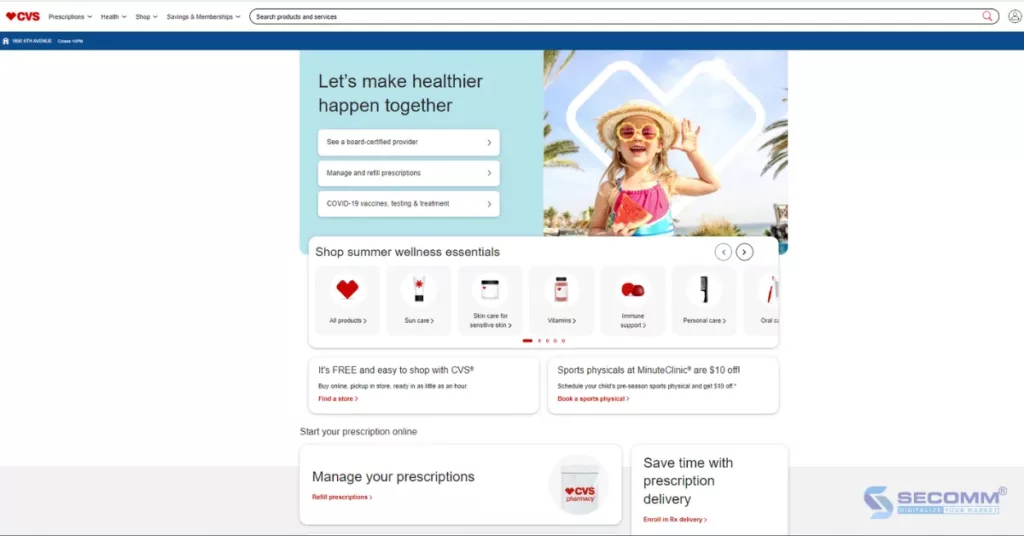
Established in 1890, Droga Raia has continually grown and, over the years, has become one of the foremost pharmacy chains in Brazil. Despite its long-standing legacy, Droga Raia hasn’t lagged in the eCommerce trend.
With an average monthly website traffic of 19.8 million, Droga Raia opted for Magento to facilitate its pharmacy eCommerce website. This choice was well-founded, given the platform’s superior flexibility for customization and scalability, ensuring the capability to manage high traffic volumes and cater to future system expansion needs.
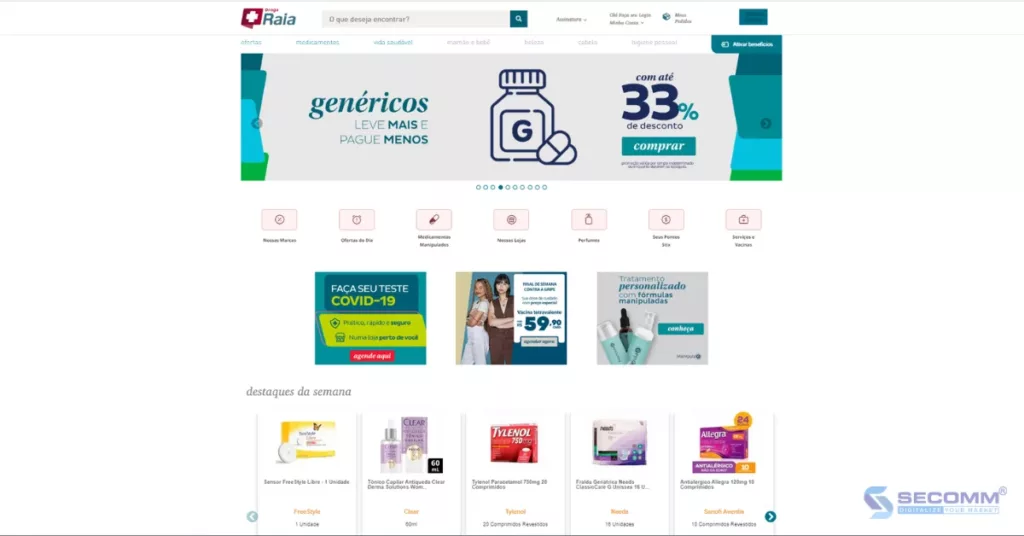
Apollo Pharmacy, a well-known retail pharmacy chain in India, operates as a subsidiary of Apollo Hospital. Over the years, Apollo has expanded its chain of stores to thousands, serving cities and towns across India.
Apollo built its online pharmacy on the Magento platform, equipped to manage a vast product portfolio. In addition to offering both prescription and non-prescription medications, as well as healthcare products, Apollo provides various related services. These services encompass online consultations, health check-up appointment scheduling, vaccination bookings, and insurance sales. Currently, the website garners 12.7 million monthly visits.
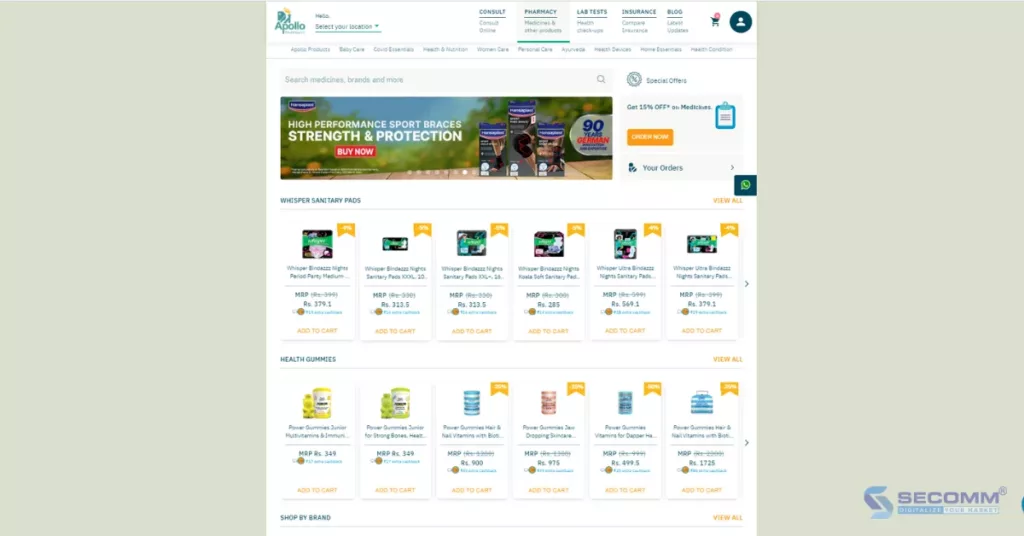
Another well-known online drugstore in India is Netmeds. In addition to prescription and non-prescription drugs, this brand offers a diverse range of healthcare products, including items for maternity and baby care, medical equipment, and dietary supplements for fitness enthusiasts, vegetarians, and those with diabetes. Netmeds also relies on Magento to develop its pharmacy eCommerce website, featuring various capabilities to enhance the user experience. These include product categorization with accompanying images, non-prescription product search recommendations, real-time product availability checks at specific stores, prescription upload options, and home delivery requests. At present, Netmeds’ website averages around 10.4 million monthly visits.
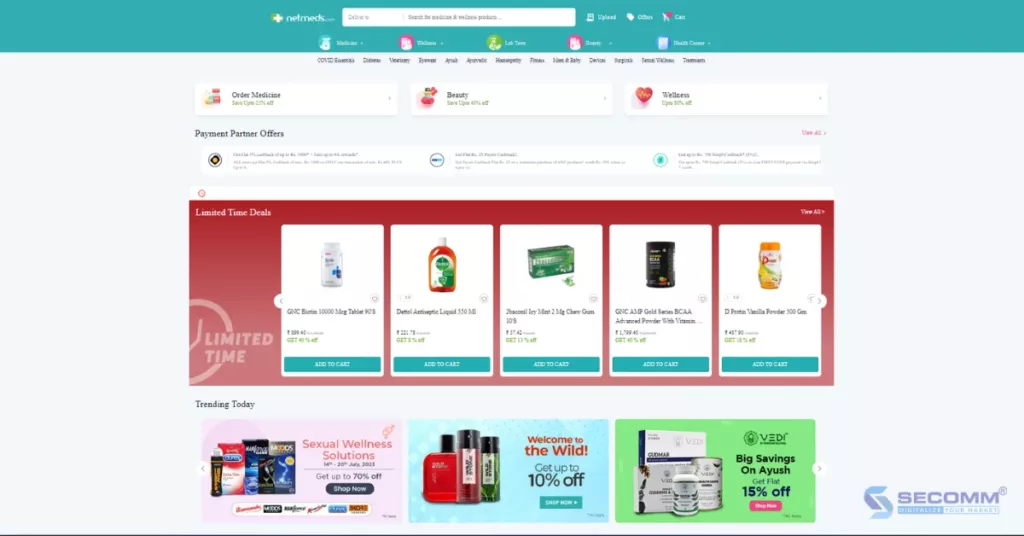
Nahdi Online is the leading pharmacy eCommerce website in Saudi Arabia and ranks among the region’s largest retail pharmacy chains. This marks the fourth pharmacy on the list utilizing the Magento platform to craft a user-friendly website enriched with advanced features, facilitating product-specific searches, in-depth product descriptions, and price comparisons for customers. Moreover, through Nahdi’s online pharmacy, users can access various online consultation and healthcare services or book appointments at the clinic.
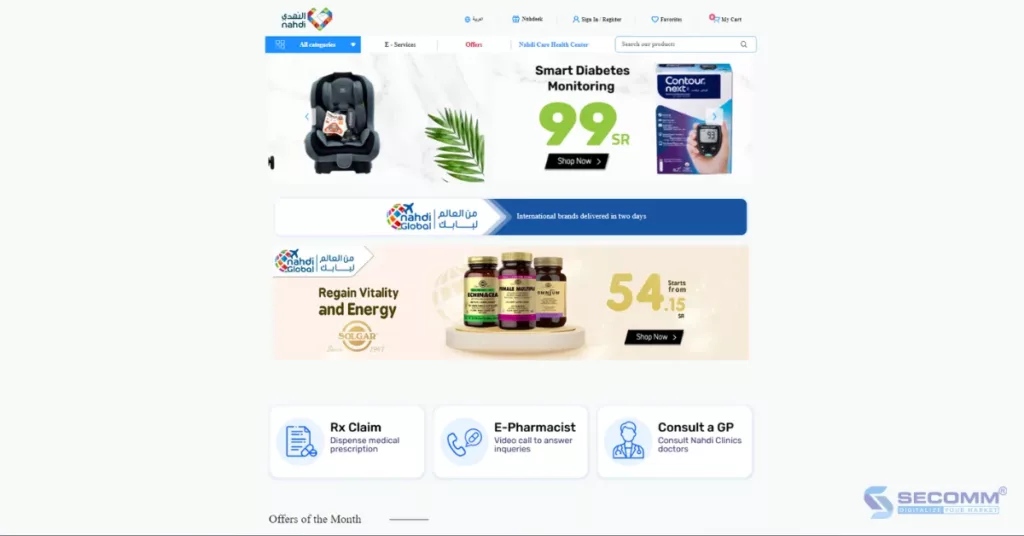
An Khang Pharmacy, one of the most trusted pharmacy chains in Vietnam, was established in 2012 and has since expanded to over 500 pharmacies nationwide. Additionally, the brand has introduced a pharmacy eCommerce website and a mobile app to cater to consumers’ online pharmaceutical needs, complete with a variety of enticing offers.
An Khang provides a wide array of products, including medications, dietary supplements, medical equipment, personal care items, and cosmetics. Moreover, the An Khang website features a dedicated section for disease lookup, allowing customers not only to make purchases but also to access information on various common diseases, including their causes, symptoms, treatment methods, and prevention.

FPT Long Chau, established in 2015, has a presence in over 1,000 stores across all 63 provinces in Vietnam and is a pioneer in the modern online pharmacy model. Both its pharmacy eCommerce website and app have gained strong favor from consumers for their rich and seamless shopping experience.
Notably, Long Chau leads the way in offering a Buy Now, Pay Later service with 0% interest, helping to ease the financial burden on patients. Furthermore, customers can access guidance from Long Chau’s experienced pharmacists through a hotline or chat service. Currently, the Long Chau website attracts approximately 5.2 million monthly visitors.
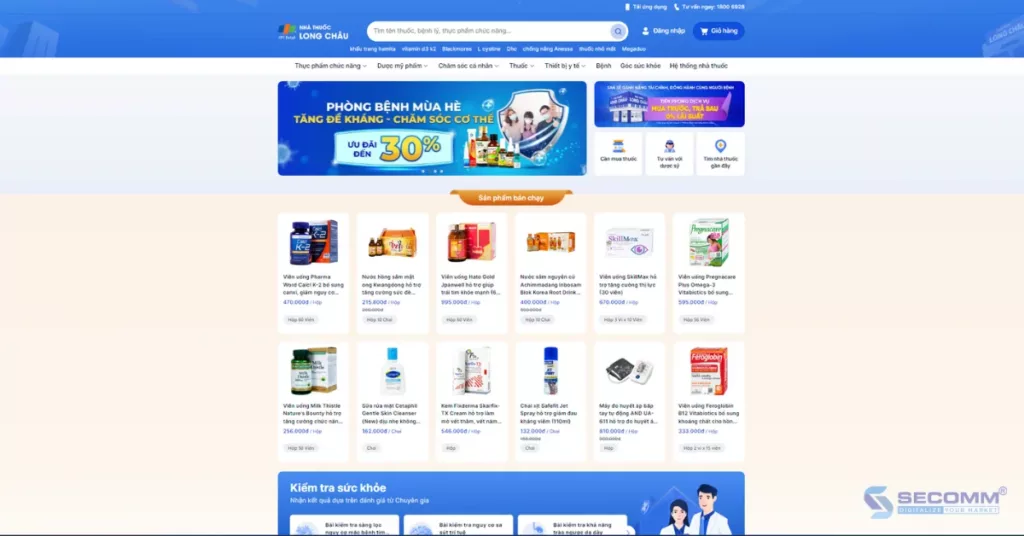
In the pharmaceutical market of Vietnam, Pharmacity is the third name mentioned in the fierce “three-horse race” taking place in both the online and offline channels. This company was founded in 2011 and currently has over 1,000 stores nationwide. Similar to An Khang and Long Chau, Pharmacity has also launched an eCommerce website and app with various promotional programs to provide customers and patients with a convenient and quick shopping experience, along with online consultation services from a team of highly professional pharmacists. Currently, the Pharmacity website attracts an average of 2.7 million monthly visitors.
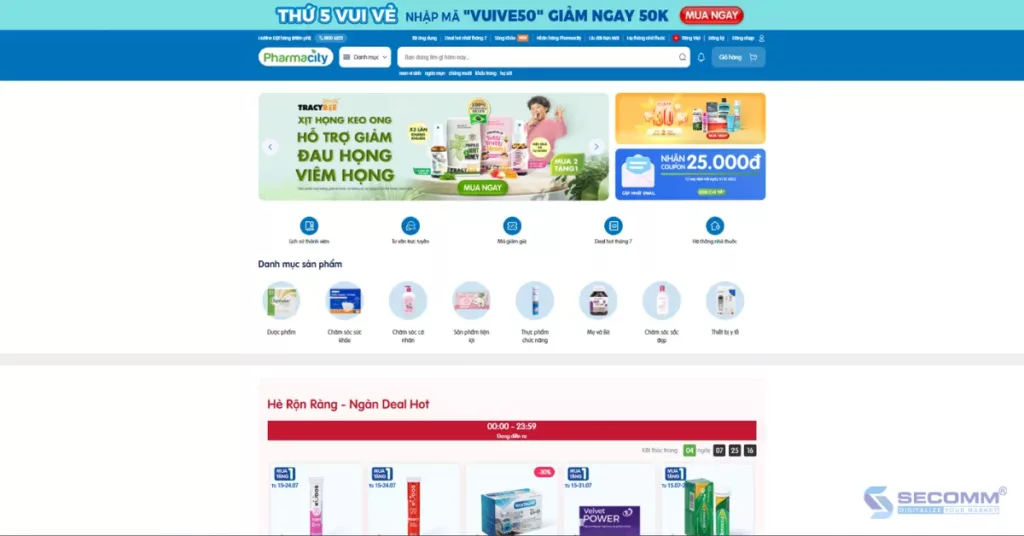
This is one of the most reputable and high-quality online pharmacy systems in Vietnam. The pharmacy offers a wide range of genuine pharmaceutical products, dietary supplements, health, and beauty care items from major global brands. Central Pharmacy’s drugstore provides various features to enhance the shopping experience for customers, such as search suggestions, search filters, and integration of messaging applications (FB Messenger and Zalo) on the website for customer support, prescription uploads, and home delivery requests. To date, the website has attracted more than 587,000 monthly visitors.
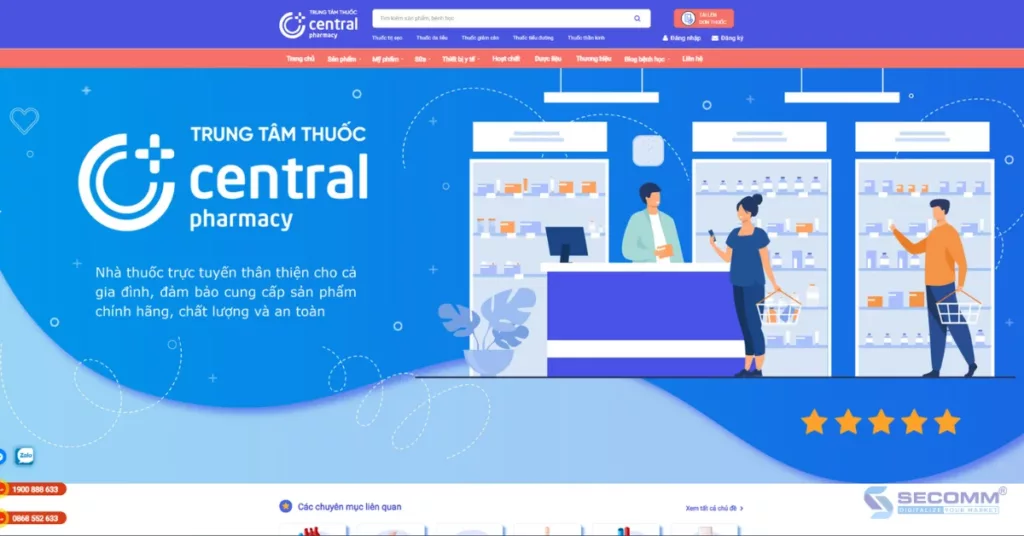
Nha Thuoc Than Thien is a retail chain that meets GPP standards in Vietnam. Specializing in prescription and over-the-counter medications, as well as various healthcare products, this establishment has embraced a hybrid model, combining both offline and online pharmacy services. The primary sales channel is its user-friendly eCommerce website, developed using WooCommerce. The website is intuitively designed, incorporating essential features to facilitate customer product searches, seamless transactions, and order tracking. With around 410 thousand monthly visits, the website continues to serve a significant audience.
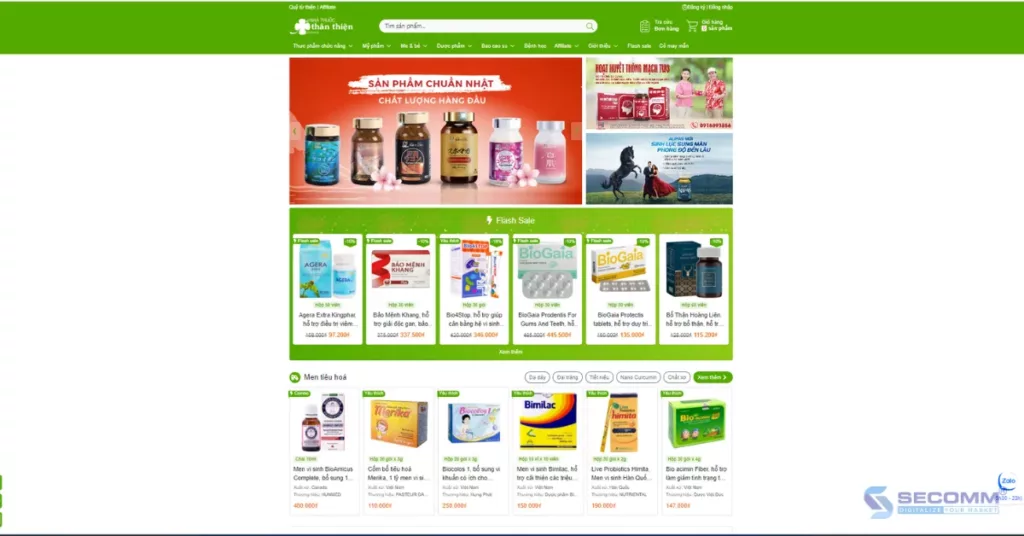
Here are the top 10 eCommerce websites, including leading online pharmacies, in both the Vietnamese and international markets. These brands demonstrate their adaptability to consumer trends and their efforts in developing technological infrastructure to compete in the multibillion-dollar market.
With a wealth of experience in successfully implementing eCommerce solutions for numerous clients across various countries in recent years, SECOMM specializes in providing consulting services with professional eCommerce deployment solutions tailored to the specific needs of each industry.
Feel free to contact or call SECOMM’s hotline directly at (02871089908) for a free consultation.
 2
2
 12,947
12,947
 0
0
 1
1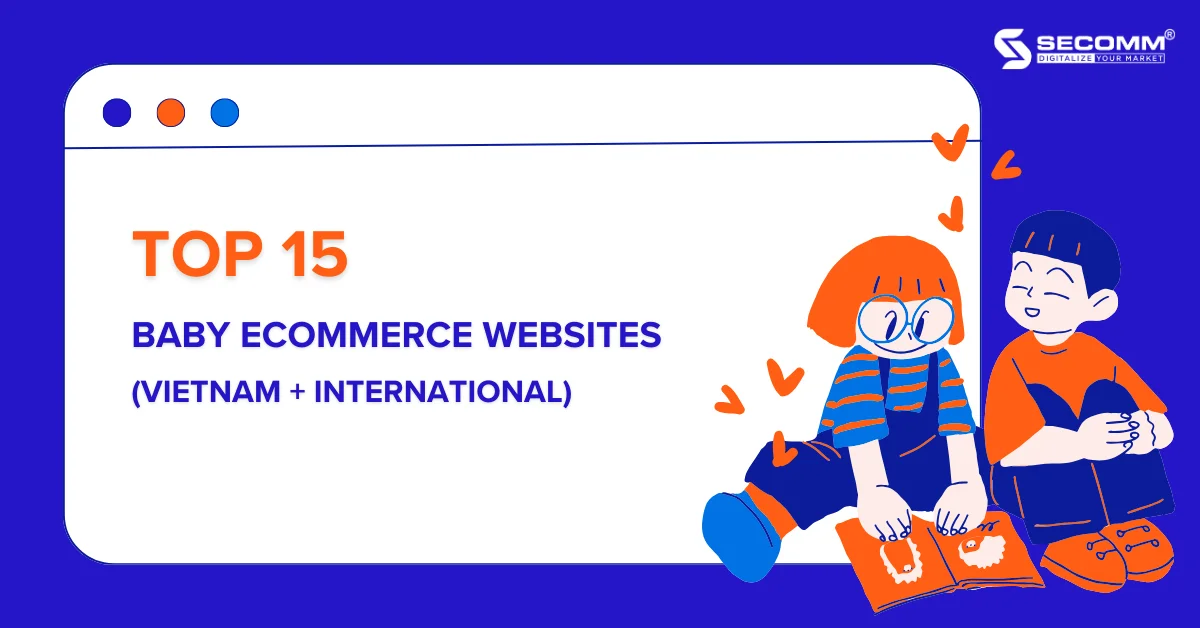
The global business landscape has faced significant challenges due to the Covid-19 pandemic. In response to this, many businesses across various sectors, particularly in the Baby industry, have prioritized the implementation of eCommerce strategies to connect with online customers and drive sales. Furthermore, to align with the broader economic trends, these retailers have transitioned from traditional business models to robust eCommerce operations to ensure growth and market expansion.
The following list showcases 15 successful Baby brands in Vietnam and around the world that have effectively adopted eCommerce websites, thus facilitating the swift participation of numerous other businesses.
Ava Kids is the Baby eCommerce website of The Gioi Di Dong Corporation, offering a range of enticing online shopping benefits to customers. These include a 1-month return policy, complimentary shipping, special discounts for new customers, a rewards program, and informative guides for maternal and child health care.
Having been in operation for over a year, Ava Kids’ eCommerce website now enjoys over 2.1 million monthly visitors and has expanded its offline store network from 5 to 66 outlets.
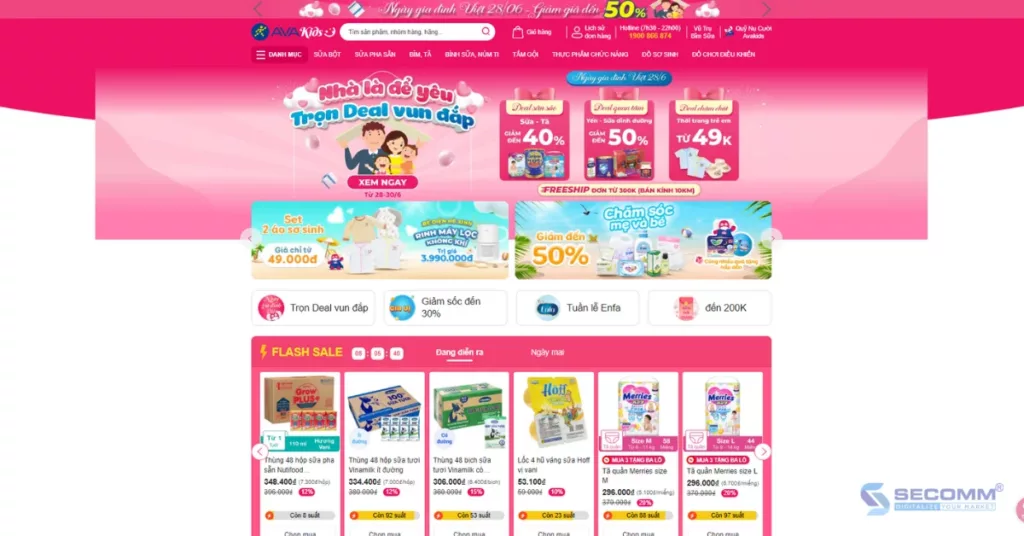
Established in 2011, Con Cung has grown to become Vietnam’s leading retail chain specializing in products for expectant mothers and babies, boasting over 700 stores across the country.
In recent years, Con Cung has made significant strides in developing its eCommerce website, catering to the online shopping demands of its customers. This expansion has enabled them to provide a rich shopping experience with a wide range of enticing offers, flexible payment methods, and 1-hour delivery services.
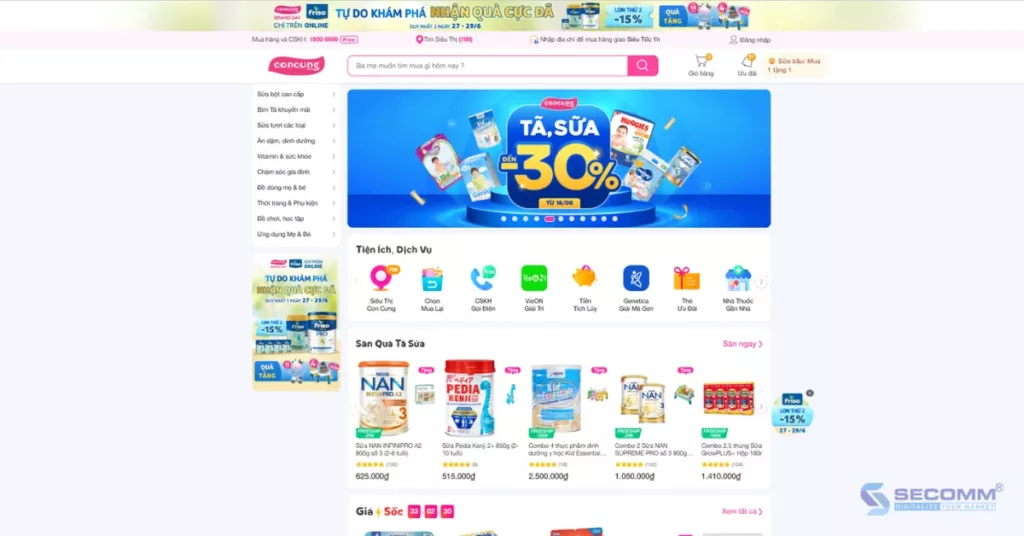
Founded in 2009, Kids Plaza is a major player in the eCommerce competition for the Baby industry. Kids Plaza has built an eCommerce website on the Magento platform to efficiently manage a vast and diverse product catalog. The brand consistently runs enticing promotional campaigns, offering gift-with-purchase deals, flash sales, buy-5-get-1-free offers, and a loyalty points system for redeemable rewards. These efforts have significantly driven up website traffic during promotional events, making Magento’s customization and scalability features indispensable for handling sudden surges in visitor numbers. On average, the website garners approximately 1 million visits per month.
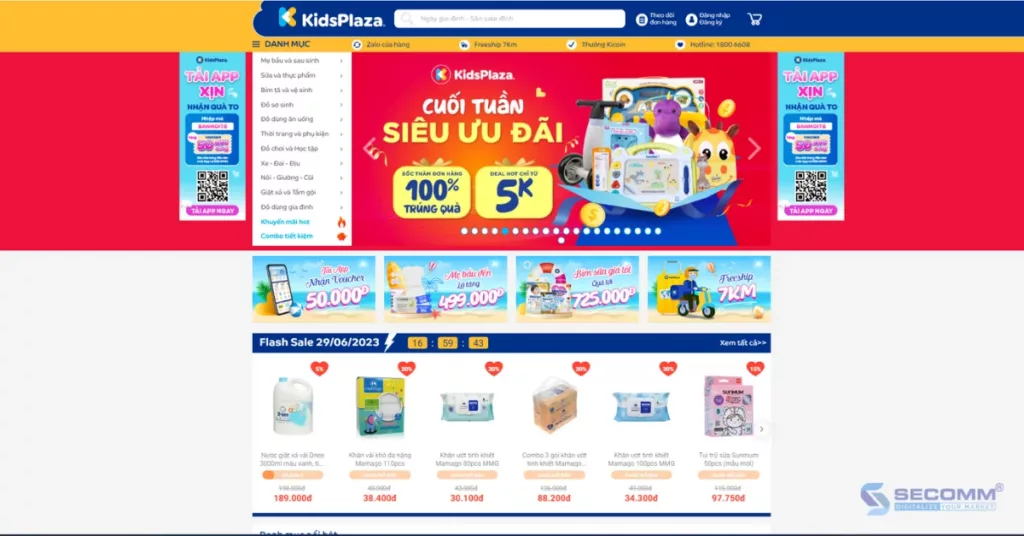
Founded in 2006, Bibo Mart, a retail chain dedicated to serving expectant mothers and babies, offers a diverse range of products, including maternity clothing, diapers, formula, and strollers. Just like its competitors, Bibo Mart is a strong contender in the eCommerce race.
To enhance the customer shopping experience, Bibo Mart opted for Magento Enterprise Edition (aka Adobe Commerce) to develop a custom eCommerce website. This platform enables the implementation of attractive promotions and a Loyalty Program. Presently, the website enjoys more than 500,000 monthly visitors.
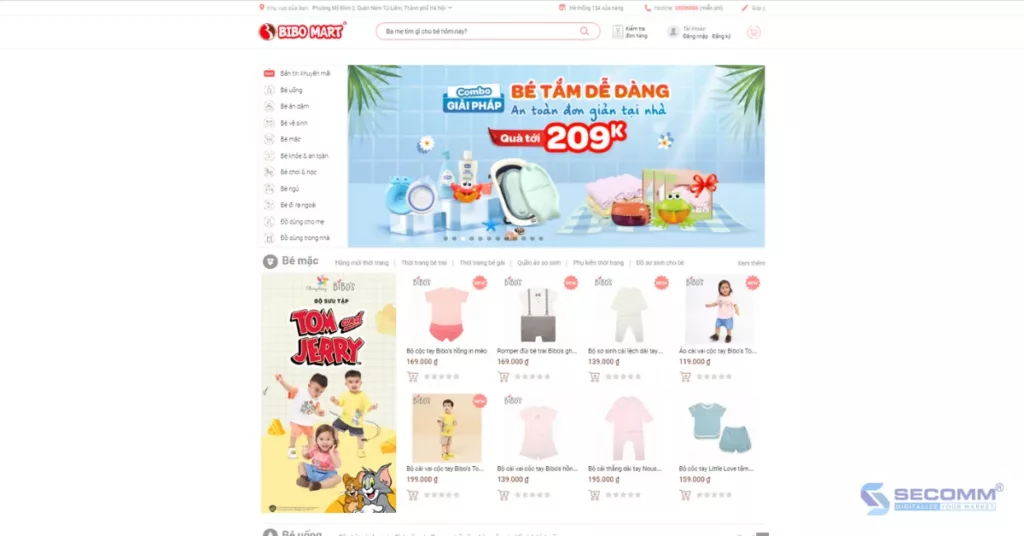
Shop Trẻ Thơ stands as a well-known brand in the Maternity & Baby sector. The company is dedicated to establishing and advancing its eCommerce website alongside its network of 22 physical stores. This strategic move is aimed at staying in sync with the online shopping trend and securing a competitive edge in the realm of eCommerce.
Beyond a diverse product catalog, Shop Trẻ Thơ offers various enticing incentives to encourage online shopping, such as Buy 1 Get 1, cost-saving combos, gifts with purchase, discounts for new customers, and more. Currently, the website maintains a stable traffic of over 100,000 visitors per month.
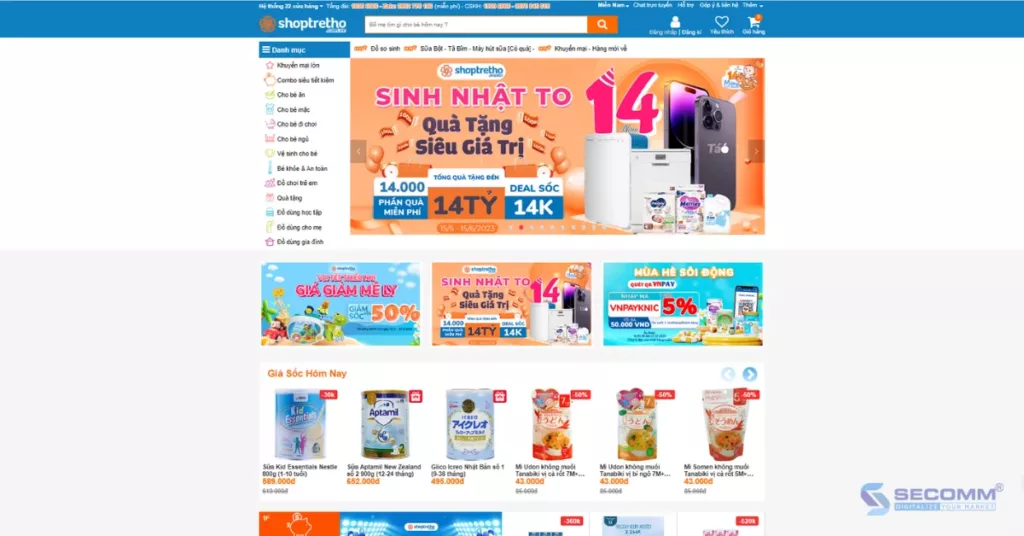
Tuticare is considered a prominent brand in the Maternity & Baby industry with a chain of 55 stores across Vietnam. Tuticare’s products undergo stringent checks, from their origins to their quality, providing a sense of assurance to mothers during their shopping experience.
The company has started an eCommerce website to provide customers with an optimized online shopping experience, along with various attractive programs and offers like a Tuti Gift Card, a subscription for diapers and milk, and more. Additionally, Tuticare offers diverse payment options, including eWallets and buy now pay later.
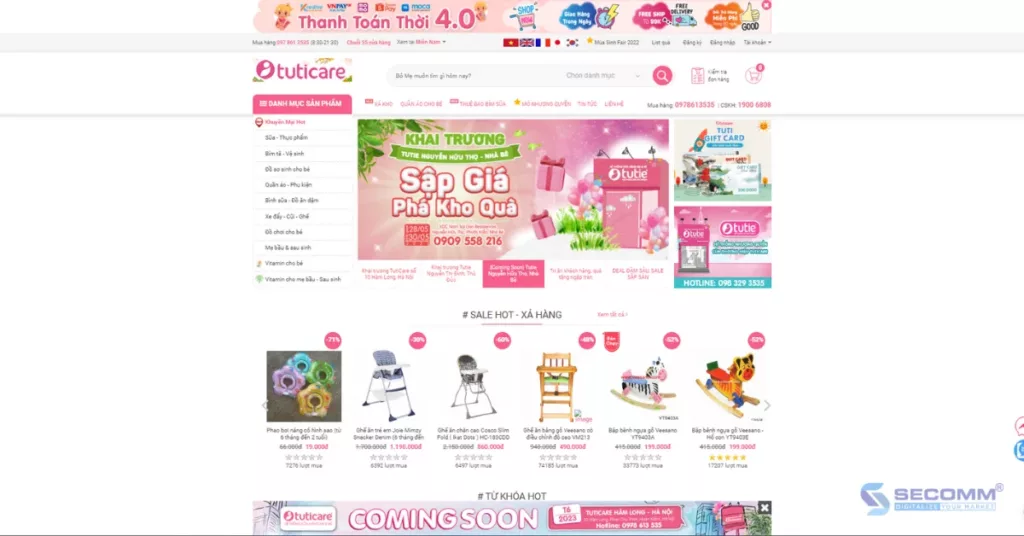
Mothercare, a brand focused on Baby products from the United Kingdom, offers a diverse range of fashion and essential items for expectant mothers and children of various age groups. Despite its recent inception, Mothercare has rapidly garnered attention, primarily due to its commitment to providing high-quality products at affordable prices.
The Mothercare website is strategically developed using the Magento platform, effectively catering to the online shopping preferences of their customers. Beyond attractive promotional programs, the Mothercare website also provides valuable insights on caring for newborns and young children through its dedicated blog section.

Soc & Brothers is a rising name in the Baby eCommerce market, offering a diverse range of products for expectant mothers and children, including clothing, formula, diapers, strollers, and toys. The company has built an eCommerce website using Haravan and receives approximately 28,000 monthly visitors. Moreover, Soc & Brothers has implemented a Loyalty Program with three tiers: Silver, Gold, and Diamond, which can be utilized for purchases and point accumulation both at their offline retail stores and various online channels.
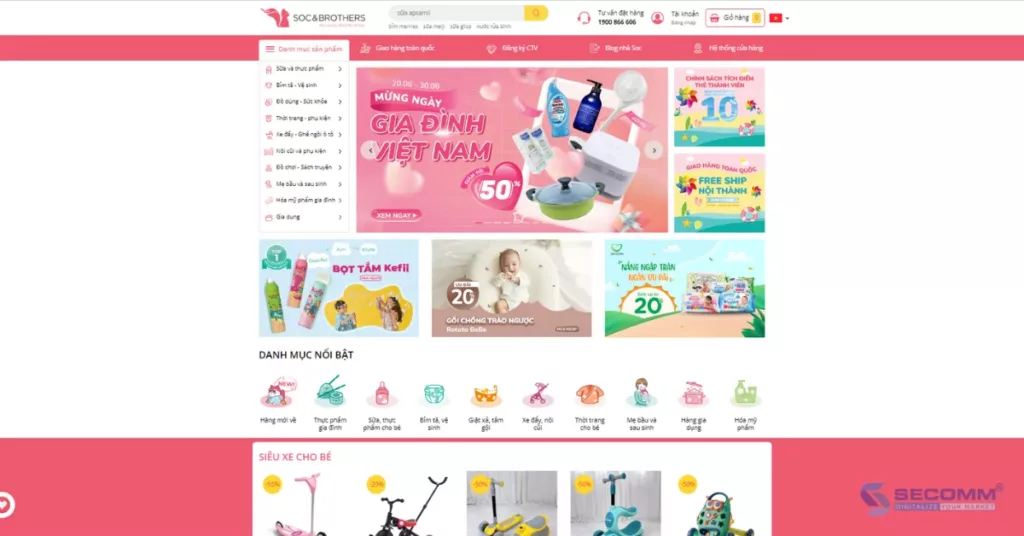
Carter’s is a well-known children’s clothing brand in the North American region. Carter’s offers a wide range of products suitable for children of all ages, heights, and weights. Their website is built on Salesforce Commerce Cloud and features a primary color scheme of blue and white, emphasizing minimalism and cuteness. Currently, the website receives about 8.4 million monthly visits. Moreover, customers can purchase physical or eGift cards through the website, which can be customized in terms of design, value, and personal messages.
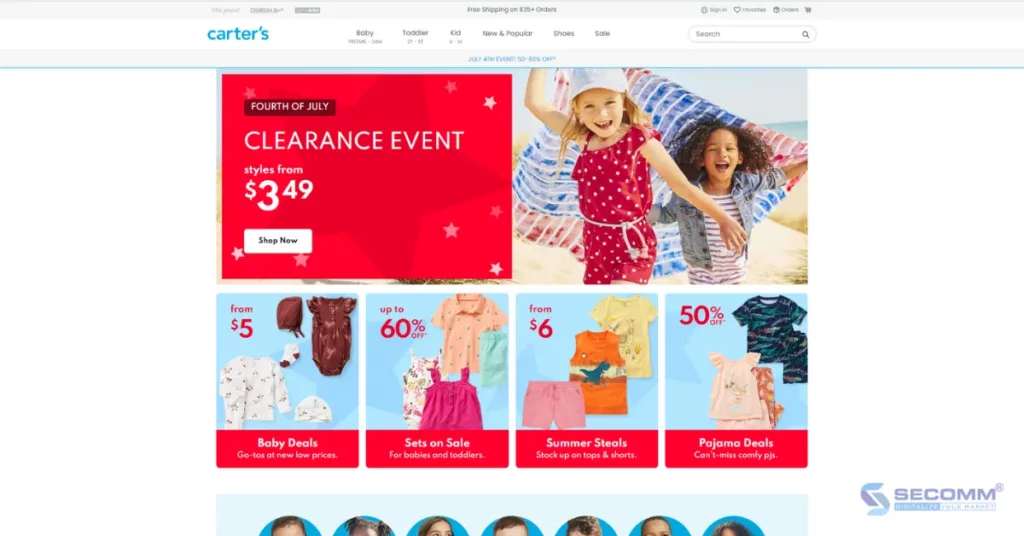
Hanna Andersson is a well-known Swedish brand that specializes in children’s clothing, offering beautiful designs and a wide range of styles, sizes, and types of clothing, from everyday wear to sleepwear and swimwear. Hanna Andersson’s eCommerce website is built and developed using the Salesforce Commerce Cloud platform and garners more than 1.4 million monthly visitors. Hanna provides a personalized shopping experience by inviting its customers to participate in clothing selection consultations, parenting advice, and direct communication for new customers.
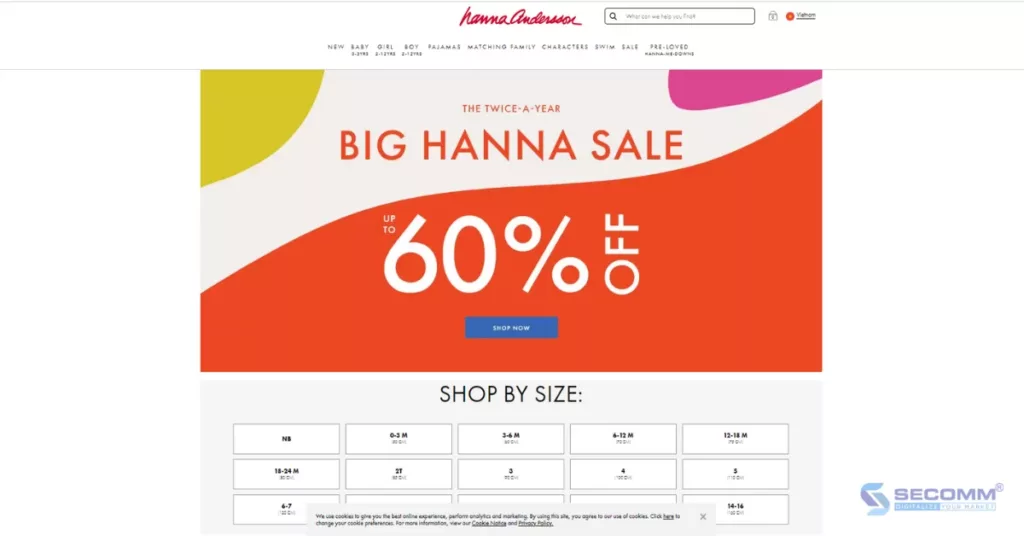
OshKosh, a globally beloved children’s clothing brand, has achieved significant success by utilizing Salesforce Commerce Cloud to create an eCommerce website that delivers an exceptional online shopping experience. Presently, the website receives more than 900,000 monthly visitors and provides numerous appealing shopping incentives to its customers, including a rewards program that offers unexpected gifts, birthday presents, and discount vouchers.
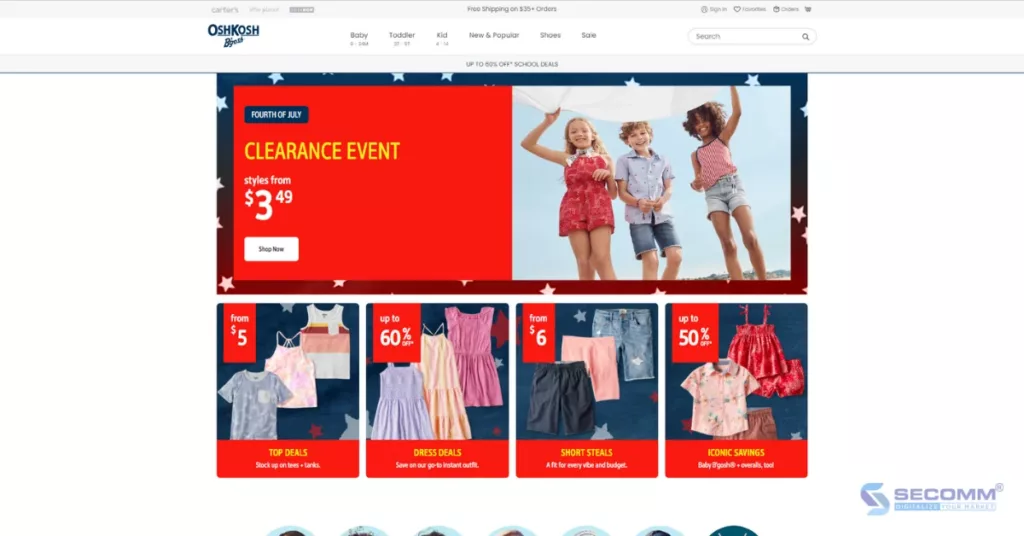
Janie and Jack, another children’s fashion brand, has built an eCommerce website using the Salesforce Commerce Cloud platform. The company provides a wide variety of products for boys, girls, infants, as well as items such as jewelry and home decor. Notably, Janie and Jack has entered into a collaboration with Disney to offer fashion items featuring beloved Disney characters for children.
Additionally, the brand offers a gift-wrapping service that allows customers to select their preferred products, gift boxes, wrapping paper, and greeting cards. Customers can choose to wrap gifts themselves or take advantage of Janie and Jack’s professional gift-wrapping service.

Children Salon, established in 1952, is one of the leading brands in high-end fashion for children. They offer many products, including clothing, shoes, and hats for boys, girls, and teenagers. The company specializes in designing and producing children’s fashion collections for top global brands such as Versace, Givenchy, Burberry, Dolce & Gabbana, Calvin Klein, and more. Additionally, customers who purchase these designer products on the Children Salon website can enjoy discounts of up to 60%.
Children Salon’s eCommerce website is built on the Magento platform, featuring advanced functions like filtering products by size and age, displaying available sizes, and currency conversion for product prices, among others. The website currently receives over 600,000 monthly visits.

Motherhood Maternity’s eCommerce website is a well-known and trusted fashion shopping destination for expectant mothers. The website, built on the Shopify platform, garners around 400,000 monthly visits.
Beyond its wide array of clothing and supportive accessories, Motherhood offers an “Expert Guide” section dedicated to sharing valuable knowledge about prenatal healthcare. Furthermore, the “Preggie Perks” program allows customers who shop on the website to have the chance to receive discount vouchers or unique gifts, conveniently delivered with their products to their doorstep.

HATCH Collection, a renowned global brand, specializes in offering fashion and beauty products for expectant mothers. Despite its establishment in 2011, the brand has chosen to maintain only two physical stores in California and New York, as HATCH’s primary focus lies in online retail.
Operating through its eCommerce website, HATCH has introduced several programs for their customers. One notable initiative is “NIKKI’s List,” wherein customers respond to specific questions, enabling HATCH to generate personalized product recommendations. The HATCH website is constructed and managed using the Shopify platform and receives approximately 223,000 monthly visits.

The surge of the Covid-19 pandemic has made a significant impact on consumer shopping habits, particularly in the Baby sector, where a profound shift from offline to online shopping has been witnessed.
Presented here are 15 eCommerce websites, showcasing leading brands in the Mother & Baby industry, both in Vietnam and internationally. These brands exemplify their adaptability in capturing consumer trends and their commitment to enhancing technological infrastructure to compete for a share in the billion-dollar market.
With a track record of successfully implementing eCommerce solutions for a diverse clientele across various countries in recent years, SECOMM specializes in offering expert consultation and tailored eCommerce deployment solutions, tailored to the specific requirements of each industry.
For a free consultation, contact us or call directly to the SECOMM hotline at (02871089908).
 2
2
 13,695
13,695
 0
0
 2
2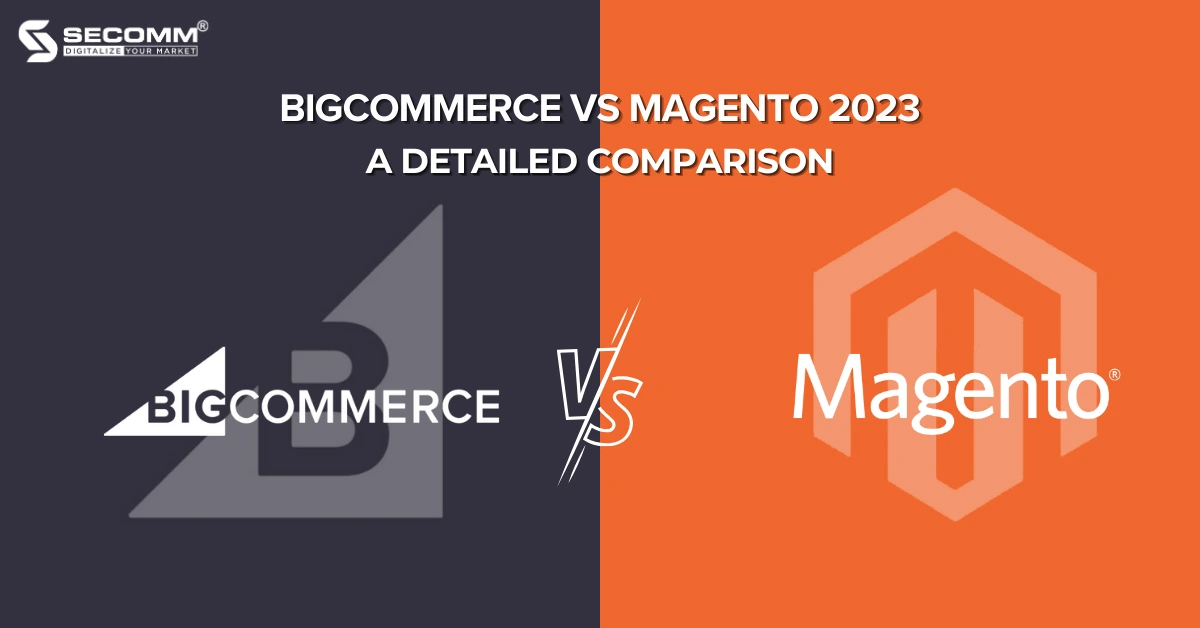
BigCommerce and Magento are trusted names representing two types of eCommerce platforms: SaaS and Open Source. The demand for developing eCommerce websites on these platforms is increasing. However, deciding between the two is a complex task.
This article aims to highlight the pros and cons of each and provide a thorough comparison, helping you as a business make informed decisions.
BigCommerce is a robust SaaS eCommerce platform, boasting an array of integrated features packaged to accommodate businesses of all scales and technical proficiencies. This platform facilitates the swift development of eCommerce websites. Beyond its inherent capabilities, BigCommerce extends a diverse suite of tools and extensions covering sales, marketing, SEO, data analytics, and transformation, empowering businesses to drive eCommerce growth.
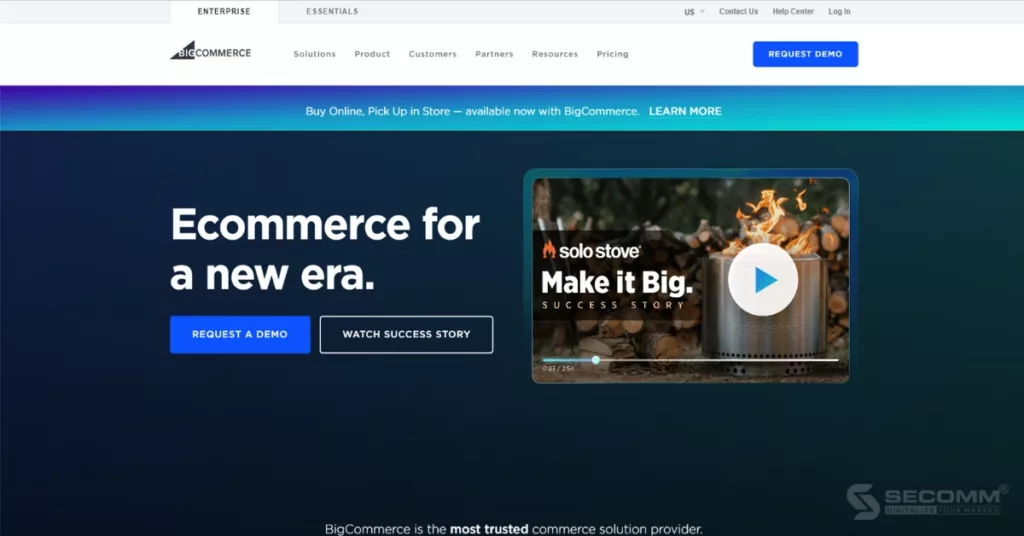
Magento (now owned by Adobe) is an open-source eCommerce platform that empowers businesses with full control over developing and managing their eCommerce websites. Known for its high level of customization and scalability, Magento offers a wide range of advanced features and extensions, making it an ideal choice for meeting the complex requirements of large-scale enterprises with ample budgets and a certain level of technical expertise. Magento currently comes in two main versions:
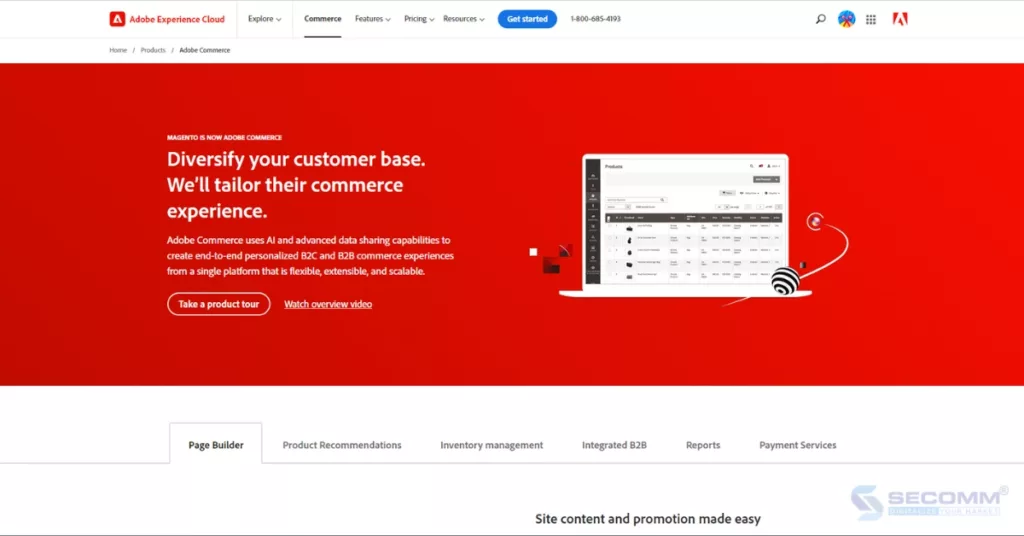
Pros:
Cons:
Pros:
Cons:
Ease of use of a platform is one of the primary considerations for an eCommerce business when selecting one. A platform with an intuitive interface that is easy to set up and manage allows businesses to focus on their core operations.
BigCommerce
BigCommerce is a SaaS platform, making it more accessible for businesses that may not possess technical expertise or have a strong tech background in building eCommerce websites. It eliminates the need for complex programming; businesses simply need to provide basic information to gain access to the BigCommerce dashboard, where they can configure and manage all aspects of their online store, from product additions to layout modifications.
What’s more, BigCommerce offers a user-friendly drag-and-drop page builder that empowers businesses to create a storefront without the necessity of coding skills. Moreover, themes and extensions can be swiftly integrated with just a few clicks.
Magento
On the other hand, Magento users should have a certain level of technical expertise to execute tasks during the setup of an eCommerce website, including configuring FTP files and integrating themes into the Magento website, among other things. Tasks like modifying themes, integrating extensions, applying security patches, and optimizing speed require coding skills.
Therefore, many businesses opt to collaborate with Magento agencies to develop and maintain their Magento eCommerce websites. However, following the initial technical setup challenges, businesses can readily customize attributes and functionalities for their websites through the platform’s backend.
BigCommerce
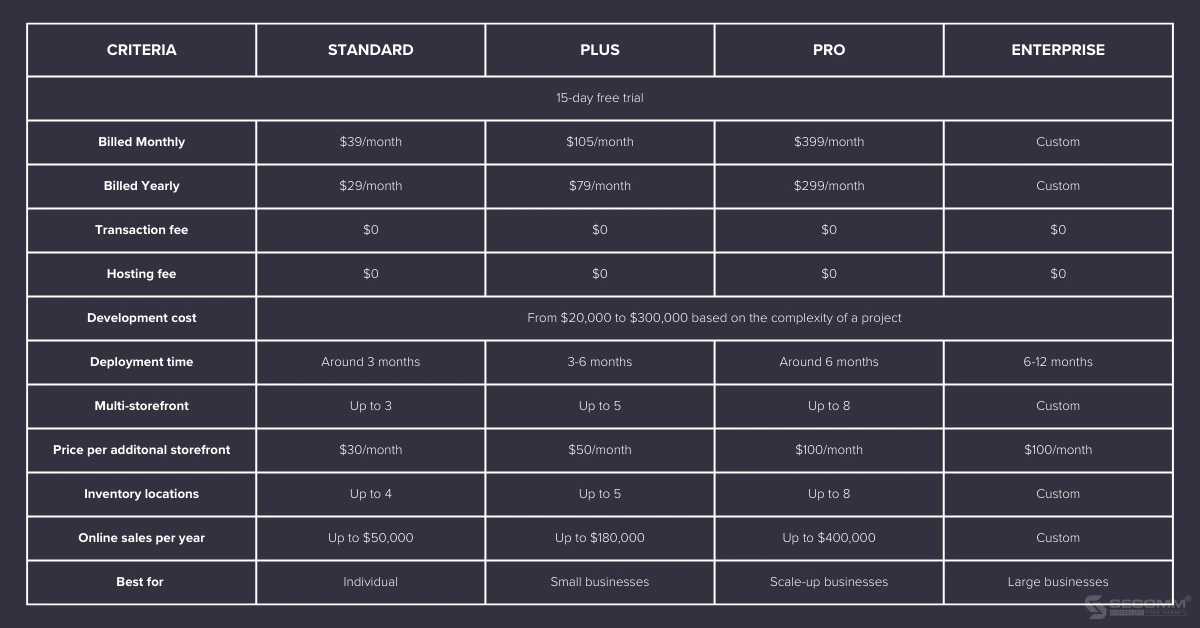
Magento
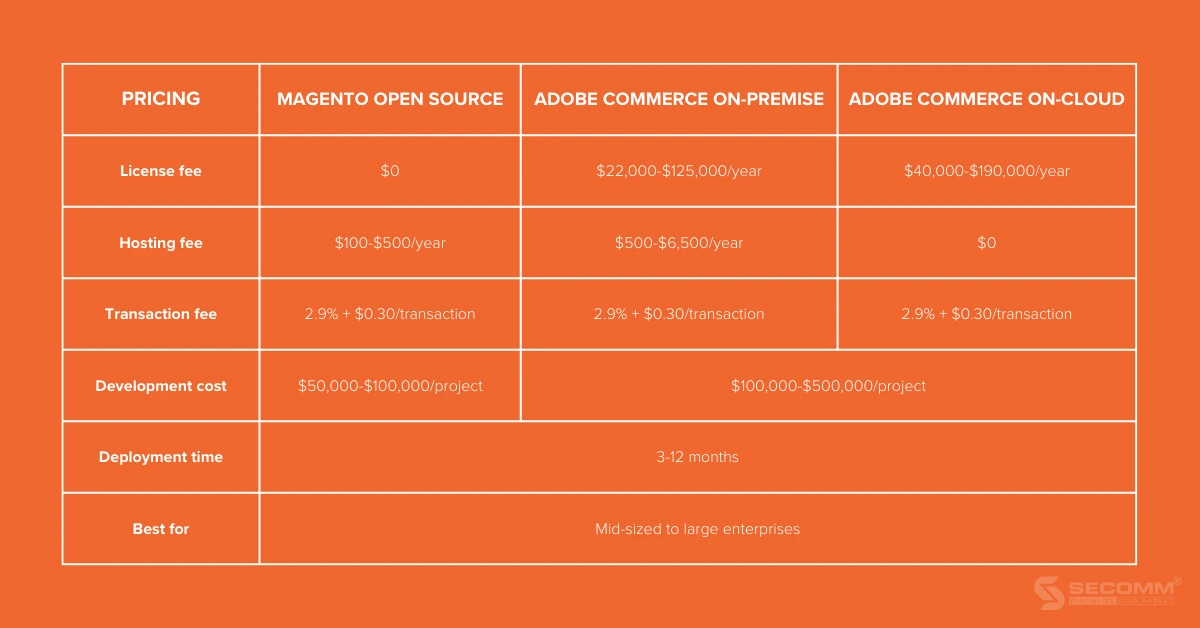
BigCommerce
Being a SaaS platform, BigCommerce offers support for various hosting-related issues, ensuring an impressive average uptime of 99.99%, quick page loading, and minimal website maintenance.
Magento
Adobe Commerce on-cloud: Hosting for the business’s Magento eCommerce site is provided, configured, managed, and stored on virtual servers offered by cloud service providers (CSPs) like AWS and Microsoft Azure.

SEO
SEO is a crucial feature that every eCommerce website needs and it’s an important factor for businesses to consider when assessing a platform. Both BigCommerce and Magento offer essential SEO optimization features, which include:
However, BigCommerce includes a built-in ‘blog’ feature in its solution packages, while Magento requires businesses to integrate a ‘blog’ extension to use this feature.
Plus, businesses can enhance their website’s SEO by using extensions available in the Magento and BigCommerce marketplaces. It’s worth noting that Magento offers a wider range of advanced SEO tools, although the cost of Magento extensions may be higher than those available for BigCommerce.
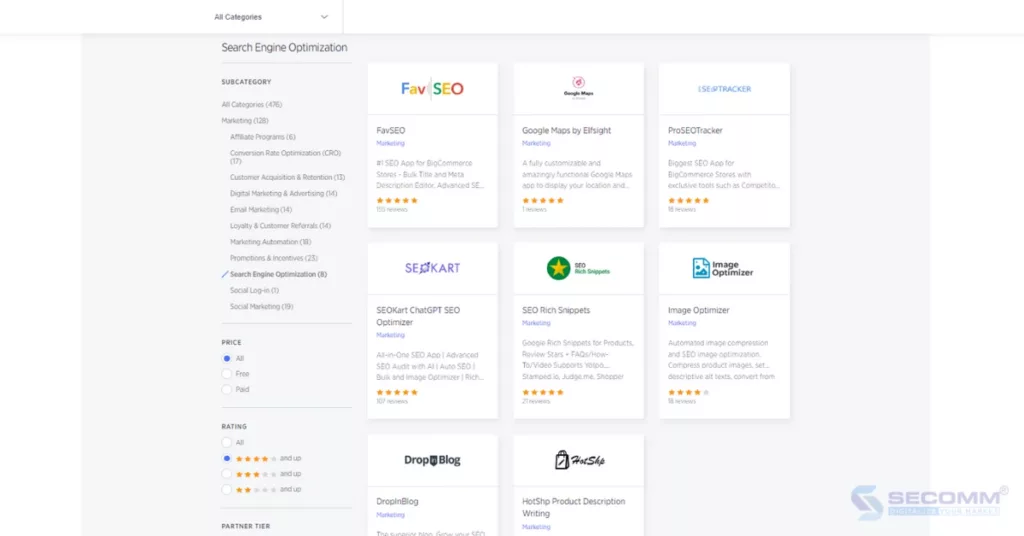
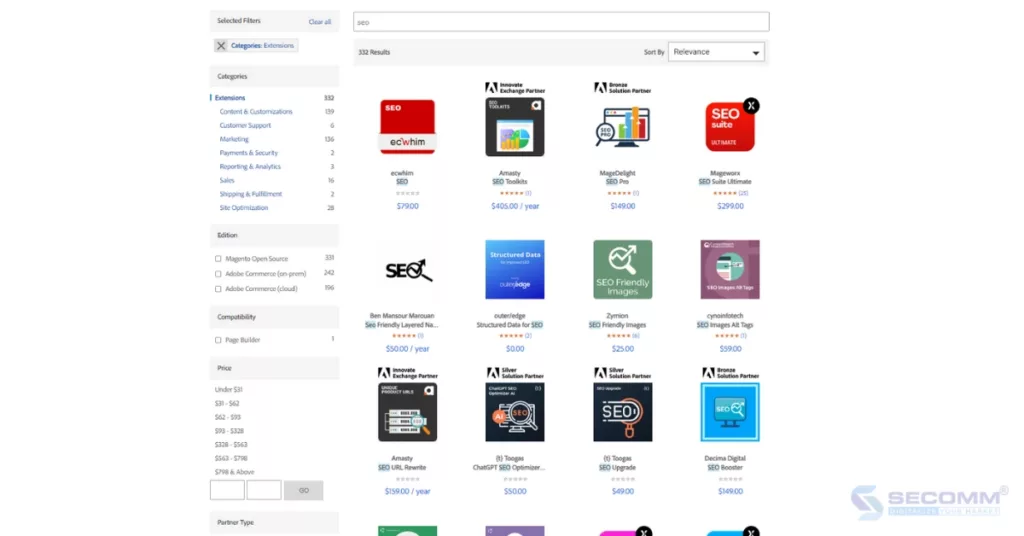
Multiple channels integration
With this feature, BigCommerce excels over Magento by pre-integrating the most prevalent sales channels like Amazon, eBay, Walmart, Facebook, and Instagram into all pricing plans. However, if businesses require integration with additional sales channels beyond these pre-set options, they can do so by utilizing apps from BigCommerce’s marketplace.
On the other hand, Magento offers businesses the flexibility to implement multi-channel sales by integrating various desired sales channels into their eCommerce website, each with its own associated costs. Notably, Amazon integration can be done for free.
Purchase flow
eCommerce businesses have to ensure a seamless, swift, and user-friendly customer buying journey, encompassing features like product search support and an effortless payment process. Both Magento and BigCommerce provide capabilities to facilitate online shopping, including
Payment options
BigCommerce provides businesses with 65 integrated payment gateways, including popular options like Apple Pay, Google Pay, and Amazon Pay, all with no transaction fee.
In contrast, Magento offers only PayPal and Authorize.net for payments, requiring businesses to integrate third-party payment providers for more choices. Magento’s marketplace features over 450 payment-related extensions with various costs, but businesses will need time to select and integrate them.
Aside from features, themes, and extensions also contribute significantly to the growth of an eCommerce website. Therefore, this is another factor that businesses take into account when selecting a platform.
BigCommerce
The platform provides 266 themes with prices ranging from $195 to $395, including 12 free themes. Businesses can purchase BigCommerce themes on ThemeForest at prices ranging from about $16 to $179.
These designs are modern, suitable for various industries, and offer good responsiveness across multiple screen sizes, including smartphones, tablets, and desktops. However, when compared to other SaaS platforms like Wix or Squarespace, BigCommerce’s customization options and the quantity of both free and paid themes may appear relatively limited. Moreover, the exact count of free and paid themes might not be entirely precise, as some themes share very similar layouts, differing mainly in color schemes.
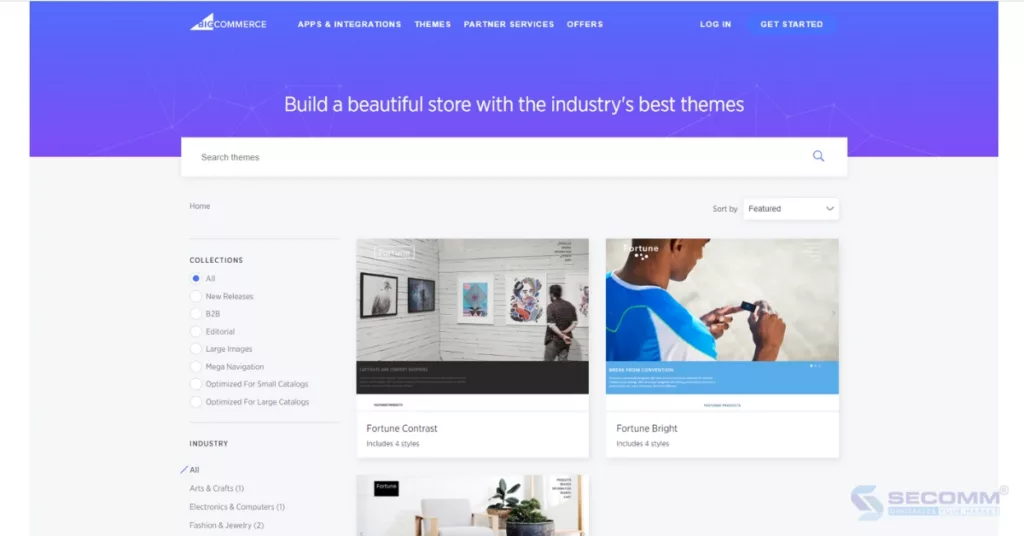
Magento
Unlike BigCommerce, Magento provides a limited selection of themes, with just 9 options available. Among these, only 3 themes are free, while the rest range in price from $150 to $499 each. If businesses opt to purchase Magento themes on ThemeForest, they can expect prices ranging from $39 to $299 per theme.
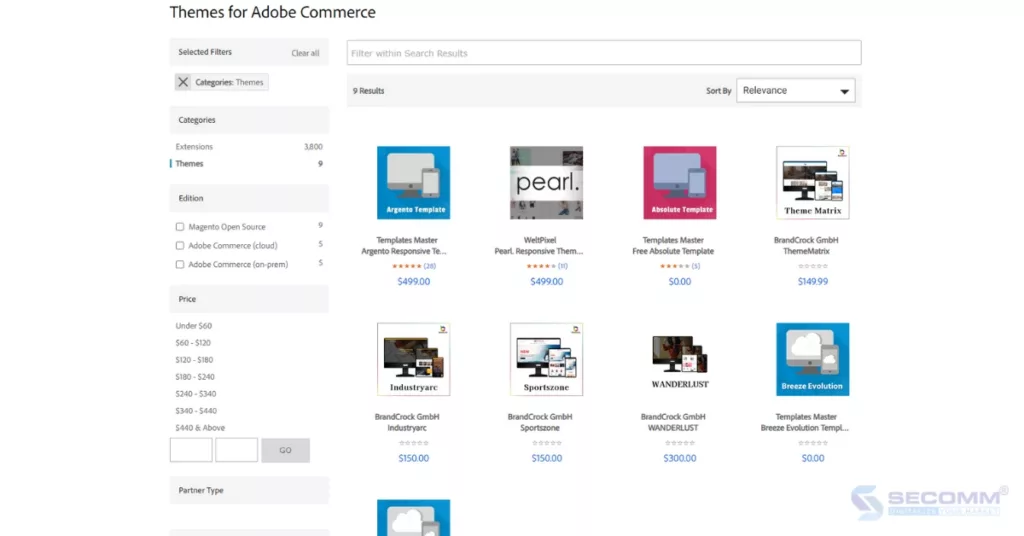
Moreover, businesses have the option to create custom interfaces tailored to their unique requirements by partnering with specialized providers, incurring costs typically ranging from $1000 to $5000.
Regarding extensions, both BigCommerce and Magento offer extensive extension libraries to support businesses in growing their eCommerce stores. However, Magento has a slight edge in this regard.
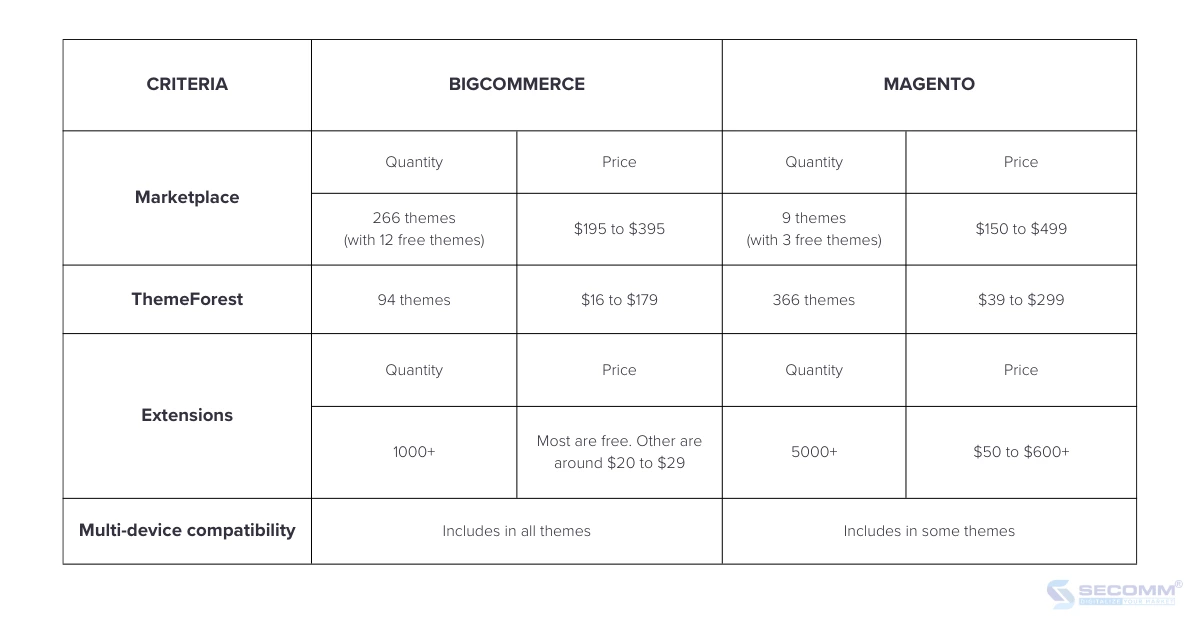
Customization involves the capacity to adjust any feature, theme, or integrated extensions to meet specific requirements for an eCommerce website. Scalability, on the other hand, refers to the ability to maintain platform performance as the eCommerce site expands. Therefore, these factors play a vital role in platform selection.
Customization
Magento operates as an open-source platform, giving developers full access to and control over the source code.
On the other hand, BigCommerce functions as a SaaS platform, restricting businesses from making backend modifications. While certain frontend interface adjustments are possible with a few code snippets, most modifications need to be done in the backend. Hence, BigCommerce’s customization is somewhat limited compared to Magento.
Scalability
Both Magento and BigCommerce can handle large website traffic and sales volumes. However, Magento outperforms BigCommerce in this aspect, which is also why Magento doesn’t have sales volume limits.
Meanwhile, BigCommerce imposes annual sales volume limits based on the pricing plan being used. When businesses reach the sales volume limit of their current pricing plan, they need to upgrade to a higher-tier plan.
Both BigCommerce and Magento are prominent names in the eCommerce industry, trusted by numerous businesses for their security features. Nevertheless, when it comes to providing security-related assistance, these platforms exhibit notable differences.
As a SaaS platform, BigCommerce includes security support as an integral component of its solution packages. This encompasses SSL certificates, firewalls, backups, and intrusion detection. In case any complications arise during the eCommerce deployment process, businesses can readily access 24/7 customer support for swift assistance.
In contrast, due to Magento’s open-source nature, businesses bear the responsibility for managing the security aspects of their Magento eCommerce websites. This entails tasks such as overseeing SSL certificates, implementing two-factor authentication, and adhering to PCI compliance. Additionally, while Magento periodically releases security updates, the manual update process can pose challenges for users without technical expertise.
Magento’s support options also present limitations when compared to BigCommerce. Businesses can seek assistance during Magento’s specified operating hours or engage with third-party intermediaries, a potentially time-consuming and complex process.
BigCommerce and Magento are both leading options for eCommerce businesses, but their levels of popularity differ somewhat.
According to BuiltWith, at the present time, there are 142,010 active websites using Magento, whereas there are only 44,796 active websites using BigCommerce.
Thus, when it comes to popularity, Magento has the upper hand.
Well-known brands such as Coca-Cola, Nike, and Tesla utilize Magento, while renowned brands like Skullcandy, LARQ, and Molton Brown opt for BigCommerce.
After many years of implementing eCommerce solutions for clients all around the world, using both the BigCommerce and Magento platforms, SECOMM has gained invaluable experience in helping businesses develop and operate their eCommerce websites quickly and efficiently.
Contact us or call SECOMM’s hotline directly at (02871089908) for a free consultation on implementing eCommerce websites with BigCommerce or Magento.
 2
2
 11,764
11,764
 0
0
 1
1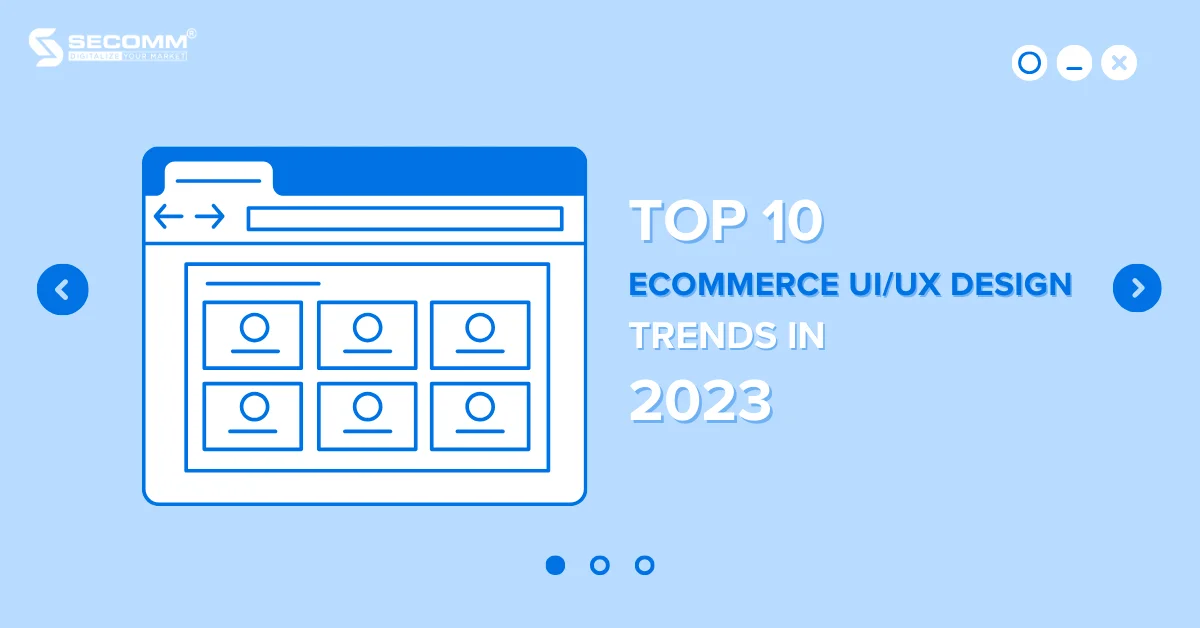
As new UI/UX design trends emerge, designers must stay up-to-date to create the most engaging and user-friendly interfaces for businesses. UI/UX design plays a vital role in crafting excellent user experiences and improving online business efficiency.
In this article, SECOMM will discuss the latest UI/UX design trends for the year 2024 and beyond
User Interface (UI) and User Experience (UX) are often regarded as two interrelated aspects when it comes to designing interfaces for any online product or service, especially in the case of eCommerce websites.
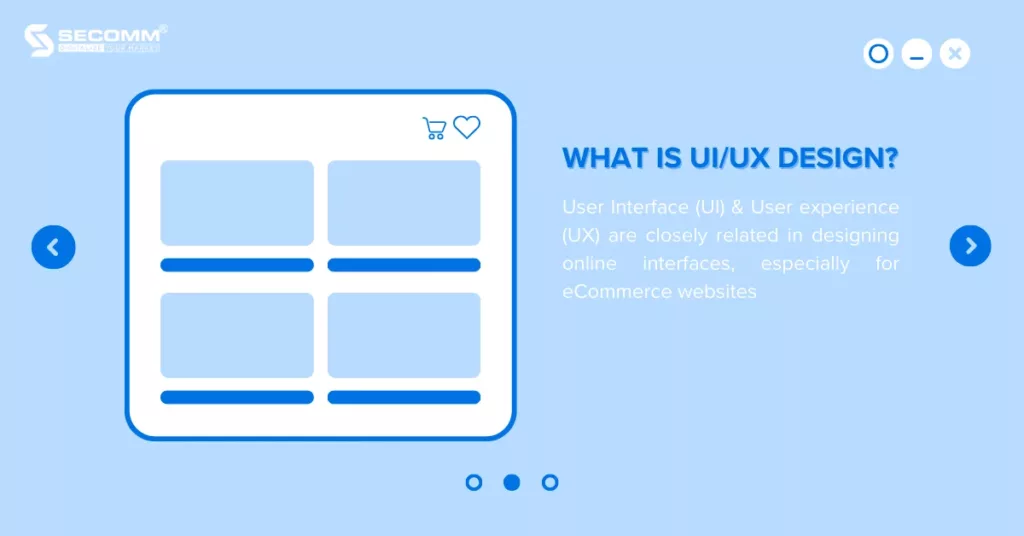
UI design encompasses the creation of various elements like call-to-action buttons, navigation bars, charts, and images, all based on choices of colors, layouts, fonts, and more, to craft an intuitive, appealing, and visually engaging user interface. In design, UI serves as a means to convey messages from businesses and brands to their users.
On the other hand, User Experience (UX) involves the process of shaping the overall experience for users during their interaction with a product or service. This encompasses meeting user requirements for ease of use and functionality, strategizing and structuring information, designing interaction workflows, and assessing effectiveness through research on user habits and behaviors within eCommerce websites.
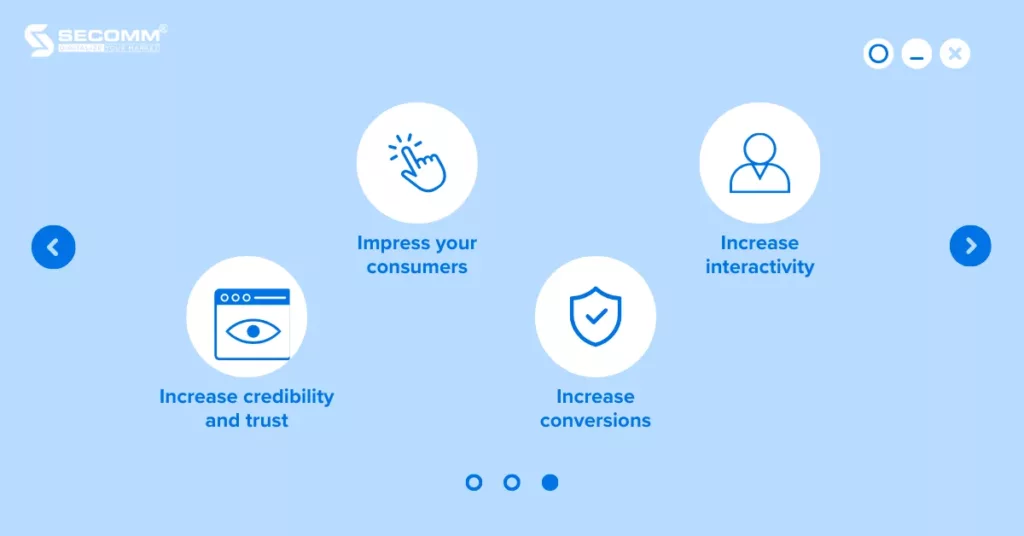
Expertly crafted UI/UX design can leave a lasting impact on users when they visit your eCommerce website. In the highly competitive eCommerce landscape, a remarkable UI/UX design can set your business apart and create a distinctive identity among market rivals.
Effective UI/UX design can help you enhance your interaction capabilities with consumers. For example, creating social media sharing buttons, user reviews, and intuitive search tools can streamline the customer’s journey to products and more.
A professional UI/UX design helps you establish trust with customers and cultivate a positive brand image. By offering clear security information, SSL certificates, and secure payment procedures, you can instill confidence in customers while mitigating the risks of personal data breaches and financial fraud.
Starting with an investment in UI/UX design helps convert potential customers into actual customers. Through data analysis and user feedback, businesses can gain a deeper understanding of customer behavior and make interface adjustments to improve the user experience and overall business performance.
Related article: The 10 biggest eCommerce trends set to dominate in 2023
Although the Dark Mode design trend isn’t new to website developers, it continues to be popular in 2023. The option to switch between light and dark modes offers users more flexibility when visiting an eCommerce website. Dark Mode enhances the browsing experience, especially for users who spend extended hours in front of screens. Furthermore, it can contribute to saving battery life on mobile devices or screens equipped with OLED displays.

The 3D design trend is gaining more popularity in UI/UX design. 3D elements bring depth and realism to website interfaces, making them visually appealing and improving user interaction. UI/UX designers frequently utilize 3D elements for website components like CTA buttons, icons, banners, and backgrounds, or employ 3D animations for feedback and transition effects, creating a more engaging user experience that fosters a visual connection with users.
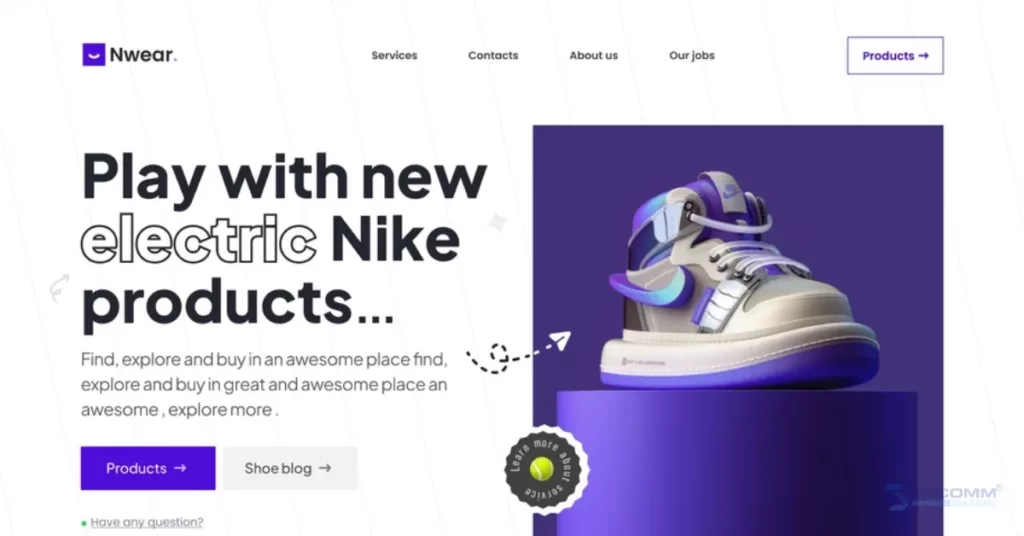
Neumorphism is a design trend that blends aspects of both skeuomorphism and flat design. It creates a 3D effect by using shadow and highlight effects to achieve a sleek, modern look for websites. However, UI/UX designers must be cautious not to overuse neumorphism, as it can result in a cluttered, confusing interface or create effects contrary to what a business intends to convey.

Modern Minimalism represents a UI/UX design trend that centers on crafting straightforward, user-friendly interfaces by removing extraneous elements and highlighting vital content. This style combines simplicity with modernity, providing users with a refined and user-friendly experience. The main challenge in implementing Modern Minimalism is finding the balance between simplicity and aesthetics, ensuring that the design remains both visually appealing and easy for users to navigate.

Dynamic Gradient is a design trend that produces color gradient effects that adapt according to user interactions or the time of day. It can offer users a more personalized and sophisticated experience. However, when implementing Dynamic Gradient in UI/UX design, it’s crucial for designers to strike a balance so that color intensity doesn’t become overpowering and doesn’t compromise readability.

Voice Interface represents a UI/UX design trend where users can interact with an eCommerce website system using voice commands rather than traditional input methods such as keyboards, mice, or touchscreens. Voice Interface employs voice recognition technology to comprehend and respond to user commands, requests, or queries. In UI/UX design, Voice Interface introduces a fresh and user-friendly mode of interaction, thereby unlocking a plethora of opportunities for tailoring the user experience and delivering personalized services.

Micro-interactions are a design style that incorporates small elements, including subtle animations, specific sound effects, image responses to user actions or voice commands, and more, to create an engaging experience and enhance interaction on a website. Micro-interactions can also help guide users through the website interface effortlessly. When applying Micro-interactions, UI/UX designers need to ensure they won’t distract or annoy users.

Augmented reality (AR) is becoming increasingly popular in the UI/UX design community, especially in eCommerce websites related to technology, interior design, cosmetics, gaming, and more. AR allows users to interact with products/services as if they were in the real world, bridging the gap between online and offline shopping. However, due to its advanced technology, AR can sometimes pose challenges for older or less tech-savvy customers. Therefore, when designing the UI/UX, businesses must ensure that AR elements are intuitive and user-friendly.

Asymmetric Layouts is a UI/UX design trend where elements and components aren’t arranged in the traditional symmetrical structure. Instead, elements are placed asymmetrically and inconsistently, creating a sense of balance and noticeable uniqueness in the design.
The strength of Asymmetric Layouts lies in their ability to capture users’ attention and create a distinctive experience through images and emphasis on essential content. However, when using Asymmetric Layouts, it’s essential to consider ensuring that the eCommerce website interface remains user-friendly, easy to navigate and maintains its aesthetic appeal.

Data Visualization is a design trend that involves presenting complex data in a clear and visual manner using graphs, charts, and images. In UI/UX design, Data Visualization is used to transform intricate information into engaging visuals, simplifying data comprehension and interaction for users.
Therefore, when incorporating Data Visualization into UI/UX design, it’s essential to carefully choose appropriate data representation methods, utilize colors and graphical elements effectively, and ensure information is conveyed clearly and attractively.

Those are the top 10 UI/UX design trends for eCommerce website in 2023. We hope that the valuable information in this blog will help you choose your best-fit style that conveys your brand’s essence.
Contact us now or call directly to the SECOMM hotline at (028) 7108 9908 for eCommerce consulting and implementation.
 2
2
 12,518
12,518
 0
0
 1
1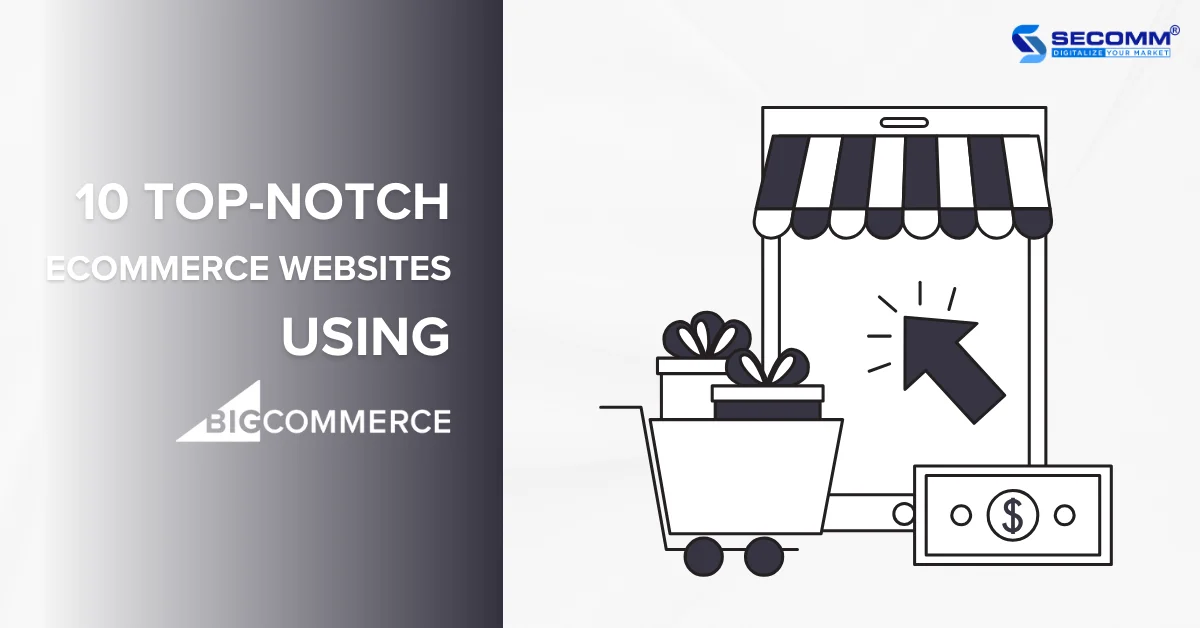
BigCommerce is one of the most popular eCommerce website-building platforms today. Its flexibility, user-friendliness, cost-effectiveness, and a wide array of built-in tools and features make it a preferred choice for businesses of all sizes.
This article aims to clarify the definition of BigCommerce, its features, pros and cons to provide businesses with valuable insights into the multitude of platforms available for selection.
Established in 2009, BigCommerce is a user-friendly platform tailored for businesses of all sizes and technical expertise to start developing their own eCommerce websites. Over the years, BigCommerce has emerged as one of the most feature-rich platforms, encompassing all the essentials for website creation, search engine optimization, marketing, and more, all at a cost-effective implementation.
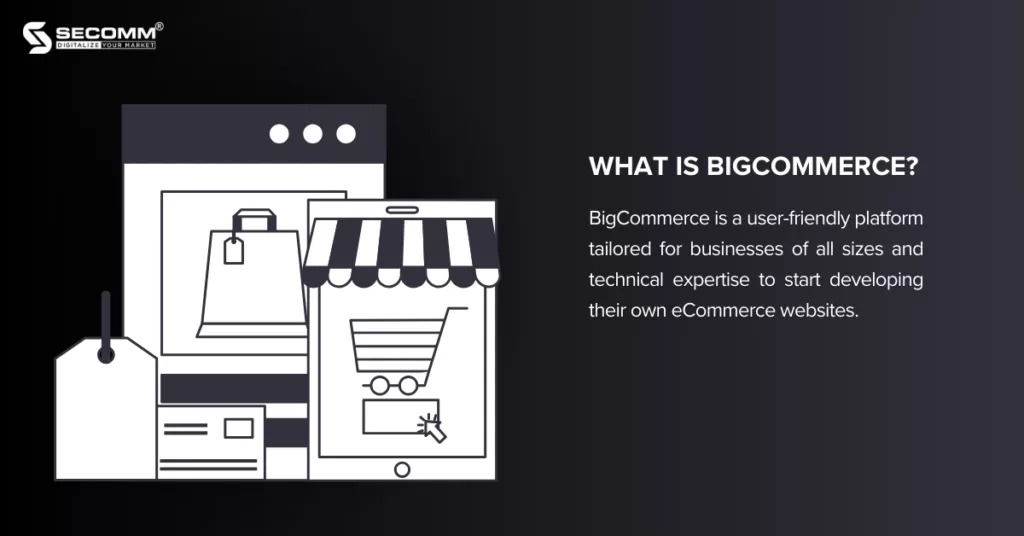
In addition, BigCommerce is known as a SaaS eCommerce solution, which means businesses subscribe on a monthly basis, and the platform takes care of hosting, maintenance, and system security matters.
BigCommerce provides three pricing plans tailored for small and medium-sized businesses (Standard, Plus, Pro), priced between $29 and $299 per month, each equipped with essential features. Moreover, the platform offers a customizable plan (Enterprise) for large businesses based on their deployment requirements.
The table below illustrates the cost variations among these four pricing plans and includes some relevant factors:
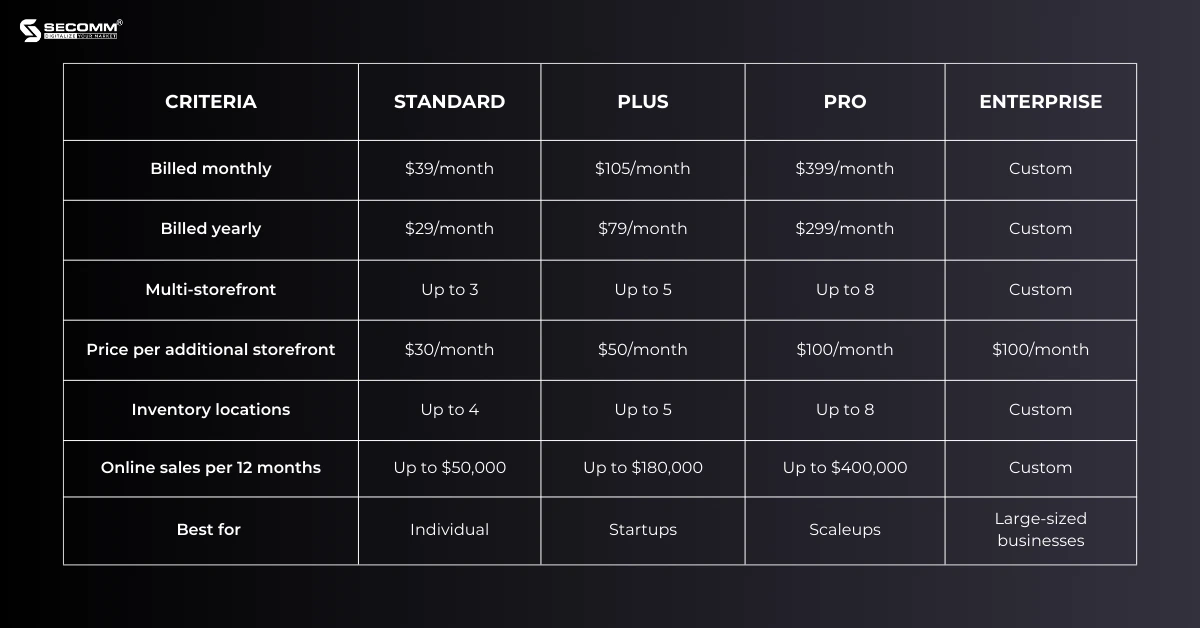
Despite several differences, all four packages share some common points:
Key features of BigCommerce, available in all four pricing plans, include:
The features available in the ‘Standard’ plan are consistent across all four pricing plans. However, there are some advanced features that are not included, and businesses may need to consider upgrading their plan to access these specific features. Here’s a breakdown:
In addition to the ‘Standard’ features, this plan offers:
The ‘Pro’ plan encompasses all ‘Standard’ and ‘Plus’ features, along with:
Designed for large-scale enterprises, this top-tier package includes all features from the previous packages and introduces several advanced capabilities:
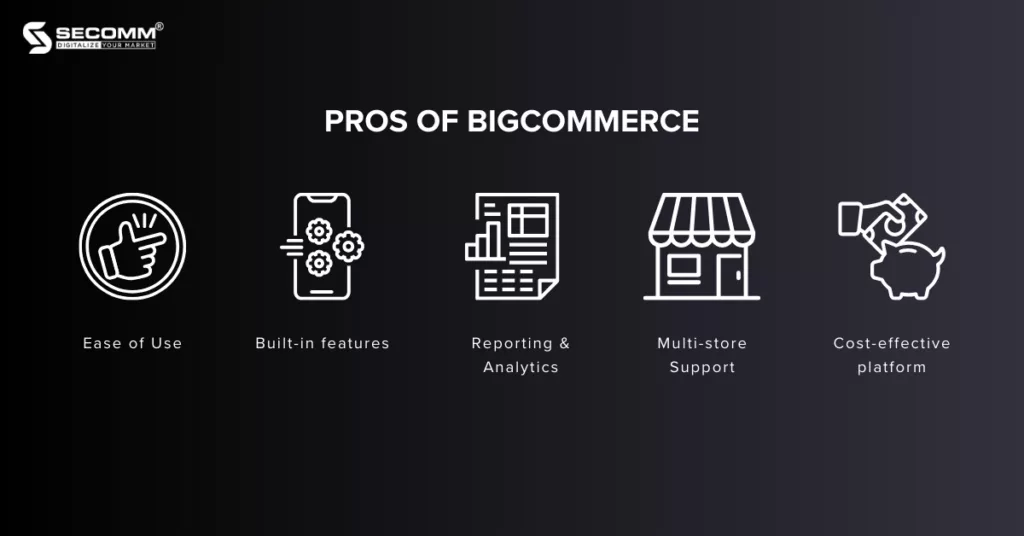
BigCommerce, designed as a SaaS platform, boasts user-friendliness catering to both tech-savvy and non-technical users. It offers a wide range of themes to facilitate swift website development and provides an array of tools for executing promotional campaigns.
When compared to other SaaS platforms, BigCommerce stands out for its capacity to offer a comprehensive set of built-in features and tools across its pricing plans. This results in cost savings for businesses, reducing their reliance on third-party applications and plugins, which can often incur extra expenses. Moreover, these features have been fine-tuned to boost performance and streamline the eCommerce management process.
BigCommerce also provides its users with the BigCommerce mobile app, enhancing the convenience of managing, monitoring, and updating their eCommerce websites.
Unlike Shopify, which offers a range of reports and analytics based on the pricing plan chosen, BigCommerce provides professional-level reporting and analytics across all its solution packages. These encompass customer reports, sales reports, financial reports, marketing reports, and more. Moreover, for businesses in need of more extensive data capabilities, BigCommerce offers a wide app library for easy integration with third-party software
BigCommerce distinguishes itself from competitors by providing multi-store support across all of its pricing plans. This feature is especially advantageous for businesses that operate multiple stores or are active in various segments, such as B2B and B2C. With the Standard plan, a business can create up to 3 stores, while the Plus and Pro plans allow for 5 and 8 stores, respectively. In contrast, Shopify, a leading SaaS platform, offers multiple store capabilities exclusively through its Shopify Plus solution, which starts at a monthly cost of $2,000.
Using BigCommerce helps businesses save costs in various aspects such as hosting, maintenance, updates, and security. BigCommerce handles these tasks, eliminating the need for additional expenses. Regardless of the chosen pricing plan, BigCommerce doesn’t impose transaction fees, provides unlimited bandwidth and file storage without extra charges, and permits the creation of an unlimited number of staff accounts.
In addition, compared to Shopify, where businesses may incur significant costs to integrate third-party apps and utilities for enhanced functionality, BigCommerce includes essential features tailored to each plan. This integrated approach results in significantly more cost-efficient operations.
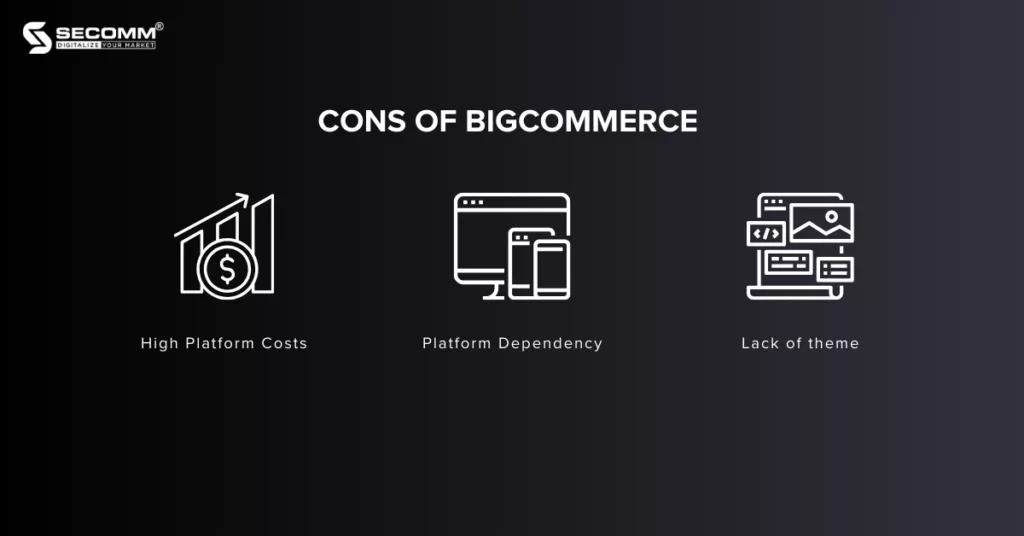
When compared to other SaaS platforms like Shopify or Squarespace, the cost of using the BigCommerce platform seems relatively higher.
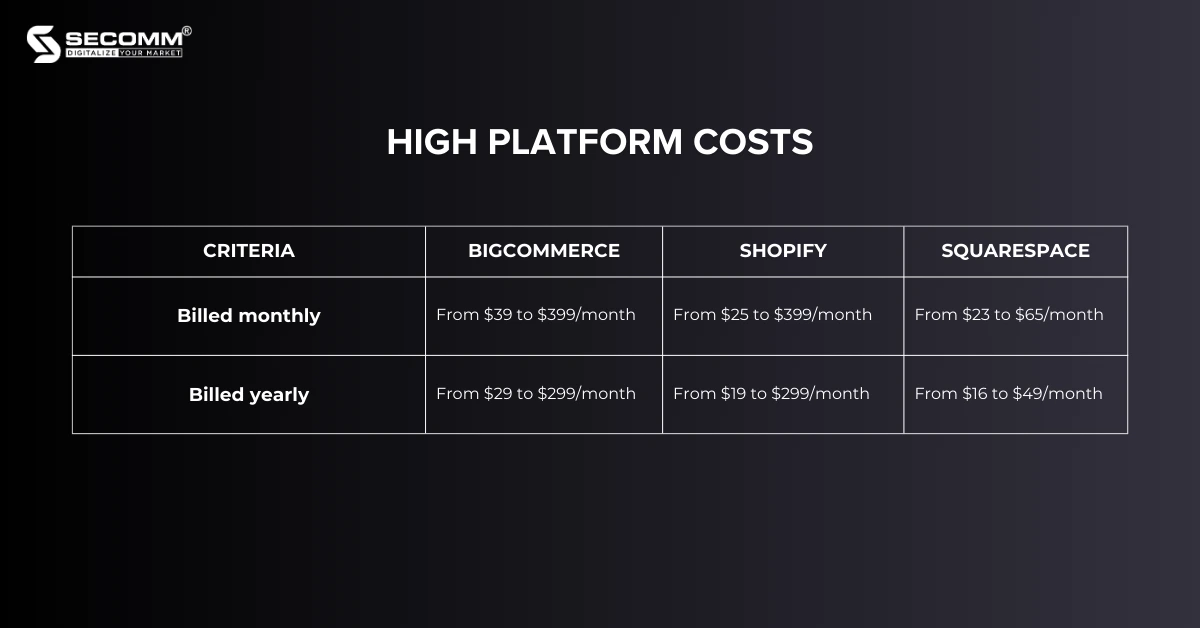
Plus, businesses must continue to pay this ongoing fee along with any charges for third-party services (if applicable) on a monthly basis, without ownership or control over the source code and system data.
On the other hand, open-source platforms such as Magento or OpenCart require businesses to make a one-time payment for both usage and service integration fees, granting them long-term ownership of the source code and system data.
Just like other SaaS eCommerce platforms in the market, BigCommerce retains ownership and control over the source code and data of the entire eCommerce website system.
In practical terms, this means that all of a business’s eCommerce data becomes closely tied to BigCommerce’s database. Therefore, if a business wishes to migrate to another platform in the future, it can only access CSV files containing a portion of its data.
Additionally, while it’s exceptionally rare, in the unlikely event that BigCommerce were to suddenly cease all operations, all data related to a business’s activities on this platform could potentially be lost.
At the time of writing, BigCommerce provides users with a selection of 12 free themes and approximately 180 paid themes. This count is somewhat limited in comparison to other SaaS platforms like Wix or Squarespace.
The free themes come with modern and professional interfaces, suitable for businesses to start their eCommerce website journey. However, these themes are quite similar to each other, differing mainly in color schemes.
In reality, despite the claim of having 12 themes, users often discover only around 5-6 truly distinctive options.
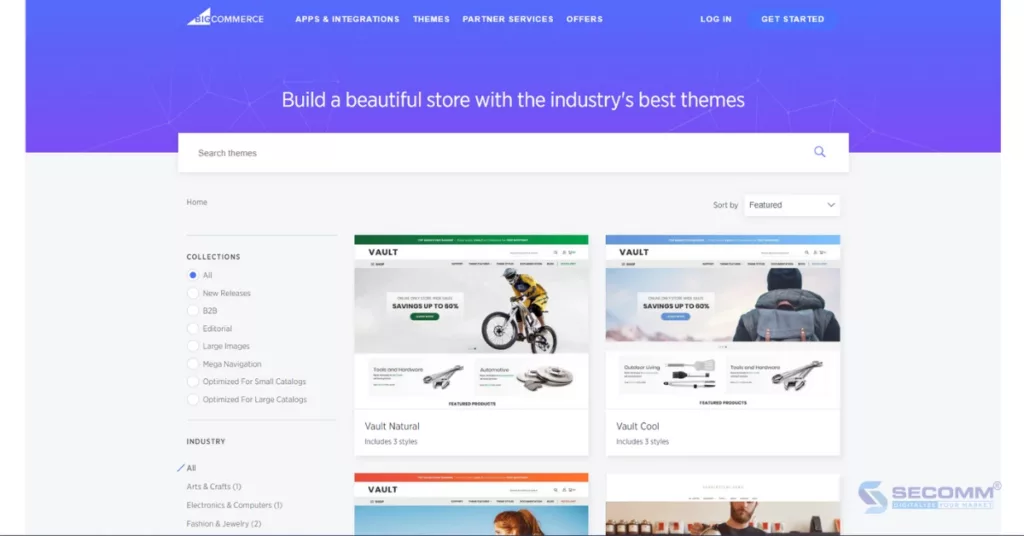
The paid themes, on the other hand, come with a price tag ranging from $195 to $395, and some of them may have similar designs.
However, BigCommerce offers a significant advantage: all the free and paid themes are visually appealing and highly responsive. This means that these themes can automatically adapt their layouts to suit various screen sizes, including smartphones, tablets, desktop computers, and more.
For many years providing eCommerce solutions for clients across the globe, SECOMM has observed a growing trend when it comes to eCommerce website development, particularly on the BigCommerce platform.
To gain a deeper understanding of BigCommerce and how to deploy it the right way, feel free to reach out to us or call our hotline at 02871089908 for free consultations.
 2
2
 10,228
10,228
 0
0
 1
1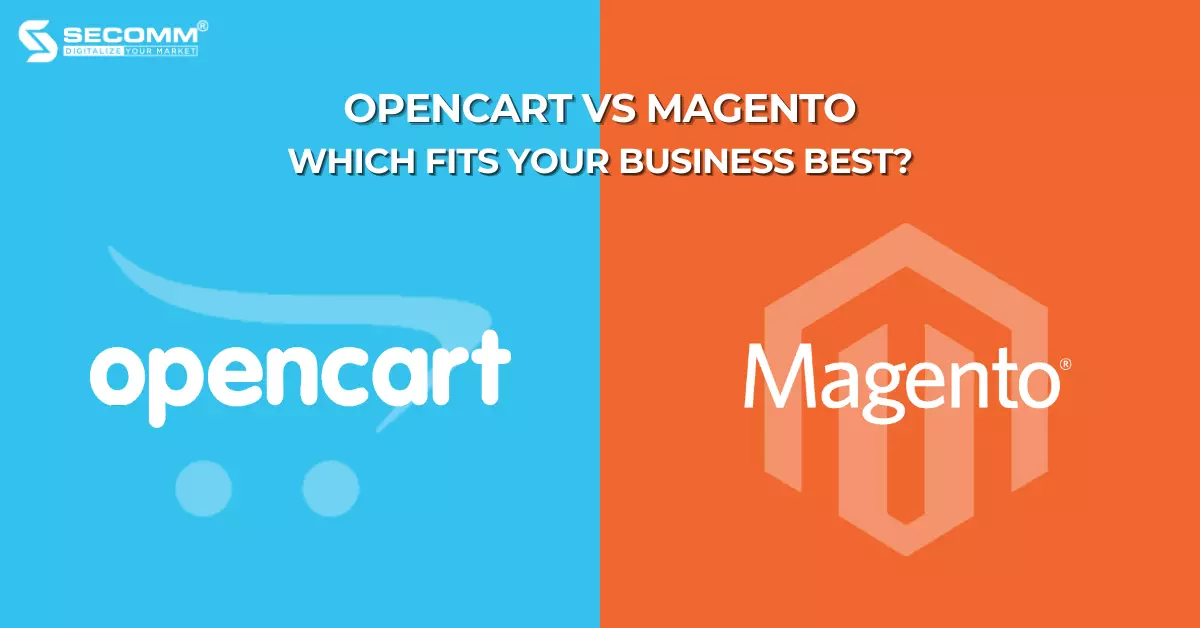
OpenCart and Magento have consistently been pitted against each other as open-source platforms for businesses in need of building specialized eCommerce websites, particularly for enterprises and corporations.
So, which of these open-source eCommerce platforms, OpenCart or Magento, is the right fit for your business?
OpenCart is a freely developed open-source eCommerce platform designed in PHP. It’s favored for its user-friendliness and simplicity, boasting an easy-to-navigate admin dashboard that allows product management, promotions, order processing, and reporting without requiring technical expertise.
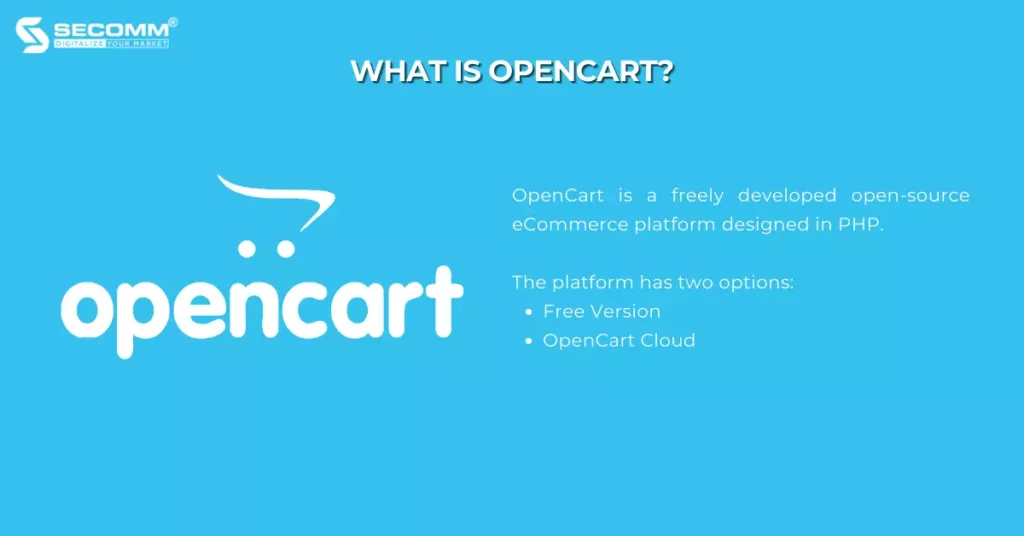
OpenCart offers two options for businesses:
As per Build With data, OpenCart has been adopted by over 400,000 websites, primarily by small to medium-sized businesses in the United States, Russia, the United Kingdom, Ukraine, and Brazil.
Related Reading: What is OpenCart? Key Pros and Cons of OpenCart
Magento (Adobe Commerce), much like OpenCart, is an open-source eCommerce platform developed using the PHP programming language. Magento stands as the ‘pinnacle’ among all open-source eCommerce platforms due to its comprehensive control and high scalability, offering a plethora of specialized features.
At present, Magento provides three primary editions, which are:
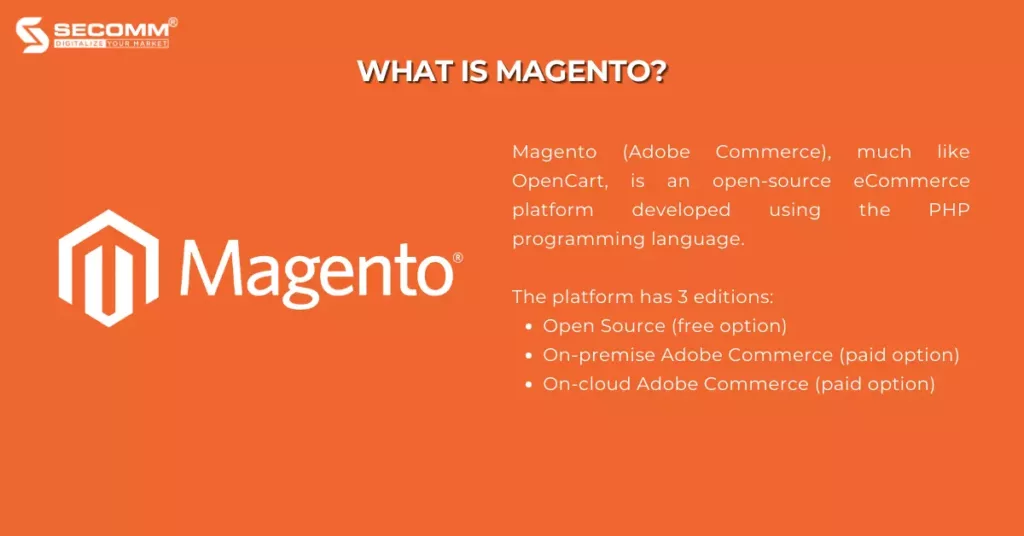
According to BuildWith, Magento supports over 160,000 websites, with significant popularity among large businesses in the United States, the United Kingdom, the Netherlands, and Germany.
Given the differences in service offerings between the paid versions of OpenCart and Magento, this SECOMM article will focus on comparing the two free versions.
Related Reading: What is Magento? Key Pros and Cons of Magento
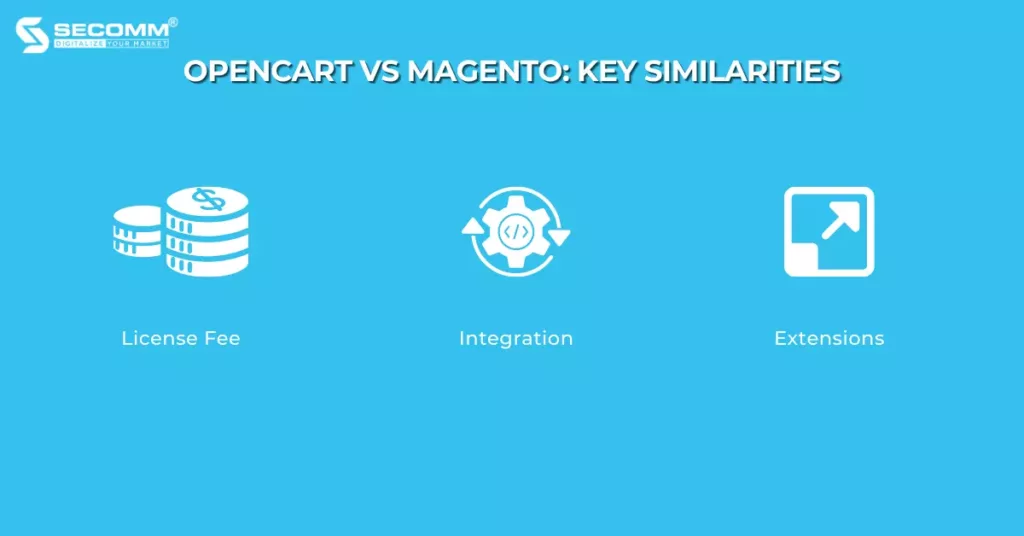
Overall, OpenCart and Magento are both open-source platforms developed using PHP. They are both robust eCommerce platforms with powerful features and a multitude of additional utilities.
The usage costs of OpenCart and Magento are quite alike, as both offer free enterprise versions that can be downloaded and installed without any charges.
Since they are open-source platforms, both possess exceptional customization capabilities for integrating third-party add-ons.
This enables businesses to effortlessly install and manage various management systems like POS, ERP, CRM, and others within a single system.
OpenCart offers an extensive library of extensions, with approximately 13,000 extensions at your disposal. Likewise, Magento boasts a vast collection of extensions, with over 5,000 to choose from.
Both platforms enable businesses to enhance their eCommerce websites with a plethora of additional features using these extensions, eliminating the need for coding concerns.
OpenCart is recognized as being more user-friendly for beginners, primarily due to its intuitive interface and straightforward installation process. However, businesses should still possess a basic level of technical knowledge related to hosting, FTP (File Transfer Protocol), security upgrades, and the like.
Within the admin dashboard, users can effortlessly navigate through sections such as ‘Catalog,’ “Extensions”, “Sales”, “System”, “Reports”, and “Help”.
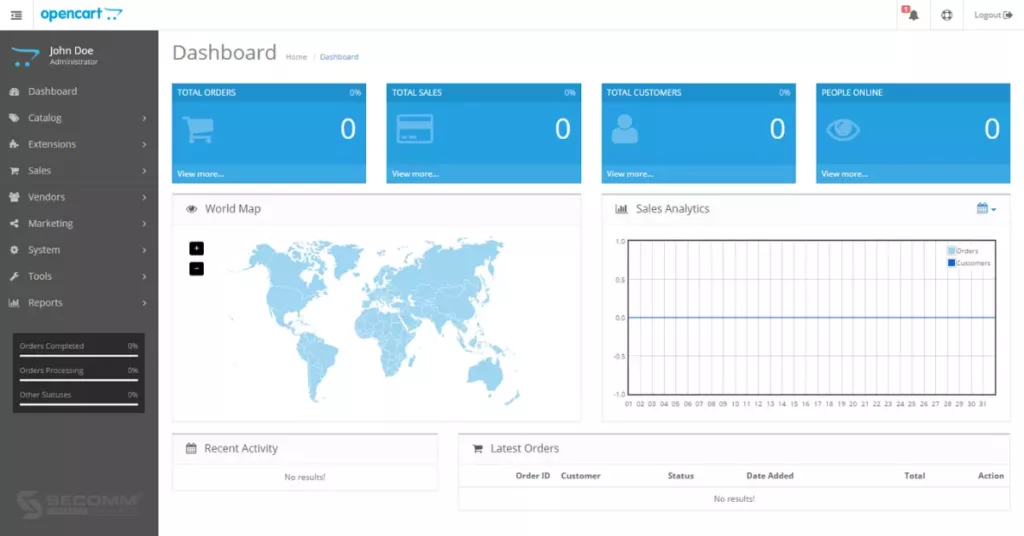
Magento isn’t a “playground” suited for beginners due to its intricate installation process, which demands a high level of technical expertise to set up.
While Magento 2 is considered more user-friendly than Magento 1, the admin dashboard still offers a multitude of options that can pose challenges for newcomers, especially when it comes to understanding Magento-specific terminology, resulting in a time-consuming learning curve.
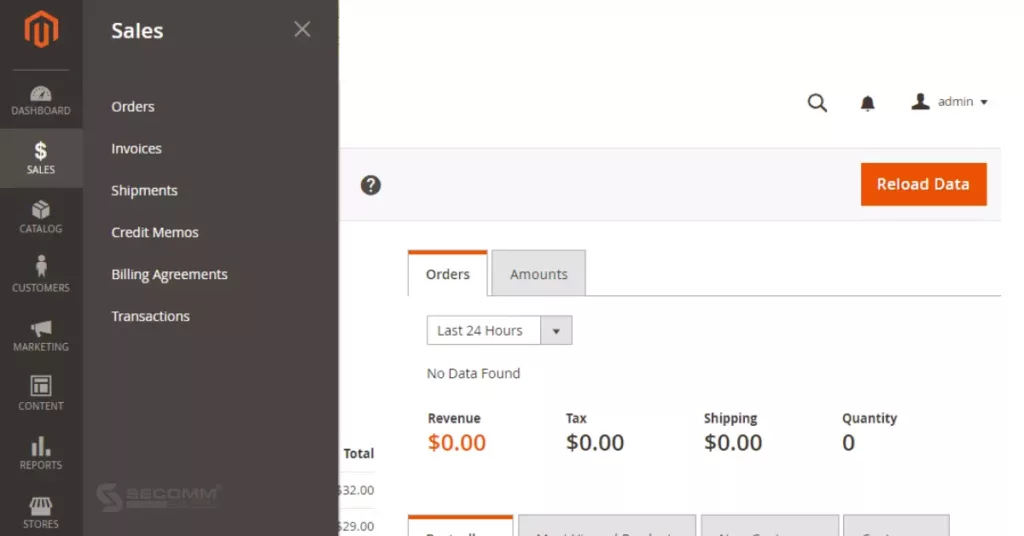
OpenCart provides around 500 themes, available in both free and paid options (ranging from $60 to $70), catering to diverse industries. This platform enables businesses to preview their website’s appearance with various themes before making a purchase. Subsequently, businesses can customize these themes according to their specific needs.
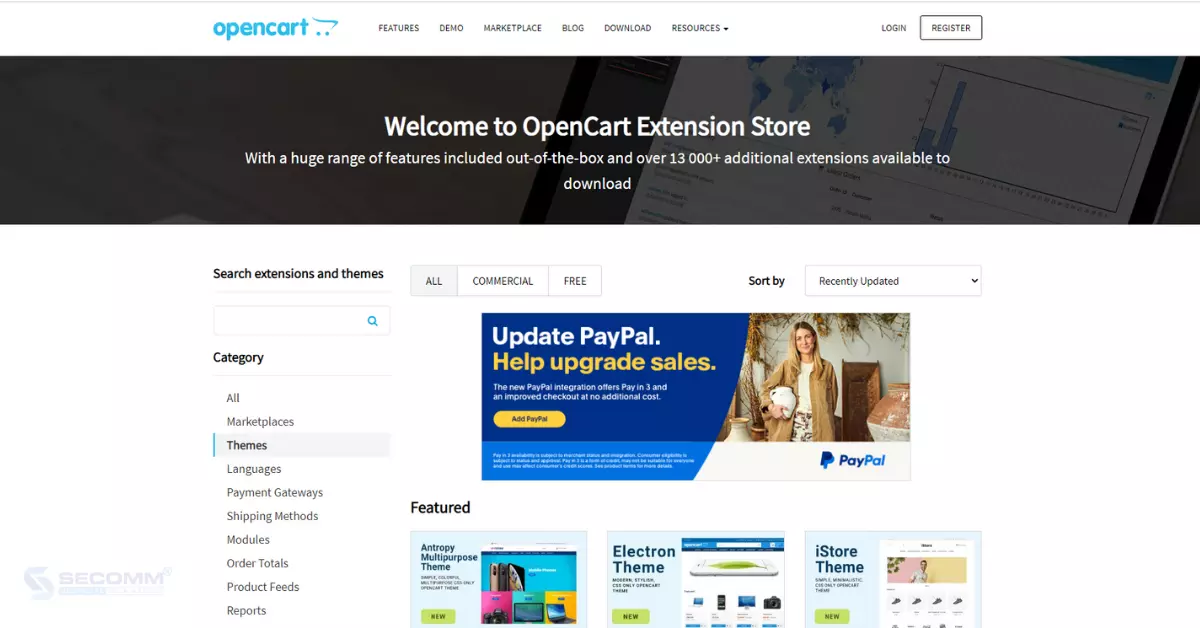
In the case of Magento, businesses have three options for creating user interfaces:
In summary, both OpenCart and Magento offer a wide selection of budget-friendly themes, but Magento allows for more extensive customization to optimize the eCommerce website’s interface.
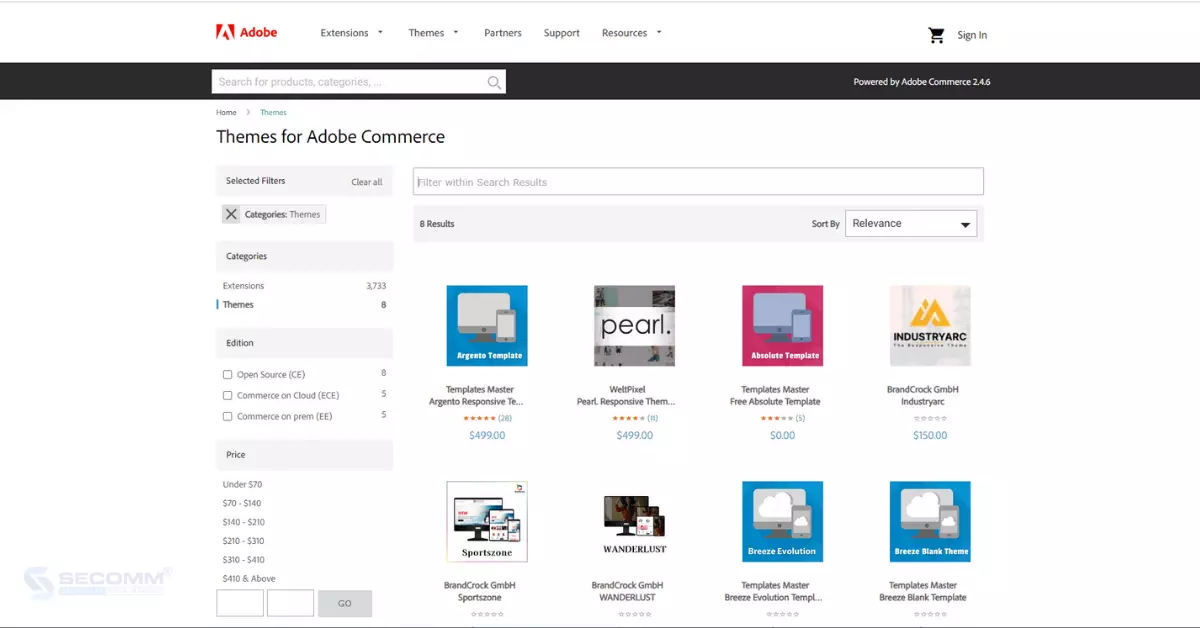
In terms of scalability, OpenCart is suitable for small and medium-sized business websites because it can only handle a limited number of products and transactions. On the other hand, Magento is specifically designed to manage large and complex eCommerce websites, capable of handling thousands of products and daily transactions without performance issues.
When it comes to flexibility, OpenCart provides a variety of extensions and add-ons to enhance website functionality. However, its flexibility may be somewhat constrained when dealing with intricate custom requirements. In contrast, Magento offers a higher degree of flexibility, enabling businesses to customize every aspect of their website. It boasts a comprehensive system of modules and better compatibility with third-party integrations, allowing businesses to tailor and expand their website to suit their specific needs.
Overall, Magento surpasses OpenCart in terms of scalability for eCommerce websites.
OpenCart offers two types of support to its users:
Magento provides a Help Center, but its support staff primarily focuses on Adobe Commerce, which may not fully address the needs of businesses using Open Source. However, Magento boasts a global developer community of over 13,000 individuals, making it relatively straightforward to find solutions.
OpenCart doesn’t assume responsibility for the security of eCommerce websites as it operates on an open-source platform. This means that OpenCart’s code and framework are publicly available, rendering websites more susceptible to potential attacks.
In contrast, despite also being an open-source platform, Magento places a strong emphasis on security. Magento has consistently released security patches since 2015 to identify vulnerabilities. This commitment ensures that eCommerce websites built on Magento maintain a high level of security, instilling confidence in online shoppers.
Through the use of third-party tools such as Mage Report and Mage Scan, businesses can assess their security status. Additionally, Magento employs CSP (Content Security Policy), which offers a structured set of principles for restricting browser content to trusted services only. This allows browsers to determine which web tools to block and which ones to trust.
Even though both OpenCart and Magento are provided with free licenses, there is a significant difference in the development costs for eCommerce websites.
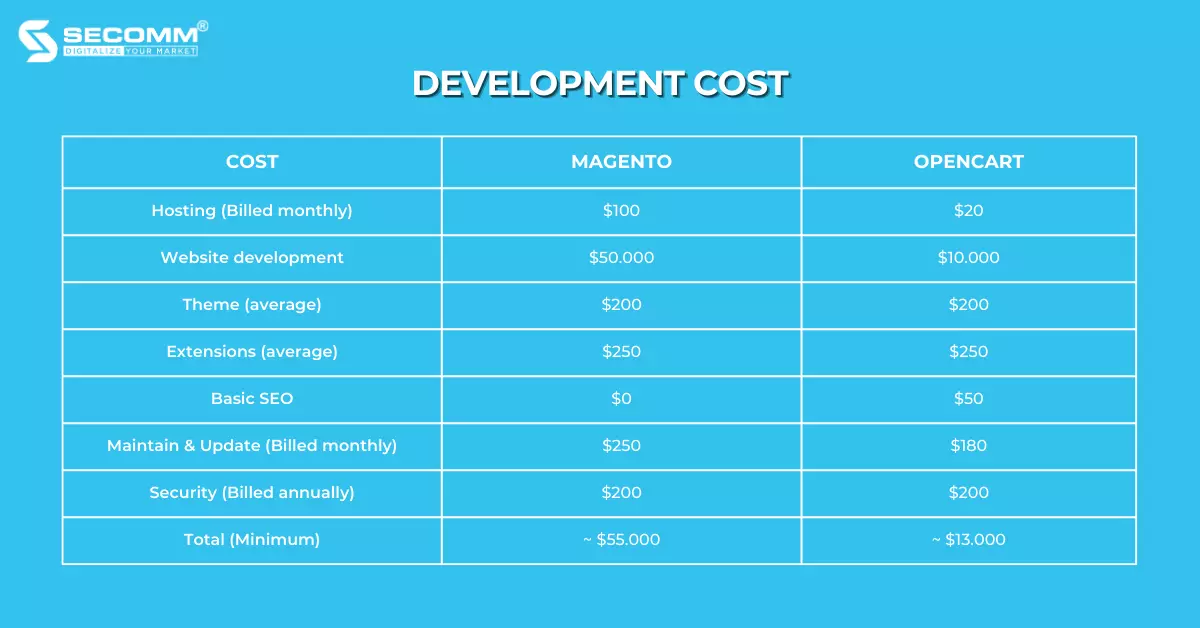
While Magento comes with a higher implementation cost than OpenCart, it offers a plethora of features for eCommerce websites. These include advanced search capabilities with Elasticsearch and OpenSearch, content editing tools that don’t require coding, support for categorizing a wider range of product types, and advanced shipping configuration, among others. In contrast, adding these features to OpenCart would necessitate the use of numerous extensions and increased storage resources to ensure efficient operation.
Considering the evaluations presented earlier, OpenCart proves to be a suitable choice for small and medium-sized enterprises (SMEs) seeking to establish their eCommerce websites. In contrast, Magento is an excellent fit for both SMEs and large corporations with specific and highly customizable eCommerce system requirements. Magento allows businesses to own a tailor-made system by either starting with a basic eCommerce website and gradually enhancing it or by creating a comprehensive system from the ground up.
With our extensive experience in implementing eCommerce solutions for clients across diverse countries, SECOMM comprehends the challenges and complexities that businesses encounter when selecting the ideal platform for constructing a professional eCommerce system.
Contact SECOMM today or call our Hotline at (02871089908) for a complimentary consultation.
 2
2
 9,170
9,170
 0
0
 1
1
The eCommerce platforms are often considered the “backbone” of any experienced business in the market. To embark on the eCommerce journey, your business needs to choose the right eCommerce platform to build your website.
In addition to Magento, WooCommerce, Shopify, Squarespace, PrestaShop, etcOpenCart become a popular choice for many international SMEs.
OpenCart is an open-source eCommerce platform based on the PHP programming language, developed by Daniel Kerr in 1998. Currently, OpenCart offers two versions: Free and Cloud Store (Paid).
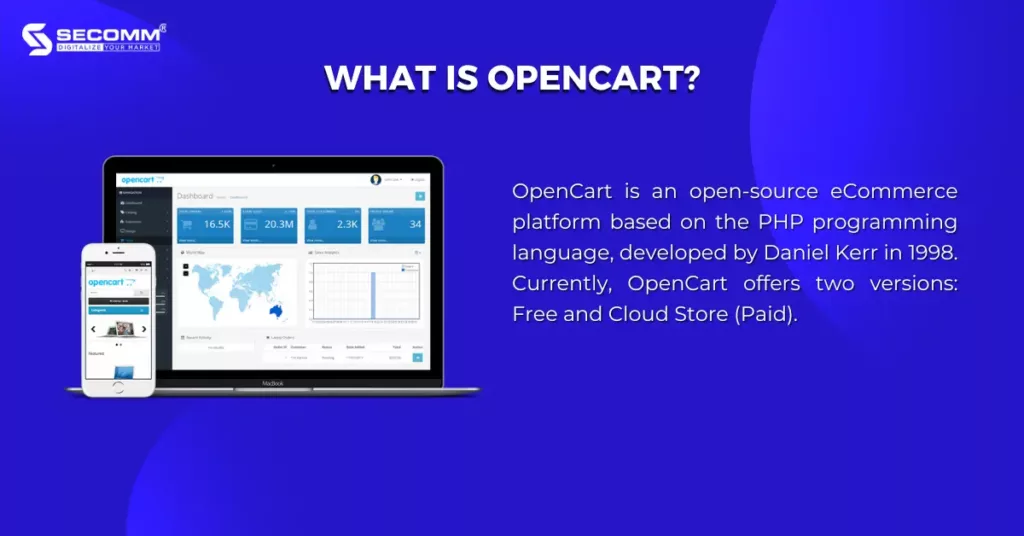
For the Cloud Store version, you have three solution options to build your eCommerce website:
According to BuiltWith, there are over 2,500 websites built on this platform. Some famous brands using OpenCart include WeLoveFine, GT Omega, Arrowfile, and Kleshna.
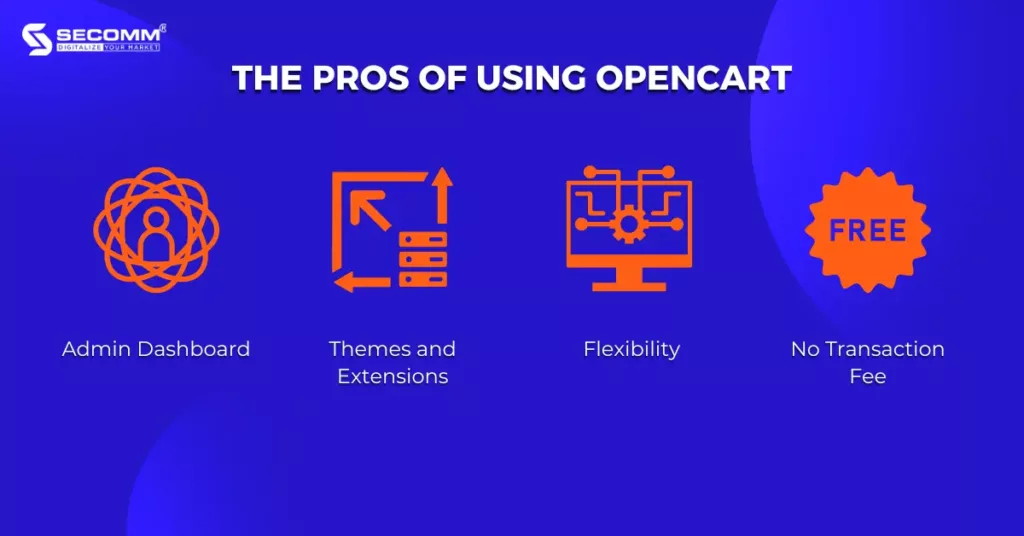
OpenCart is a user-friendly platform, even for those without technical experience. You don’t need to invest much time in training staff to manage products, orders, customer information, or other features on the website.
Over the years, OpenCart’s marketplace has offered more than 13,000 functional modules and ready-to-use themes. You can find suitable themes for any industry along with 3rd-party extensions, payment gateways, shipping providers, marketing tools, analytics, and reporting, which enrich your journey of building an eCommerce system.
With its nature as an open-source eCommerce platform, OpenCart has the ability to be flexibly customized. Also, you can own and control the entire source code. That said, you’ll customize code components, create updates, or even develop new features within the system based on your needs.
In addition, OpenCart also has good scalability, enabling you to upgrade to multiple languages and currencies for your global expansion goals.
For eCommerce platforms like Shopify, and BigCommerce, operating on a licensing model. This means they charge fees for platform usage on a monthly/yearly basis. These platforms typically charge an average transaction fee of 1.5% to 2% per transaction. On the contrary, OpenCart’s Cloud Store version charges no fees.
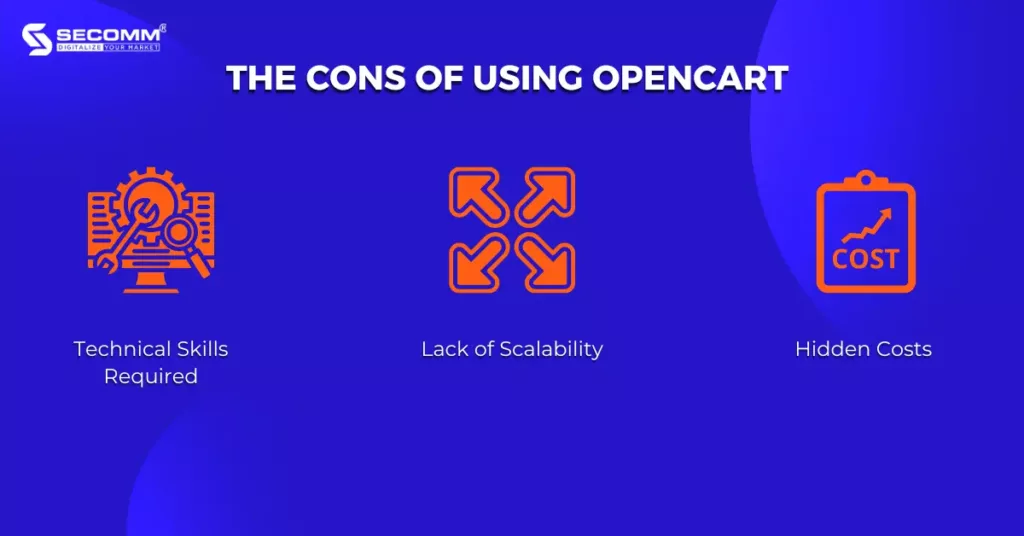
OpenCart is an open-source platform built with one of the most complex programming languages — PHP. That means, to successfully develop your own eCommerce website, you should build a skilled in-house team or collaborate with an experienced agency.
Although OpenCart offers many features, it may not be sufficient for you to manage and operate your complex eCommerce website. It’s different when compared to another PHP-based open-source eCommerce platform like Adobe Commerce (also known as Magento). Adobe Commerce allows you to expand from one website to multiple websites while managing them under the same system effectively.
It’s worth noting that OpenCart doesn’t charge transaction fees and it’s affordable cost of using OpencCart’s Cloud Store compared to other platforms. However, you need to add up the expenses for integrating various extensions. Each extension typically costs a minimum of $20 per month.
But if you want to create a comprehensive eCommerce website system, you may need at least 10 extensions. As a result, when opting for OpenCart, you should be aware of the potential hidden costs associated with these extensions.
OpenCart, with its own set of pros and cons, is generally a suitable eCommerce platform for small and medium-sized enterprises (SMEs). However, large-sized businesses looking for open-source eCommerce solutions may find platforms like Magento or Shopify Plus more fitting.
Having in-depth expertise and a track record of successfully developing complex eCommerce systems on Magento, such as Laybyland (Australia, US, New Zealand), Jasnor (Australia, New Zealand), and An Nam Group (Vietnam), SECOMM understands the challenges that businesses encounter when selecting and implementing an open-source eCommerce platform.
Get in touch with SECOMM today or call directly to the hotline at 02871089908 for a free consultation on tailored solutions for your eCommerce system development needs!
 2
2
 10,658
10,658
 0
0
 1
1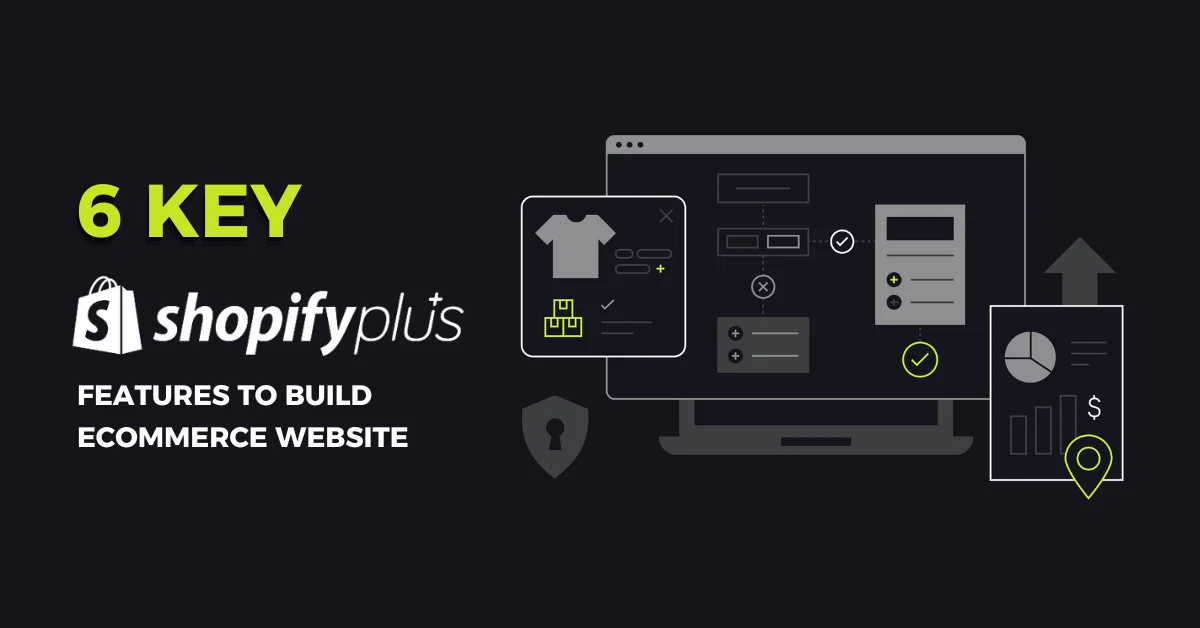
Shopify Plus is a platform designed for high-growth eCommerce businesses. Over the years, Shopify Plus has been the top choice for leading global brands such as GymShark, Fashion Nova, Kylie Cosmetics, and more.
Simply because the platform successfully provides its customers with exceptional features to optimize the customer experience and enhance the effectiveness of sales and marketing strategy.
Here are the top 6 core Shopify Plus features that benefit enterprise-level brands in eCommerce website development.
Related Readings: Top 10 Most Successful Shopify Plus eCommerce Websites
For retailers targeting sales in the global market, Shopify Plus is the go-to choice platform.
The platform provides a multi-store feature that allows businesses to create up to 9 additional stores in 20 different locations apart from the main store to track inventory and fulfill orders.
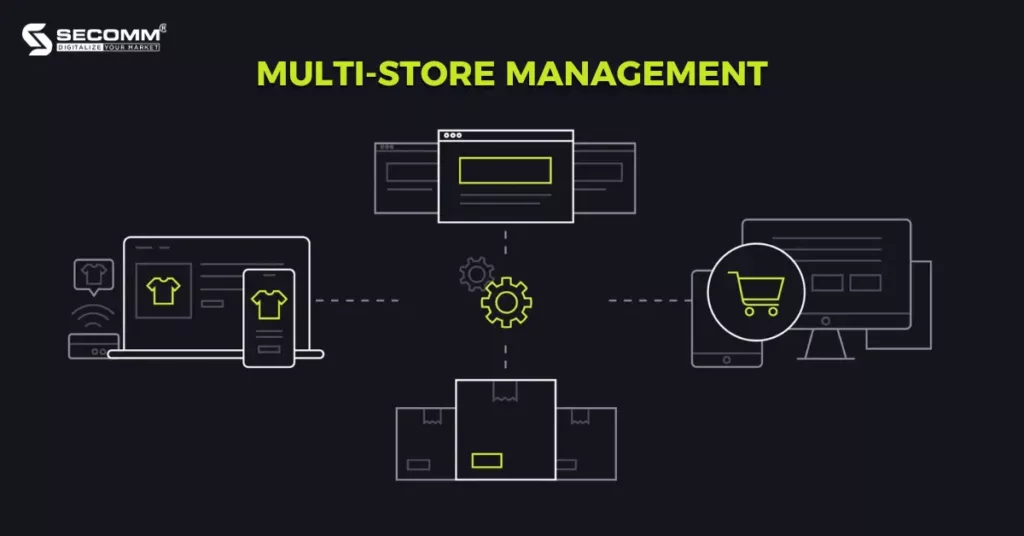
Each additional store will have its own domain, design, products, and customer data which can be managed from a single Shopify Plus account. This means businesses can easily switch between stores and manage everything from a single dashboard.
Not only Shopify Plus supports businesses in building a comprehensive eCommerce website while also facilitating Omnichannel implementation. The platform also allows businesses to provide their customers with a consistent shopping experience across channels, including websites, mobile apps, online marketplaces, social media, and physical stores.
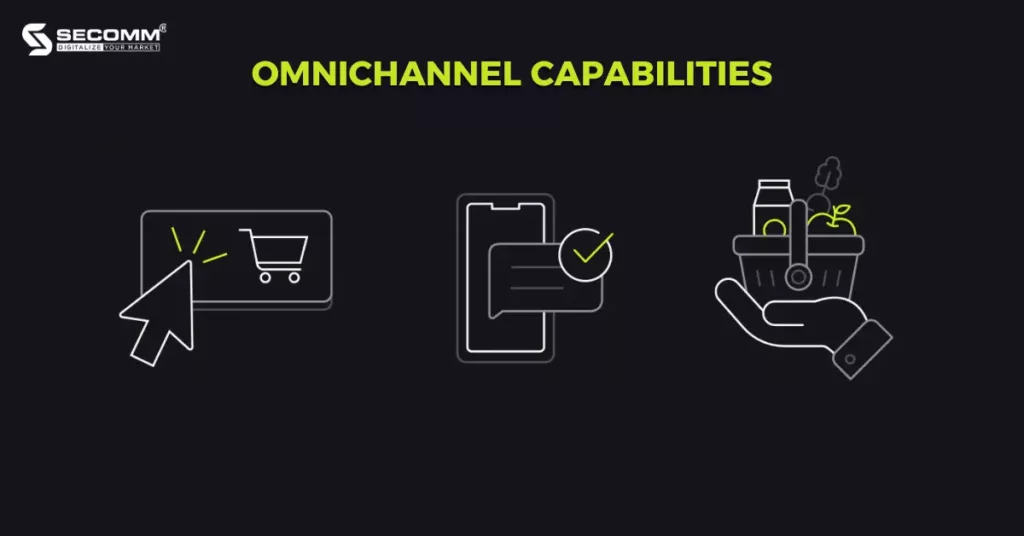
The Shopify POS feature helps seamlessly integrate sales points from online to offline. Businesses can use Shopify POS to track orders and inventory at all active sales channels.
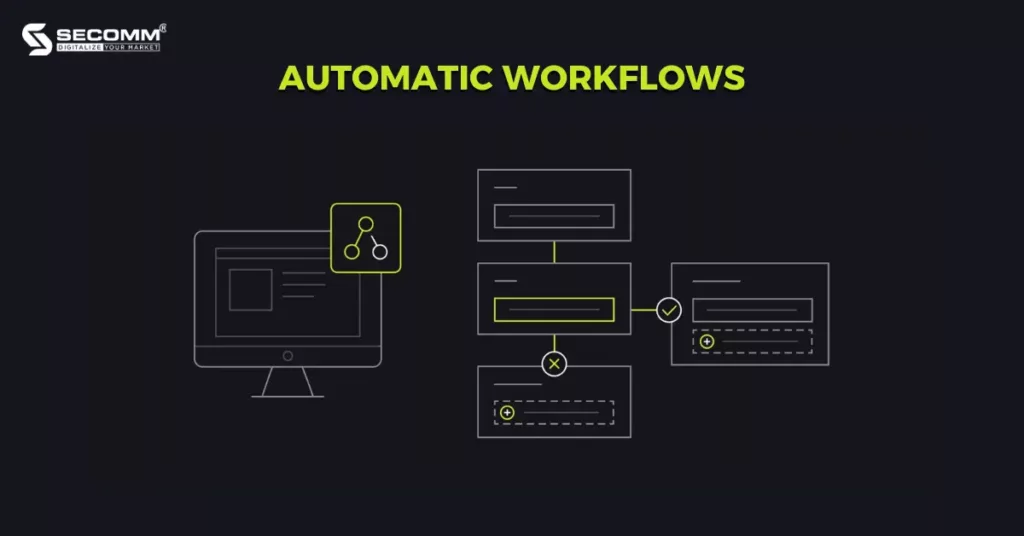
Shopify Flow is an eCommerce automation solution encouraged by Shopify for business implementing Shopify Plus.
Shopify Flow helps businesses handle repetitive tasks such as inventory management, fraud prevention, setting up loyalty programs, and fulfillment management quickly and automatically. This allows businesses to focus more on their core operations.
With Flow, businesses can rapidly build customized eCommerce automation workflows using visual, code-free blocks called triggers, conditions, and actions.
For example, an automated workflow to add customers to a loyalty program could unfold as follows:
LaunchPad allows businesses to set up and automate the essential processes for organizing promotional events, flash sales, and product launches.
Using LaunchPad, businesses can:
If standard Shopify businesses need to leverage apps or alternative solutions, Shopify Plus businesses have access to Shopify Scripts.
This feature is exclusively available for Shopify Plus merchants and allows for personalized customer experiences at the cart and checkout stages. Businesses can use the Script Editor app to gain more control over how customers interact with their eCommerce website by creating special offers, and discounts, adding upsells, cross-sells, and customizing the checkout experience.
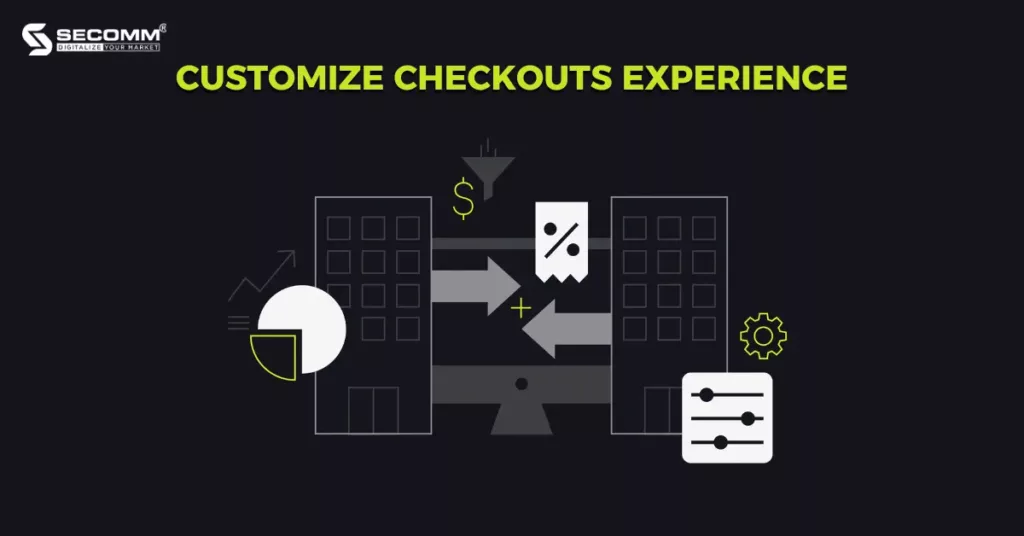
With Shopify Scripts‘ high level of autonomy, businesses can freely experiment to deliver unique experiences for their customers.
Three types of scripts include
Here are some examples of scripts that can be customized:
Shopify Plus meets the highest standards of online security, and all Shopify Plus businesses have SSL certificates used to encrypt sensitive information, such as credit card details.
Moreover, Shopify Plus provides two-factor authentication and account recovery features to protect websites from unauthorized access.

In particular, businesses can obtain an Extended Validation SSL certificate, which offers the highest level of protection available on Shopify Plus. In this case, a green padlock icon will be displayed in the browser’s address bar, assuring customers that the business’s website is secure to use.
Shopify Plus also offers fraud analysis tools that allow businesses to monitor their website for detecting any suspicious activities. For example, when any fraudulent orders are detected, the tool will flag them for the business to decide whether to cancel or fulfill the order.”
Shopify Plus offers a range of features to support B2B eCommerce operations, including:
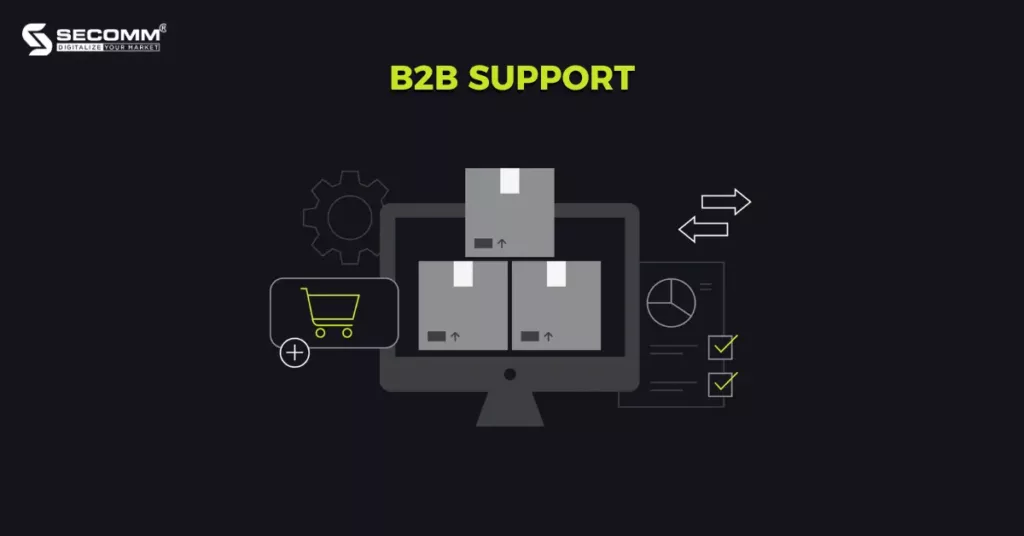
Additionally, businesses can set up wholesale channels to cater to customers with bulk purchasing needs.
Those are the 6 core features of Shopify Plus that you can leverage to boost your business operations efficiency and give your customers the best shopping experience.
Contact or call directly to the SECOMM hotline (02871089908) for a free consultation.
 2
2
 9,053
9,053
 0
0
 1
1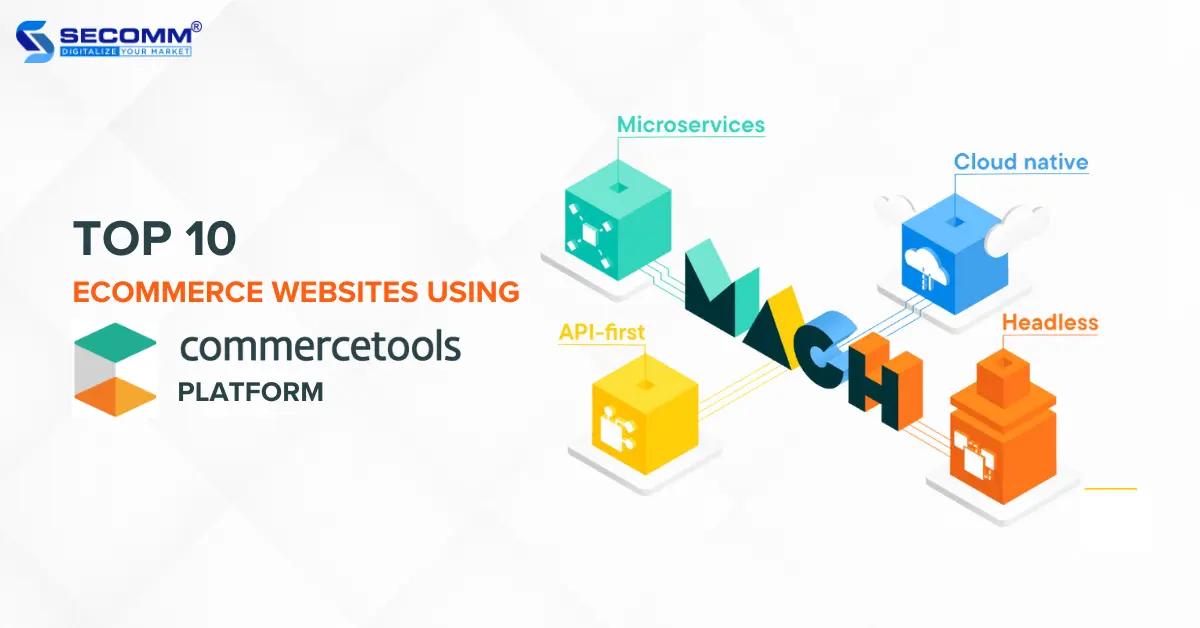
commercetools is a cloud-based eCommerce platform that provides a multi-channel approach, supporting businesses to build and manage eCommerce websites, mobile applications, and other sales channels seamlessly. Moreover, commercetools is a pioneer of Headless eCommerce.
Therefore, as businesses focus on enhancing multi-channel marketing and sales efforts to meet the increasing customer shopping experience demands, commercetools becomes particularly prominent.
Here are 10 brands that have utilized the commercetools platform to actualize their revenue and customer experience goals.
Chronext is a renowned global brand specializing in buying and selling luxury watches, boasting a collection of over 7,000 products. Offering a wide array of watches, including new, pre-owned, and classic pieces, Chronext’s expert watchmakers thoroughly inspect each watch before sale and provide a 24-month warranty.
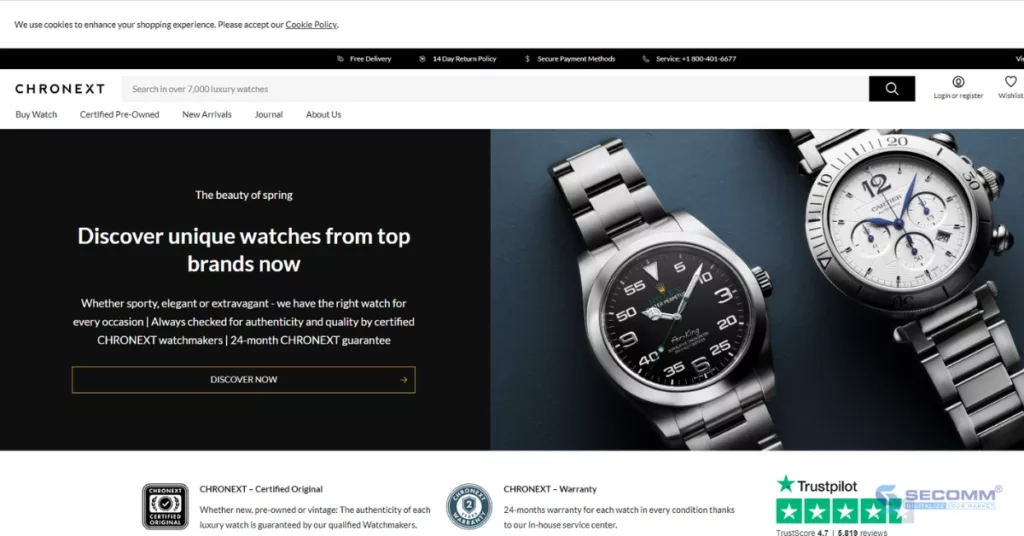
Chronext has implemented an eCommerce website using commercetools, contributing to a 300% increase in page loading speed, a 40% boost in SEO ranking, and a 10% increase in conversion rate. As a result, Chronext has achieved a solid reputation in the luxury watch industry, becoming a trusted destination for watch enthusiasts
Promod is a French brand established in 1975, specializing in providing ready-to-wear fashion for women. This brand is currently present in France, Belgium, Luxembourg, Switzerland, and Malta.

Promod has utilized commercetools to develop an exceptional eCommerce website, aiming to achieve the expected revenue level and deliver a seamless shopping experience for customers.
Since opening its first store in 1990, Ulta Beauty has evolved into the largest cosmetics retailer in the United States and a premier beauty destination for cosmetics enthusiasts. The brand offers over 25,000 products from around 500 beauty brands, including its own Ulta Beauty Collection with attractive pricing.

With the need for rapid-scale expansion and the flexibility to implement changes to the platform, Ulta Beauty chose commercetools for its Headless eCommerce solution. In 2022, Ulta Beauty officially launched an entirely new eCommerce website, enabling the brand to manage an extensive product portfolio with over 1.3 million SKUs. This upgrade enhanced the shopping experience with features like the Buy Online, Pickup In-Store (BOPIS) solution.
Since 1928, 66°North has been providing protective clothing for Iceland’s rescue teams, and this successful collaboration has driven the company to continue developing outdoor clothing and accessories with diverse designs. Today, 66°North has become a leading global brand in producing protective workwear suitable for all outdoor activities.

The 66°North website employs commercetools to transition from a monolithic model to a more flexible microservices-based system, tailored to the specific needs of 66°North. This collaboration has led to a 35% increase in average order value, a 75% repeat purchase rate, and a 50% increase in transactions per minute for the 66°North eCommerce website.
Danone is a leading global food and beverage company operating in four main business areas including Dairy and Plant-Based Products, Waters, and Nutritional Products for infants and patients. Danone currently sells products in over 120 markets.

During the crisis period of the Covid-19 pandemic, Danone accelerated its Direct-to-Consumer (D2C) eCommerce strategy and transitioned to a MACH model using commercetools to address shortages of infant formula in Europe. This move also aimed to adapt to sudden supply chain changes and local consumer demands. The addition of cart functionality to the brand websites helped customers access products more swiftly. Furthermore, this strategy allowed the company to expand its web capacity without encountering issues due to the sudden increase in access traffic.
Anyone with a passion for photography is likely familiar with Tamron – a global leader headquartered in Japan. This company specializes in supplying camera lenses of varying focal lengths, catering to all types of cameras. Their products are distributed through a network of partners, local agents, and online platforms such as Amazon.
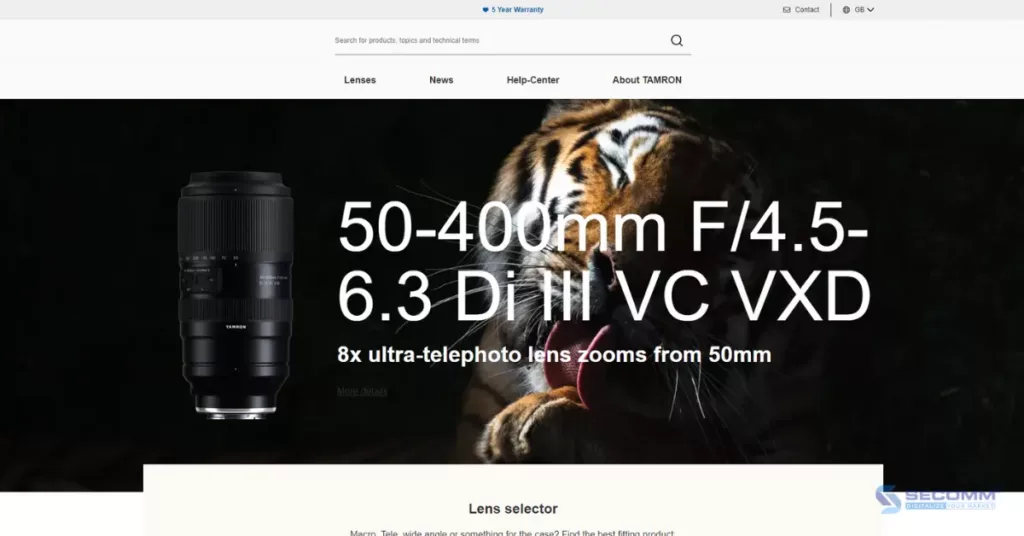
As part of their strategy to explore new markets, the company embraced Headless eCommerce through the utilization of commercetools on their subsidiary’s online store in Europe, operating under the name Tamron Europe and based in Germany. The beauty of Headless eCommerce lies in its ability to decouple the user interface (frontend) from the underlying data storage (backend), allowing Tamron Europe to construct and personalize their online store to meet both present and future requirements.
With over 2 million mattresses sold and revenue exceeding 645 million euros in 2021, Emma The Sleep Company has become one of the fastest-growing sleep brands in the world.

Emma chose to partner with commercetools to develop a large-scale eCommerce platform to accommodate high traffic volumes. To encourage customer shopping on the website, the company introduced various attractive sales policies such as 0% financing, free shipping, free returns, and a 365-day trial period. Additionally, Emma’s eCommerce website is integrated with Instagram to interact more with customers by encouraging them to share images of their product experiences and tag Emma. As a result, the brand has attracted a considerable number of potential customers.
John Lewis & Partners (formerly known as John Lewis) is a renowned British retail brand with a rich history spanning over 150 years. The brand has utilized commercetools to aim towards the goal of transitioning from its legacy eCommerce platform to a microservices-led cloud service and flexible API-first approach.

The new John Lewis website offers a wide range of high-quality products, including clothing, household appliances, electronics, and beauty products. John Lewis provides a seamless shopping experience from offline stores to the app and eCommerce website. Through quality products, excellent customer care, and optimized payment policies, John Lewis has gradually established itself as a leading and trustworthy retail brand in the United Kingdom, catering to the diverse multi-channel shopping experiences of its customers.
Kmart is a renowned discount retail store chain in Australia, founded in 1969. To date, Kmart has over 200 stores across Australia and New Zealand, recognized as one of the most profitable discount retail chains in the land down under.
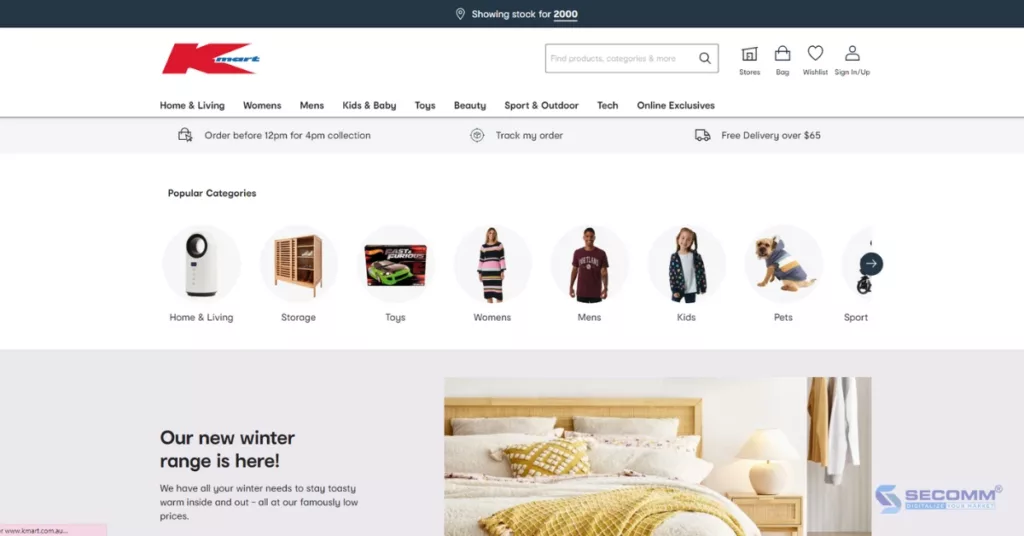
Kmart has undergone a transformation to a cloud-based platform – commercetools, leveraging serverless capabilities with a microservices architecture. By embracing this new technology, Kmart can flexibly customize and expand its eCommerce website to provide the best online shopping experience for customers, while also driving its digital transformation strategy.
Express is one of the world’s most renowned fashion brands, specializing in clothing and accessories for both men and women across various segments. Recognizing that the monolithic platform posed challenges to its growth, Express turned to Commercetools for a flexible, agile, and highly scalable eCommerce solution to adapt to market trends and the ever-changing shopping preferences of customers.

With a focus on stylish fashion products, Express’s website is designed with a minimalist yet modern and elegant aesthetic. Alongside a diverse range of promotional programs, Express offers customers multiple payment solutions to enhance their shopping experience, such as Buy Now, Pay Later (BNPL), Buy Online, Pick Up In Store (BOPIS), and Express credit card.
Above are 10 businesses that have developed eCommerce websites with commercetools and achieved success in both branding and revenue. This success has become a source of inspiration for other businesses seeking solutions to elevate their business operations and enhance their competitive edge in the market.
With extensive experience deploying eCommerce solutions for clients in various countries, SECOMM understands the difficulties and challenges that businesses face during the implementation process.
Contact SECOMM today or call our hotline number (02871089908) directly for a free consultation.
 2
2
 14,353
14,353
 0
0
 1
1Subscribe to get the latest eBook!
Hotline